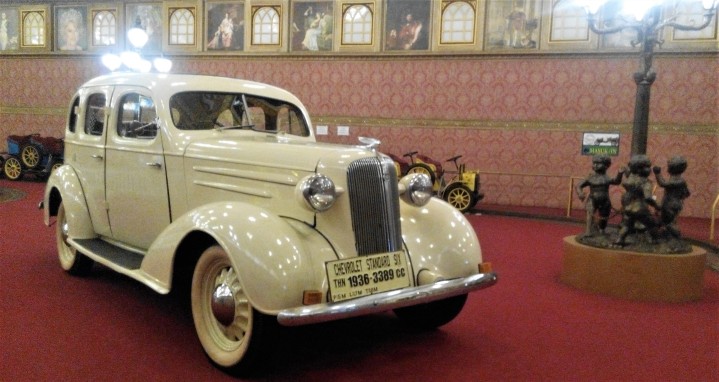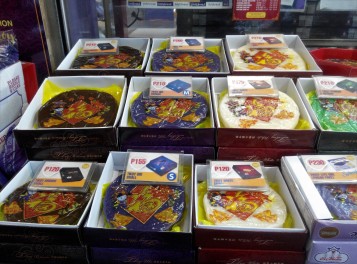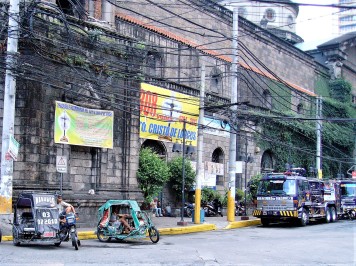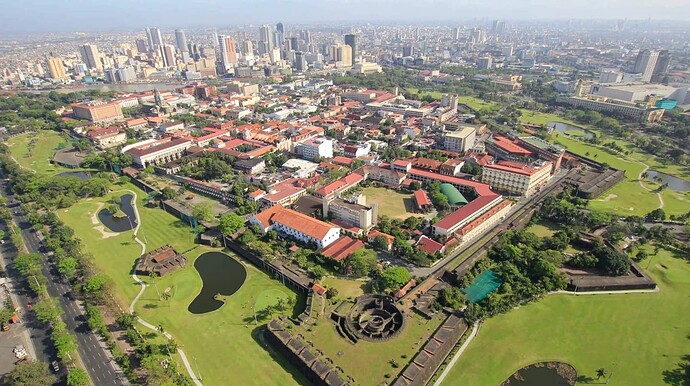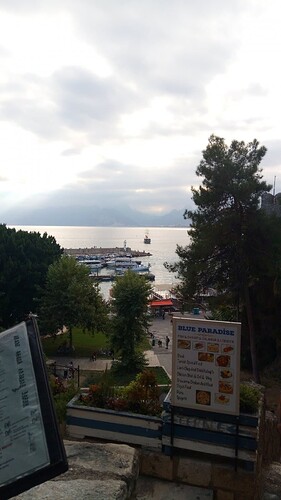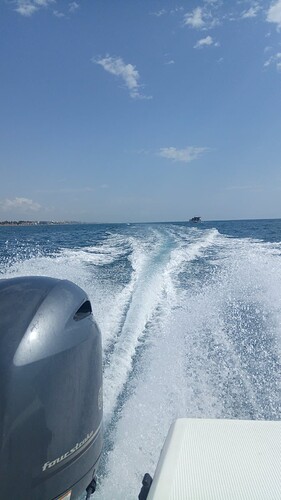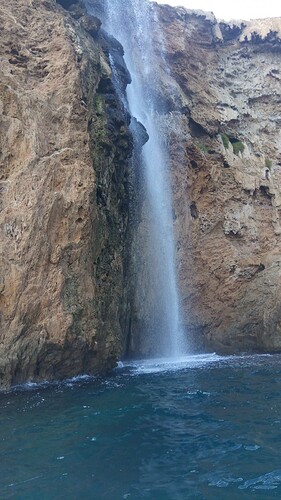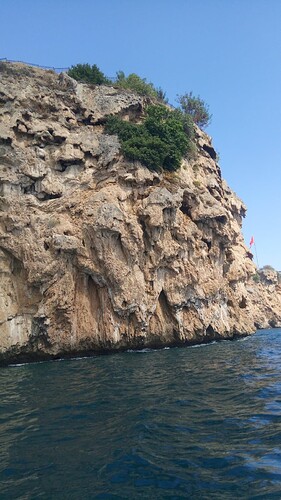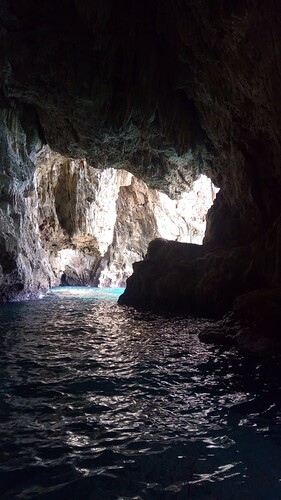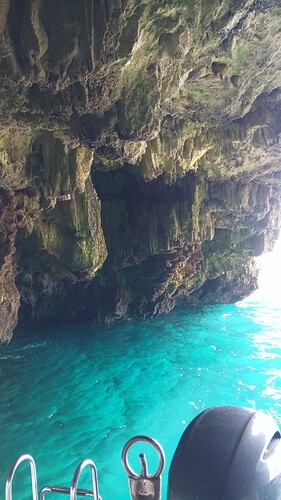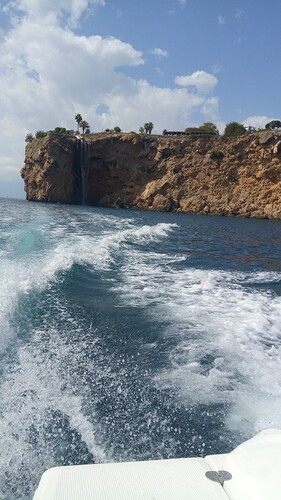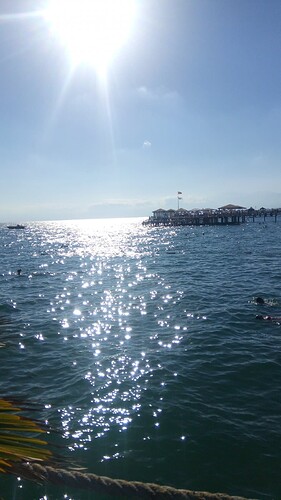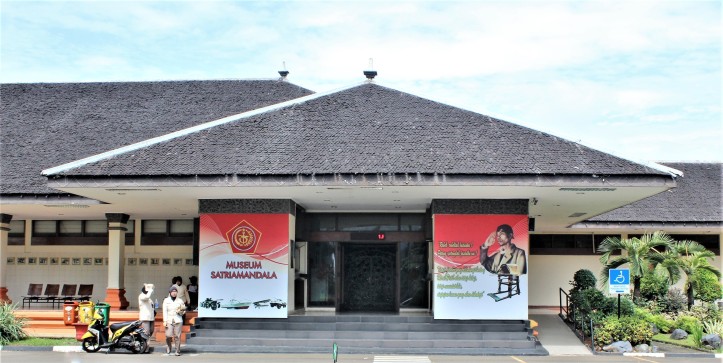![]()
This is my 4,000 words report on the March 2016 media trip to Surabayta, Probolinggo & Malang. As it’s too long, I’m breaking it up into several parts.
Here we go.
Part 3
An apple or more a day. Malang at a cool altitude of 476m is lower than Bandung’s 768m but it’s a comfortable enough respite from Surabaya’s hot stifling climate. Many varieties of fruits, the most famous being apples, are grown in the mid hills a short distance from the town area. Over a hundred big and small orchards raise this produce as their main or even sole crop.
What else but apple stalls lining the roadsides? 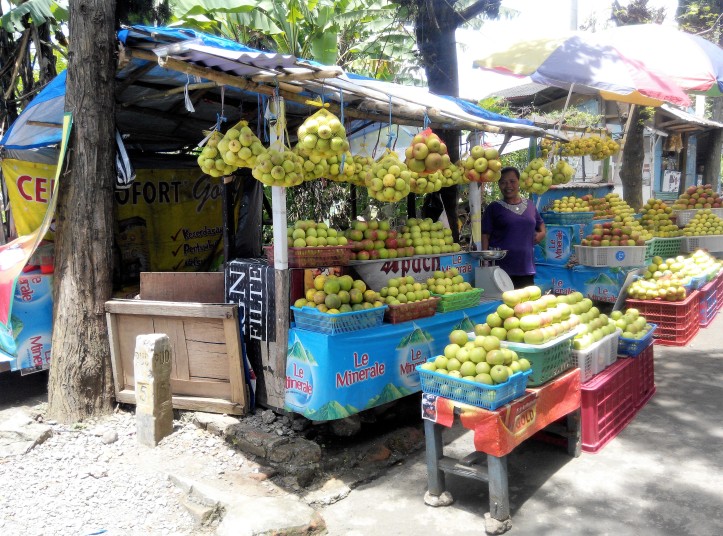
Apples in her eyes. One of the ladies in our group having a spot of fun. Pic courtesy of Alam
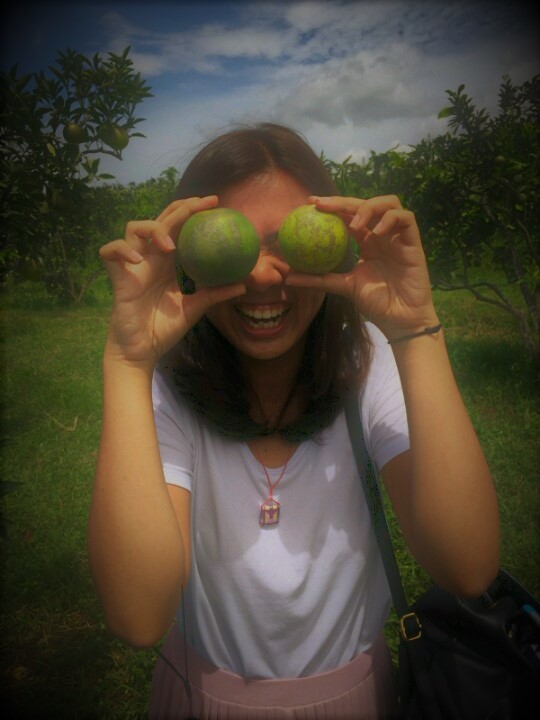
The largest of the bigger plantations is Kusuma Argo Wisata that grows not just apples but also, guavas, papayas, strawberries and a few others. This sprawling property is also an agrotourism destination with its resort hotel, convention centre and waterpark catering to a wide section of holiday makers. Besides the standard Indo fare, the restaurant there serves a selection of what else but apple-based cuisines, namely; Apple Beef Steak, Apple Chicken Steak, Mie Sarang Apel and Apple Fried Rice. Order a glass or two of fresh-from-the-trees apple juice to wash it all down.
Rows of young still-growing apple trees under the azure sky with puffy interspersing clouds. 
For the kids in everybody after the treks through the vast plantation. 
Angkut Museum/Movie Star Studio/ D’Topeng Kingdom Museum. Not far from the apple farms, at 15km west of Malang City centre, is a transportation museum billed as the largest of its kind in Asia. The blurb says transportation but aside from a few ship models, it’s overwhelming cars & bikes. Well, there’s an old train and a downscaled but still imposingly huge Apollo moon rocket replica. A commendable construct but sadly, to an aerospace enthusiast’s eyes, the proportion is somewhat off…I’m nitpicking though as the general public will not be able to discern the inconsequential imperfection.
What I am more attracted to is the sole aeroplane which rests on the rooftop. This particular example is a retired early dash200 “Jurassic” series of the venerable Boeing 737 jetliner which first took to the skies in the mid 1960s, and in its latest iteration of the 737MAX fourth generation family, is set to continue being built up to 2026 and beyond.
A clear look up at the 737 (minus right-wing engine) from outside the museum. Of note is the air traffic control tower mockup behind the jetliner which sports the now-uncommon red & white checkerboard paint scheme heavily favored by the military from the WWII period. M.O. 
Scale models of a Chinese Junk, a ship of the Majapahit Empire and the RMS Titanic.
We all know the last mentioned vessel lost an argument with an iceberg on her maiden voyage but few are aware that only three of her four funnels were actually functional. The last is a fake, a dummy added in to improve the ship’s looks. Talk about vanity, lol! 


Automobile aficionados, especially of the vintage era, would be find themselves in seventh heaven at the sight of the hundred or so cars and motorbikes. Kids and the Peter Pans among us would also love them. It’s a sumptuous feast for the Realm of the Senses alright. The longest ride on display is a Hummer stretch limousine capable of ferrying 18 valued passengers in over-the-top luxury along its over five metre length.
No bummer, its a s-t-r-e-t-c-h-e-d Hummer.
Other than the plethora of the real McCoys, the make-believe movie world is also represented; such as the Batmobile and a sofa car from a spy movie. Phew, as an acquaintance would say; “it’s car porn”. And going backwards in timeline, the collection includes handcarts, rickshaws, horse-drawn carriages, unicycles, bicycles, tricycles and even a quadracycle. How about coal-fired, steam-powered bikes & trikes? You can bet on them being part of the ensemble as well.
Hulk smash! The jolly green giant zealously guarding his stomping ground is fittingly constructed mainly from scrapped car parts. 
Holy Toledo! Bruce Wayne’s alter ego would have approved of this fantasy-on-wheels. 
This ornate predecessor of the automobile is driven by flesh, bones & blood engines of two horsepower. 
The sons of the soil’s dependable “green” mode of transportation. 
And then there’s also pedal power. According to a nearby signage, riding – even just to pose for the camera – is not allowed but that didn’t deter this visitor (her initial hesitation dissolved by my naughty encouragement) from trying out the strange contraption.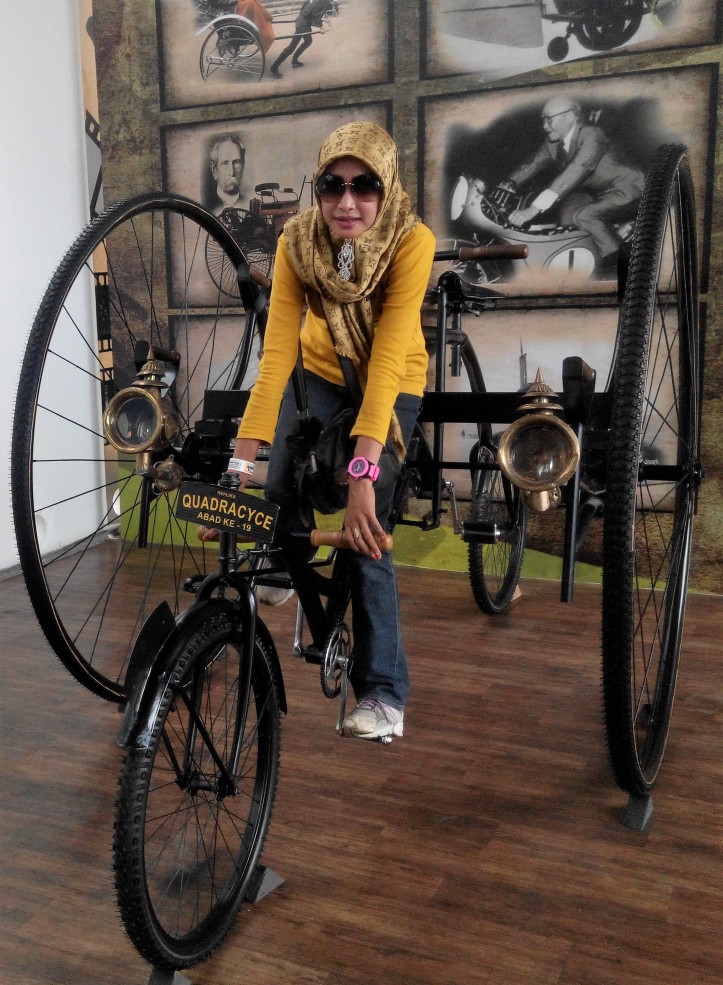
A vintage motorcycle with a single cylinder engine. Getting it started is presumably via the pedals. 
Vintage four-wheeler in pristine condition. 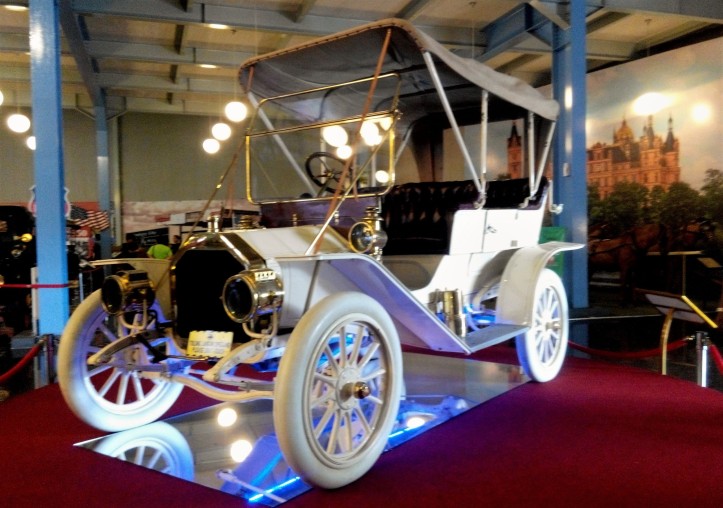
An early convertible. 
A forerunner of the pickup truck? 
A hot racer. 
Ford Thunderbird of the mid sixties, the fourth generation descendant from its 1950s progenitor. 
Ford’s personal luxury coupe of the early seventies with 7,500cc V8 engine. Road tax? Ouch! 
Way “mini-er” than the famed Morris Mini, and with a really miniscule engine of around 200cc, the Heinkel Kabine microcar (1.32 metre high and weighing in at 40% of the Mini) predates the distinguished British icon by a few years but its total production runs sadly did not last long. 
Next comes the Universal Studios-esque Movie Star Studio where buildings, street scenes, vehicles and other props were painstakingly recreated. There’s Buckingham Palace, Hollywood theatres & cinemas, old Chinatown, major cities of America, Asia & Europe, and a Gangster Town reminiscent of the Bugsy Malone and Al Capone world of crime.
Here we go, ambling down the ramp into old Chinatown.
Bonnie and Clyde would surely feel at home here.
Some of the bygone rides in Gangster Town.

A pickup truck in the same era. 
On the streets of London…… 
Rolls Royce limousines on display inside “Buckingham Palace”.

Some ladies relaxing outside “Buckingham Palace”. 
Time to try to strike it rich?..…No, thank you! 
to be continued… …
This is my 4,000 words report on the March 2016 media trip to Surabaya, Probolinggo & Malang. As it’s too long, I’ve broken it up into several parts.
Here we go.
Part 4
Last, and maybe least of this three-in-one attraction is the D’Topeng Kingdom Museum. That being said, history buffs might beg to defer and would certainly enjoy the comprehensive collection of traditional masks & textiles, sculptures, decorative knick knacks, and other cultural art objects from all over the Indonesian archipelago.
An info board inside D’Topeng briefly tracing the early interaction between China and Indonesia. 
Ah, lest I forget, Kampung Apung near the exit/entrance depicts a floating market and street stalls selling souvenirs and food & drinks for the hungry & thirsty after the long look at the displays in this large compound.
Birdseye view of Kampong Apung. At the right & top third of the picture, against the washed-out sky, jutted the approximately 1/5th high model of the original 363ft tall monstrous Apollo moon rocket; Saturn V. Right on the extreme top right-hand corner, the real-life decommissioned 737 passenger jet sat on top of the building that housed the transportation exhibits.
Back to the Entrance. No, we didn’t do an encore. That was the beginning, brought to the end just for the heck of it. 
Stays. For the four nights of our stay, we were parked at three different hotels. The first, in Surabaya, was a late night check-in and an early morning departure affair so we did not get to appreciate its service and amenities other than a shower and a knocked out snooze in a comfortable bed. The second was at a basic mid-mountain no-star lodge-esque stopover where we hardly have time for a two hour or so shuteye, setting off to the mountain top at the unholy hour of three in the morning.
However, our final two nights accord us the opportunity to really partake in the warm Javanese hospitality of a nice international class hotel. Horison Ultima Hotel Malang, at merely six km from the town square, is a luxurious retreat with pleasant view in a quiet neighborhood that boasts all the trappings of modern conveniences. Clean well-kept rooms, wifi, spa, gym, swimming pool, multiple dinning outlets, attentive & responsive staff and a shopping mall a stone throw away – what you would expect in a top hotel in major cities like Jakarta except for a very one important factor it couldn’t match; price level. It’s much lower than in the capital for an equivalent facility.
That’s extremely good value, good for a longer stay and the cooler climate is certainly a bonus. Service is exemplary, with the little issue of wifi connectivity attended to and solved in a jiffy. My reading glasses left in the lobby in a rare moment of forgetfulness in the early morning was retrieved at the counter late evening after a long day’s outing. The front office crew had found it lying around and safe kept it well. The breakfast spread, a mix of local and international fare was as nice as such buffets go. Dinner at a cozy second level corner was also very palatable, with good ambiance and a live band belting out a string of classic and contemporary beats.
Other eats and bits. What is a travel article without more brief mentions of food, glorious food? Generally the cuisine we sampled are fine, with two standout restaurants more worth talking about in this limited (by self-imposed) space. They are Waroeng Bamboe Sidomeoljo and Taman Indie Resto on the far and near outskirts of Malang respectively. As the name hinted at, the former is a rustic bamboo edifice where the diners sit on the ground at low tables surrounding fish ponds. The dishes are chiefly of – no prizes for guessing correctly – fishes but they are delicious, along with the great ambience. Our last dinner was at the more upmarket abovementioned Taman where the sumptuous combination platter of local fare was accompanied by live performances of traditional Javanese dance and later, music and songs.
Dishes of fish, more fish, extra fish and excess fish done in a wide variety of ways. They are all delectably cooked but there’s always too much of a good thing as evidenced by the plentiful leftovers. We all tried not to be wasteful, honest, but there’s only so much we can stomach. Burppp! 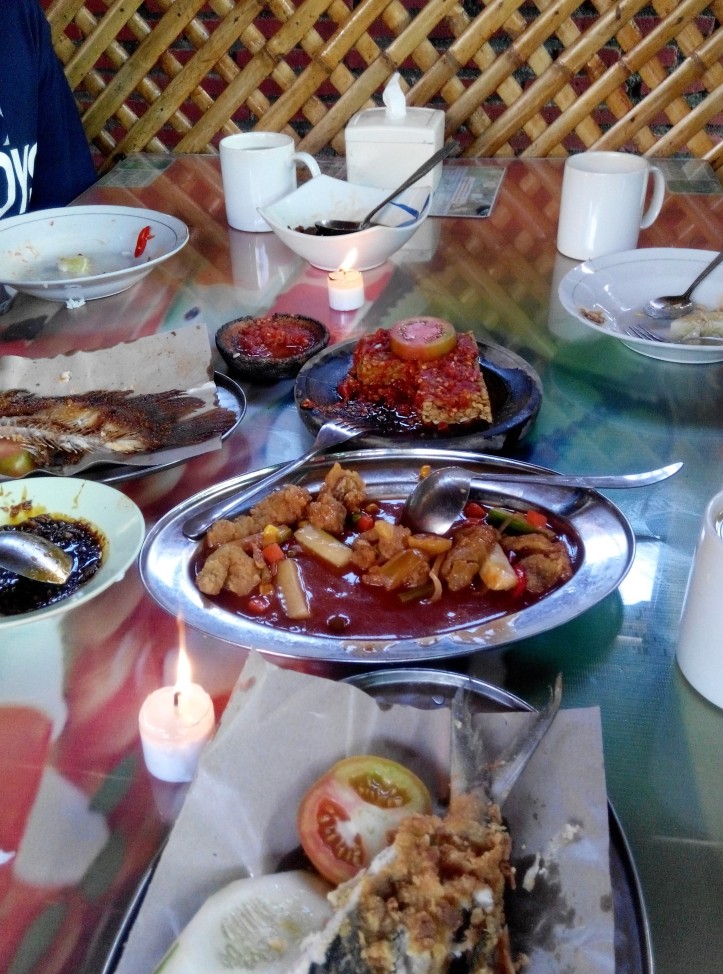
Our last supper 
……while being entertained to a traditional dance by a bevy of beauties. 
Both ubiquitous bakmi (noodle soup with meat) and bakso occupy the top places in the pantheon of Indo street grub that can be found in virtually all nooks and corners of every cities, towns and villages. Malang is no exception, more so the latter where it boasts its own variant called Bakso Malang. The beef balls in the latter come in two sizes; 2.5cm and a hefty mouth-stretching golfball sized 5cm. Go on, have a ball.
Sneaked shot of picture-shy stall owner by his Bakso Malang street cart.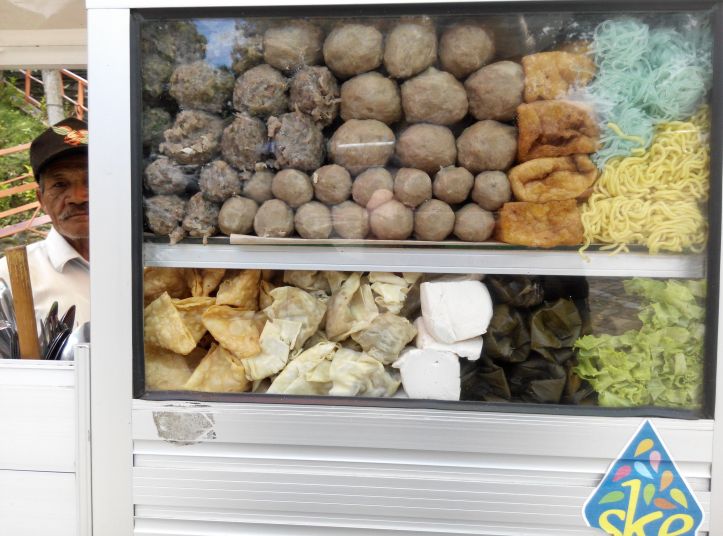
What to bring home to family & friends? How about some easy-to-carry Malang specialty? There are lots of options but apple products would be appropriate since the city is Indonesia’s top producer of Newton’s renowned inspiration, his Eureka! moment. So we load up with boxes of apple strudel from a sweets chain named Malang Strudel. There are currently six outlets across the city though it was started only a year ago. That it grows so fast is not only from its fine products range but also to the pulling power of the man who helm it: Teuku Wisnu, a popular TV personality. https://translate.google.com.sg/translate?hl=en&sl=id&u=https://malangstrudel.com/&prev=search
(Bearded) Teuku Wisnu with some staff and customers (not our media group). M.O. 
Every self-respecting Indo town possesses their own Alun-alun; a set of two open fields or squares in or around the town centre where all sorts of events are held. Malang’s examples are no exception, with people converging on them round the clock, even just for casual meet-ups. Its a nice place to head to with time on hand to observe and immerse in the culture of the locals.
Sand & sea lovers are not left out as there are three beautiful beaches close together in Malang: Balekambang, Ngliyep and Sendang Biru, often referred to collectively as just Balekambang.
Malang Airport is a small operation catering solely to domestic flights serving Jakarta and a tiny handful of other cities. Only Surabaya Airport, the nearest international airhub at 100km by road is the lone option for a fast direct ride back to home. For us on this particular occasion, the organizers had the best of intentions in arranging for the Singapore group to do two sectors; the domestic Malang-Jakarta leg, and then transition from the capital to the Little Red Dot for the second flight. Though the costs would surely be higher, they did that to spare us the hassle of bussing to Surabaya Airport for the direct flight home as the total journey time would be just about the same. In the end, as recounted in the epilogue below, it turned out Man proposes, Heaven disposes. As they say; C’est la vie!
Finally on the flight back home from Jakarta. This newish Garuda 737-800NG features the latest Dreamlineresque Boeing Sky Interior with pleasing LED mood lighting and ergonomic pivoting overhead baggage compartments.
A much needed massage for Pak Alam, our trip leader who took care of the nitty gritties and went through much sh!t to get us home safely on the last Garuda flight of the night. Pic courtesy of Annie.
to be continued… …
This is my 4,000 words report on the March 2016 media trip to Surabaya, Probolinggo & Malang. As it’s too long, I’ve broken it up into several parts.
Here we go.
Part 5
An epilogue, sort of:
A few weeks later, towards the end of April, our group was treated to a sumptuous lunch at the Indo Chilli Restaurant in Zion Road, hosted by Garuda Indonesia’s Vice-President for South East Asia and his immediate staff. That was a nice corporate gesture to make up for some inconveniences “suffered” on our homebound trip. What was supposed to be a straightforward two-legged morning flight from Malang Airport to Singapore via a Jakarta transfer turned into a whole afternoon of clueless waiting, an arduous road journey to Surabaya and then extended delays in the passenger holding area of Surabaya Airport, to arrive on home soil at almost midnight.
Actually what triggered off the unpleasant hold-ups was an act of nature (Mount Bromo suddenly spewing forth effusive levels of ashes) precipitating air safety measures that the airline adhere strictly to after we had completed all departure formalities and were already at the airbridge gate. That in itself is understandable and accepted. The poorly executed remedial follow-ups were what resulted in a sad comedy of misjudgment and poor recovery actions.
The Malaysian component parties in our extended group were fortunately put on a later flight to Jakarta whilst our Singapore team was inexplicably whisked off, after some behind the scene complications, in a coach whose inadequate air-conditioning system left the whole load of the affected cancelled flight passengers to be at the mercy of a really hot early mid-afternoon sun. The uncomfortable road journey was further exacerbated by numerous pockets of bad stop-start traffic conditions along the way, further raising temperatures in both the bus and human bodies.
The ground staff’s service was pathetically poor, including supplying everybody with just a rudimentary bread and bottled water for lunch. Still, not a murmur – not yet anyway – from the one and a half score or so of combined passengers of both final destination and transit travelers bound for Jakarta. There were more people than that put on the road to the alternative airport as I had noticed at least another two similarly packed coaches.
After reaching Surabaya Airport, the by-then weary men, women and children were further hit with hours more of awaiting their turns to board as the scheduled flights were obviously of insufficient capacities to take on the increased numbers. As such, by evening, tempers were flared and service counters were angrily pounded on by a vociferous few who took up the cudgel, so to speak. Babies and young kids were crying, many from hunger and fatigue. After a long while, with serious heckling by a growingly impatient crowd, some meal carts were trotted out.
Measured sighs of relief were replaced by incensed groans as all that was laid out were more of the same uninspiring bread and water. The self-anoited “gang leaders” then forbade all their fellow sufferers to touch the meager offerings, insisting on at least a simple but square meal of rice with basic condiments, plus some juice or soda. Finally, after loads of heavy pressure from a starving potential mob, a more senior airline official was (not gently) persuaded to open up the premium class corner refreshment centre to one and all. He was visibly reluctant to do so but he had no other choice in the face of a possible uncontrollable riot. Phew, an ugly scene nipped in the bud, forestalling uglier escalations.
Still, all said and done, there’s a little redeeming factor for the ground representatives in the end. Possibly because of eventual realization of their oversight in taking reasonable care of their displaced customers, and maybe also placate simmering dissatisfaction, each affected passenger was handed an envelope upon finally boarding for Jakarta. The cash payout within is not much but it’s the thought that counts, as the crowd seemed to grudgingly agree. Regardless of whether it was meant to be a token of apology or compensation, it was certainly reactionary damage control that though late was better than never.
So, kudos to the management of Garuda in Singapore for the generous show of goodwill that spoke volumes. They also expressed their appreciation of our feedback to improve their ground support staff’s training on service standards more befitting that of a lauded 5-star airline that is Garuda Indonesia. Viva!
A fine selection of the Indonesian cuisine we were feted to, and one of the soon- to-be-satiated guys showing off his “catch”. Pics by Indonesian Embassy photographer.
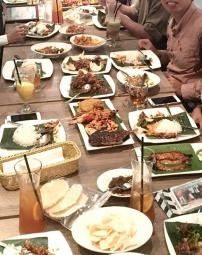
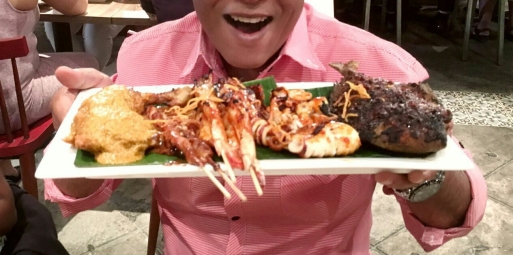
That’s the concluding part of the series on my media trip to the "Surabaya-Probolinggo-Malang “triangle” This is a route less travelled and is a viable alternative, or if time permits, a nice complement to the overly popular Bali destination.
It has an abundance of history, culture, cuisine and the sun, the sand & the sea, with the advantage of less crowd.
Solo travellers, with a little spare time and fingerwork on the keyboard can tailor the route, transportation and accomodation to his/her liking/convenience. Only the ascend to view Mt Bromo at dawn need more merticulous planning. A local Surabaya or Malang travel agency could be an option to hook up with a group for that one night adventure, or go direct to the starting point or even midpoint of, say Mount Penanjakan, and hunt around for a last minute spare vacancy in such groups. It’s eminently possible and I’m not averse to opting for the latter but wouldn’t recommend it for non-seasoned travellers.
In any case, the usual caveat emptor.
The end … … … and coming soon, a bit on Manila from my archives.
This is a recount from one of my numerous trips (lost count, but probably about 90 times and accumulatively more than 2 years’ stay) to The Philippines since the late 1970s. As before, I’m breaking it up into several parts.
Here we go.
Part 1
PhotoWorld Asia 2017, PAF Museum & Manila Chinatown

It’s that time of the year again for my annual appearance as self-invited VIP in the long-running photo fair, exhibition, convention, workshop & seminar. My first time at the event was in 1995 when it was known as PhotoWorld Manila. After skipping it for about a decade, I have been there continuously without break for the past fourteen editions; which I have reasons to believe is a (mundane) record, for what it’s worth, for a foreign visitor.
As the Official Opening is perennially set on the last Thursday of January, I was always able to avail myself of cut-price deals on no-frills LCCs or Low Cost Carriers. Currently there are three (indigenous CebuPacific and Singapore-based TigerAir [since then renamed Scoot] & JetStar Asia) operating around a total of eight direct daily flights from SG to Manila and vice versa. For those who want to be pampered with more bells & whistles, the two legacy carriers of Singapore Airlines and Philippine Airlines have another eight scheduled, with prices starting from above SGD200 (approx. USD140) during occasional promotion periods. Their usual fares ranged around USD300-400.
My bookings were made variously between three and ten months in advance with all-inclusive return fares ranging from SGD90 to 140 (USD64-100). For 2017, because Lunar New Year falls on Saturday, I headed home the night after the Opening which is LNY eve. A longtime professional photographer friend, Charlie Lim who is also a very frequent visitor and sometimes speaker was scheduled to present his masterclass on “Light Paintography” on Saturday afternoon, which I obviously had to miss.
The exhibition venue at the Glorietta Mall in the Ayala Center, Makati. 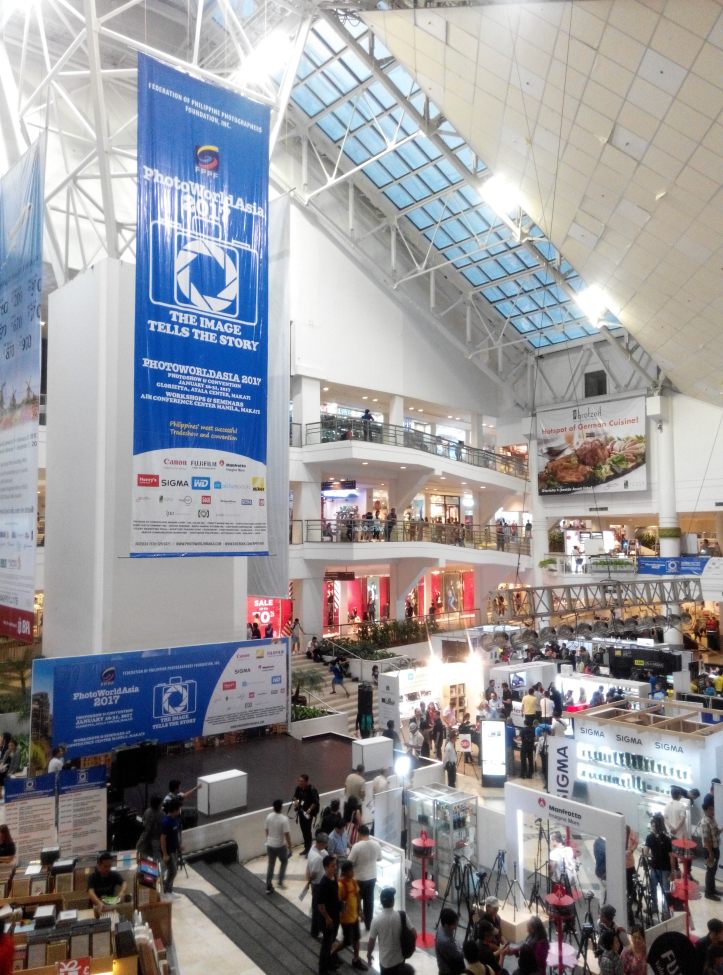
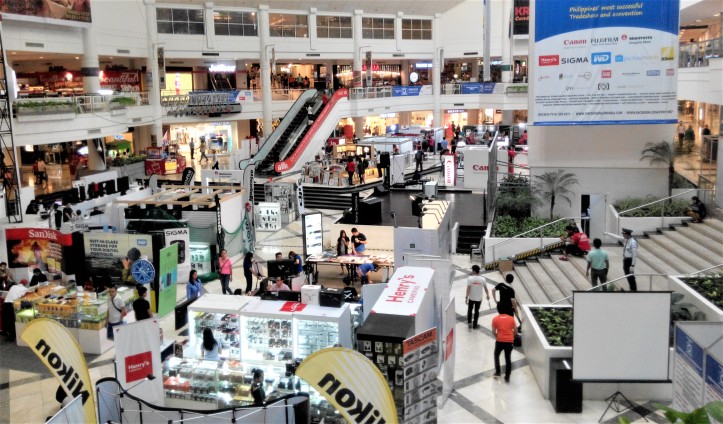
I first met the originator and prime mover of the yearly photographic showcase in 1992 at Photokina in Cologne, Germany when she was there seeking support for her upcoming major project. Mrs Eduviges Huang who had previously graduated from the Brooks Institute of Photography (name shortened to Brooks Institute from 2007) in the U.S., was then set to form the Federation of Philippine Photographers Foundation (FPPF) in 1993 which brings together 54 photo clubs and associations across the whole of the Philippines. FPPF Chairperson Mrs Huang’s lauded efforts towards getting individuals to be trained in art through photography predate PhotoWorld Manila/Asia.
It all began after the cataclysmic 1991 eruption of Mount Pinatubo when she organized a seminar on basic photography, aimed primarily towards helping the unfortunate victims. Though, as it turned out, none of the targeted people enrolled, enthusiasts from many walks of life did; overwhelmingly. They ranged from office types, doctors, engineers, teachers, priests, housewives, movie stars; professionals or otherwise.
Now at a still very energetic 74 of age, Edi as she is popularly known had and continues to, assiduously attend to the details of the annual gathering of trade industrialists and professional & hobbyist lensmen. What fueled her to keep at it through the ups and downs of the economy was, and still is the extreme satisfaction she derived from making the people at the exhibitions and conventions happy all through the past quarter century.
Numerous distinguished Guests of Honor had graced the Ribbon-cutting Ceremonies through the years; among them in recent times are 2014 Classic Mrs. Asia International Global Joyce Peñas Pilarsky and Batangas province Governor Vilma Santos. The latter, a former longest-reigning movie queen referred to as the Star for all Seasons, completed her third and final gubernatorial term in mid 2016 and is now a Member of the Philippine House of Representatives (equivalent to SG’s Member of Parliament) or Congress.
VIPs & Guest of Honor, Miss United Continents Philippines 2015 Anabel Tia, standing by for the 2017 Ribbon-cutting Ceremony. The lady in pink jacket at the front is Cynthia C. Lazo, a Director from the Department of Tourism, Philippines. 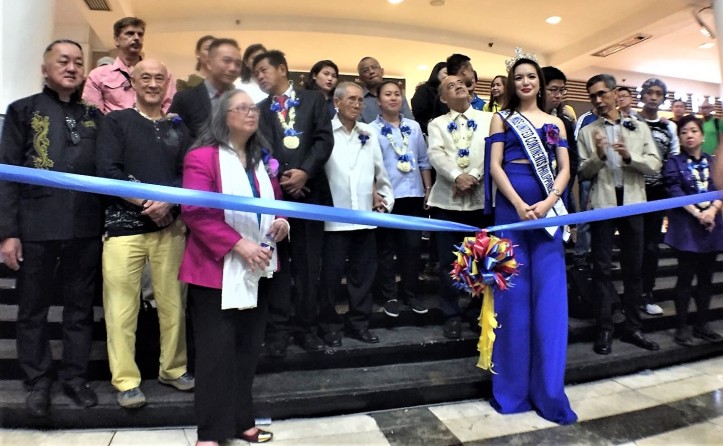
Miss Tia viewing and commenting on the winning entries at the photo exhibition.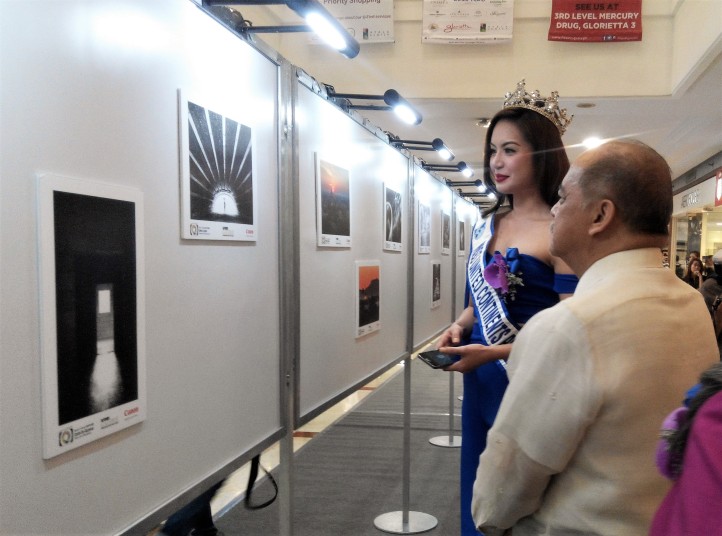
….and on stage listening attentively as the pair of crooning songbirds belt out their numbers. 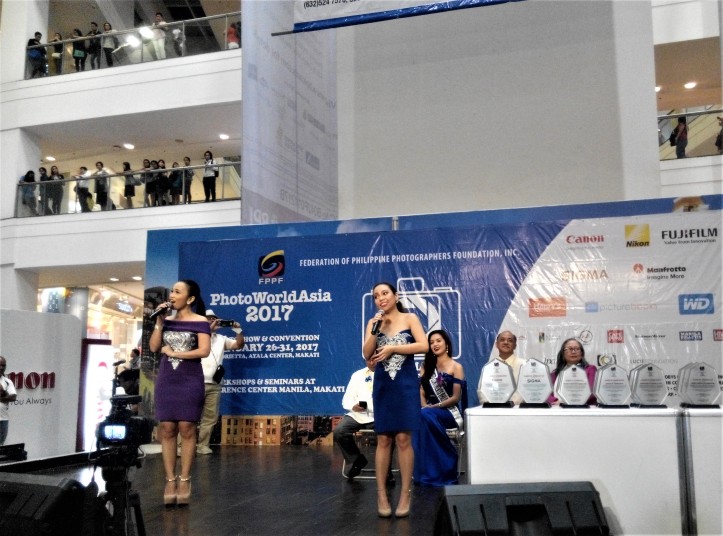
Meanwhile elsewhere on the exhibition floor, another pretty lady is all ready to hand out some sweet
desserts….errr, mundane product brochures.
Note: As a consequence of the Covid19 restrictions, I’ve missed the 2021 and 2022 editions which in the event were held chiefly online via Zoom.
to be continued… … Next up: The Philippine Air Force Aerospace Museum
This is a recount from one of my numerous trips (lost count, but probably about 90 times and accumulatively more than 2 years’ stay) to The Philippines since the late 1970s. As before, I’m breaking it up into several parts.
Here we go.
Part 2
PAF Museum. As was the case at the Bangkok Photo Fair eight weeks earlier as recounted in a previous post, I headed for an aviation museum the very next day. It was another visit that I had kept putting off going but since the ball had been rolled, I followed through, finally. The Philippine Air Force Aerospace Museum, initially founded as Marcos Museum (now that another Marcos in back in power, will the name revert back to its original?, I wonder) in May 1974, is located within the grounds of the Villamor Air Base (formerly known as Nichols Air Base) adjacent to Manila Airport’s Terminal 3.
Museum building of the Philippine Air Force inside Villamor Air Base. Nice.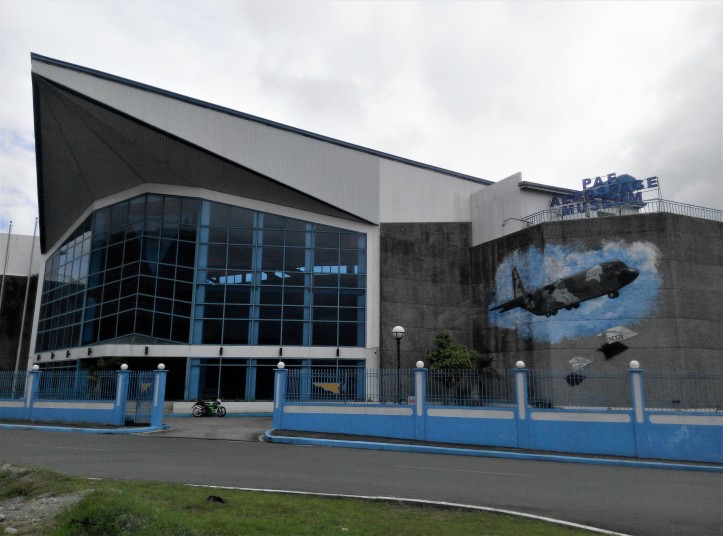
For those who welcome the option of getting there the low cost way, take a jeepney at 7 Pesos a pop (as with just about everything, prices has increased, to 11 peseo as of July 2022) from near the Taft MRT station. The frequent ubiquitous jeeps as indicated by its sides and on a little board on the windscreen that says “Nichols” will come out from under the buildings west of the foot of the overhead bridge from the MRT station in Pasay. It’s a short ride of less than 3 km.
There will usually be passengers disembarking at Terminal 3. Stay put and wait till the jeepney move on and turn left at the road bend, and then get off, a short distance away. To make sure, let the driver know you want to alight at Gate4 right after he continues from T3. (Fair use of Google maps & images here) 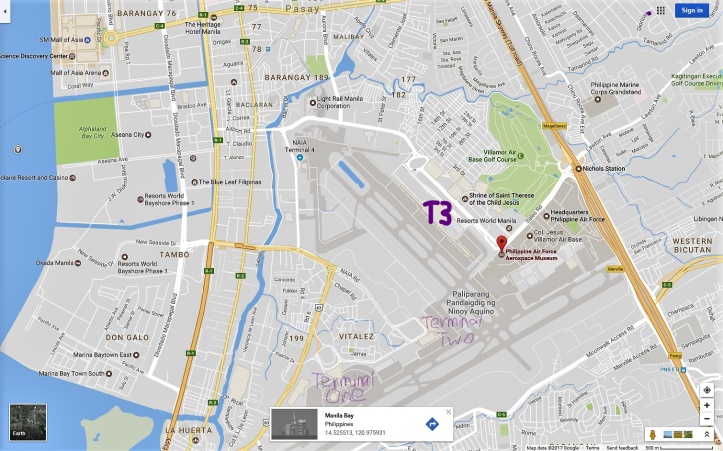
The museum is on the immediate right of Gate4 of Villamor Air Base. Just tell the guards you are going there and you will be let through without fuss. 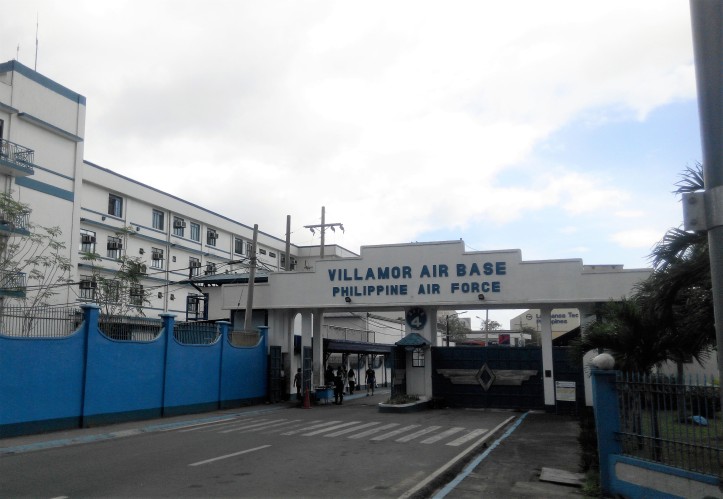
Coincidentally, on my visit, the museum proper was closed for renovations but that was no major issue as the aircraft park behind it is where most of the exhibits are situated. The grounds are well kept and so are the planes as evidenced by a group of workers repainting the Vought F-8 Crusader shipboard supersonic fighterjet, nicknamed “The Last of the Gunfighters”. There are a total of sixteen aircraft of various shapes and sizes, including three choppers. It is a nice venue for a picnic. The place also sometimes plays host to events such as weddings, social gatherings and baptism rites.
Google is again your friend. Here you go: 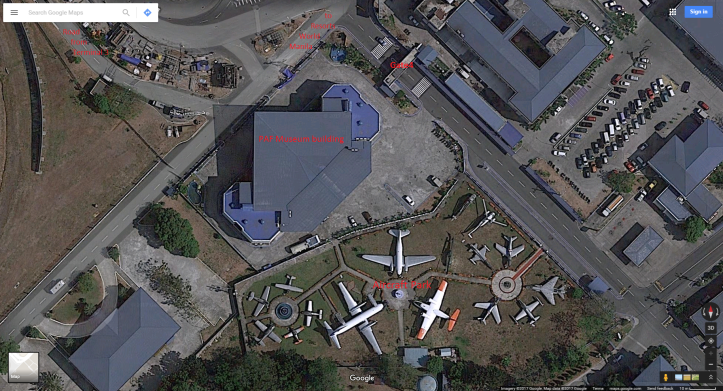
Through the blue-tinted glassed walls of the closed museum building, I spied half a dozen classic planes on the floor, and hanging from the roof. The most “modern” of these are a SIAI-Marchetti trainer (there is another one at the open display area) and the sole jet among them; the T-610 Super Pinto or T-610 Cali. A little older is a piston-engined WWII veteran, the North American P-51 Mustang. There are also two truly vintage biplanes, one of which is the Boeing-Stearman Model 75 primary trainer. There are sections inside the museum that showcase PAF’s heritage, aviation history & science & technology, as well as a function room and a mini cinema. I had no choice but to leave checking these out for another day when it reopens its doors to the public.
A group of school kids was having an excursion at the park when I arrived shortly before noon. Soon thereafter, they were ushered off by the teachers/guardians for lunch and were not seen again.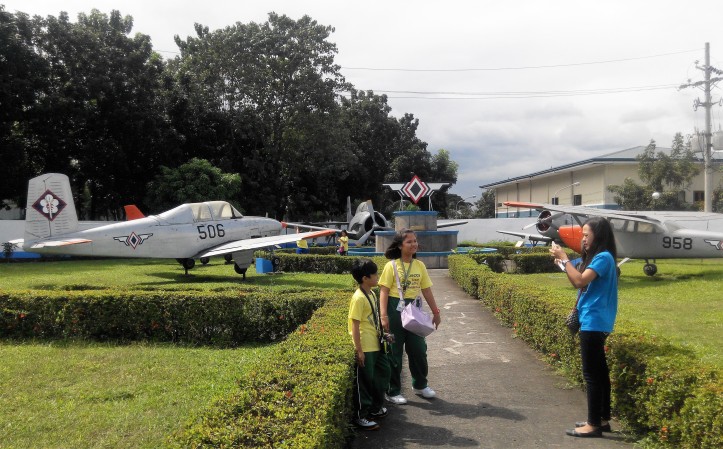
A statue of military aviator Colonel Jesus Antonio Villamor takes centre stage in the park. In 1982, Nichols Air Base was renamed to honor this fiercely patriotic and highly decorated war hero. 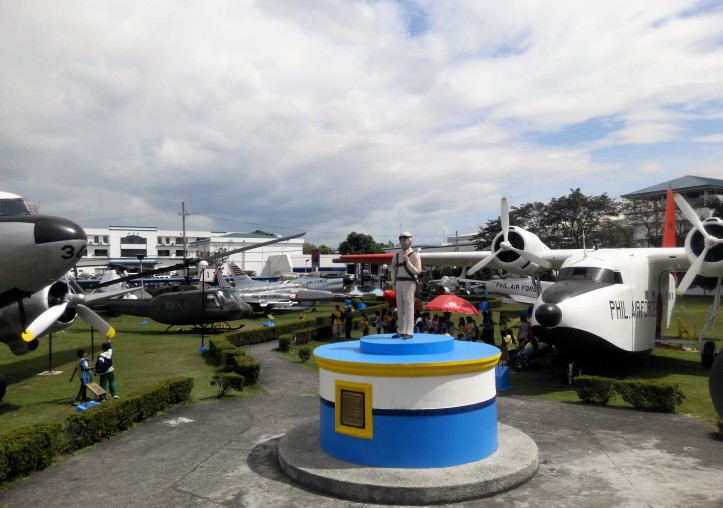
The Japanese NAMC YS-11A turboprop airliner holds fond memories for me as I had flown on it once; in 1979 from Legazpi City to Manila. There was no door to the cockpit, just a curtain. I remember seeing the captain arguing with the co-pilot and then whacking the latter on the back of the head. A stewardess thereupon hurriedly drew the curtain closed and went in, presumably to mediate. Hilarious if not for the safety implications. Anyway, this particular example below was used as VIP transport for the Philippines President and family from the early ‘70s to early ‘90s. 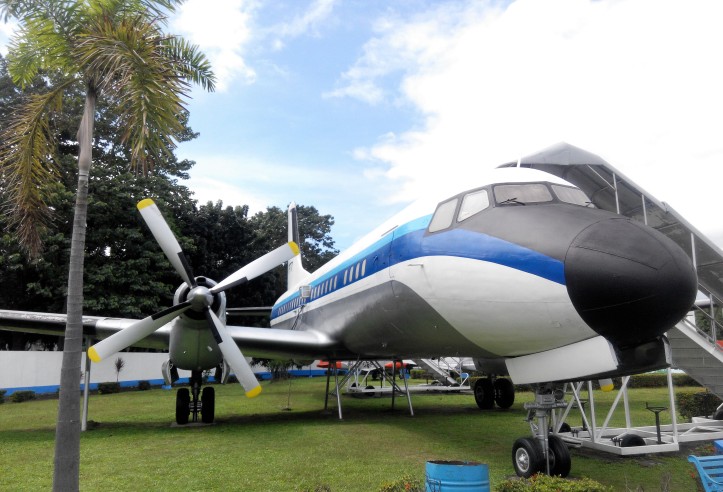
The Douglas C-47 military transporter is part of the DC-3 family of airliners, popularly referred to as the Dakota. First introduced in 1936, over 16,000 in total were eventually built and quite a handful is still flying to this day. 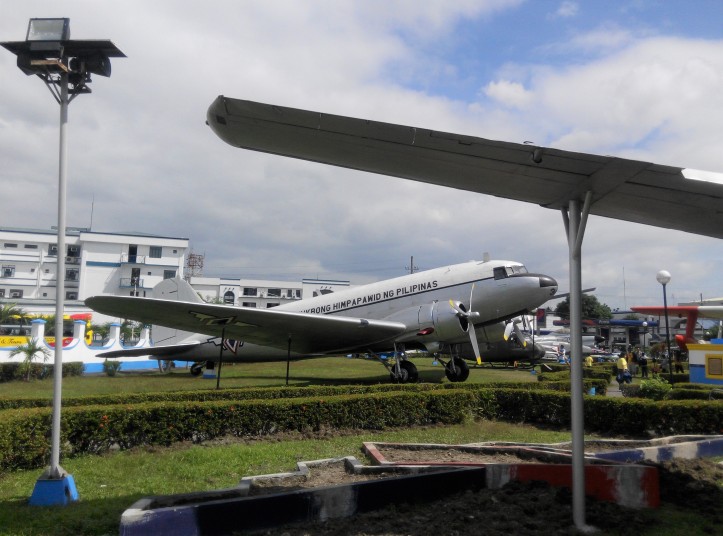
It flies, it swims, its an amphibian……the versatile Grumman HU-16 Albatross flying boat. 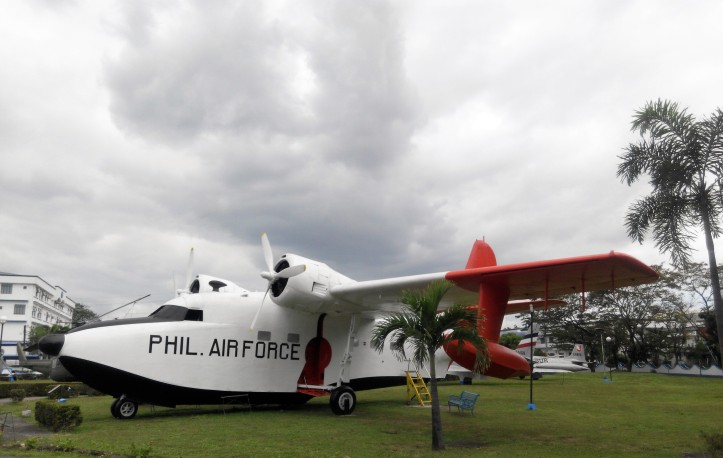
The prolific Bell UH-1H Iroquois, nicknamed Huey from its original designation of HU-1. Above 16,000 examples were built in its three decades of production beginning from the 1950s. 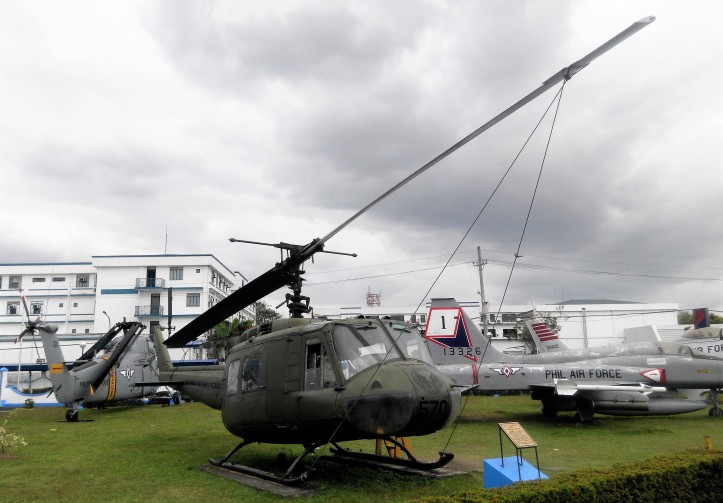
The unremarkable Sikorsky SB-62B/HH-52A Seaguard and its earlier, more illustrious stable mate S-58/H-34 Choctaw.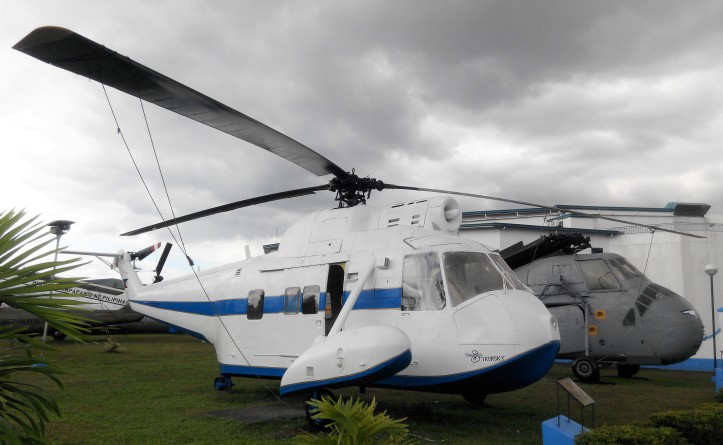
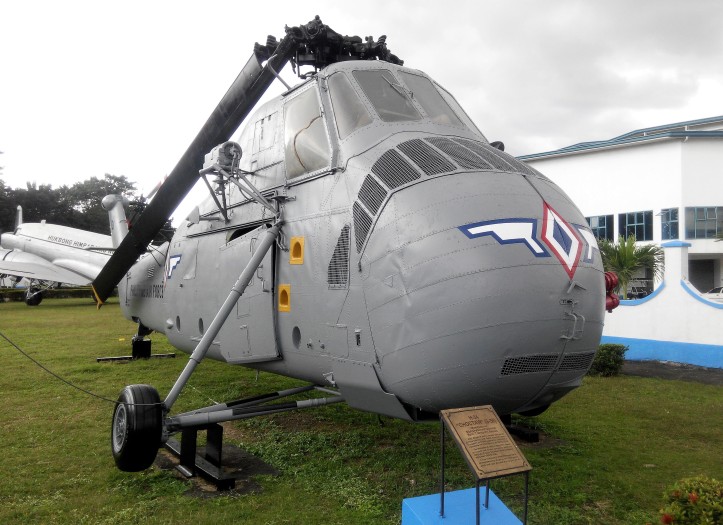
Vought F-8H Crusader undergoing repainting works. The fleet was permanently withdrawn from service in 1991 after being badly damaged by the Mount Pinatubo eruption. 
Northrop F-5A Freedom Fighter. An enduring design, it was the low cost supersonic fighter of the sixties and seventies. Cheap and good, eh? 
North American F-86F Sabre and F-86D Sabre. Nearly 10,000 frames of all F-86 versions were produced. They were all outwardly very identical except the all-weather D variant which shared only 25% commonality with the rest.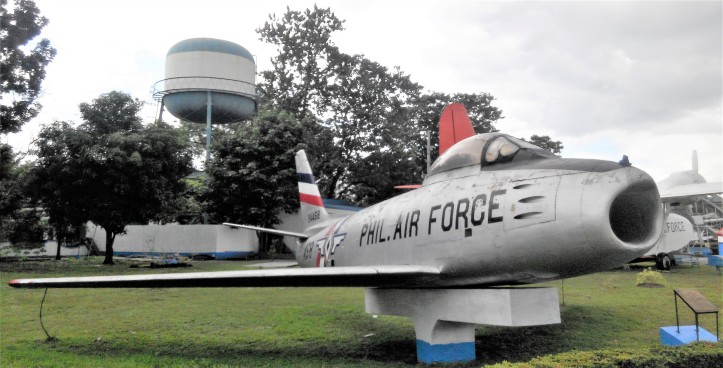
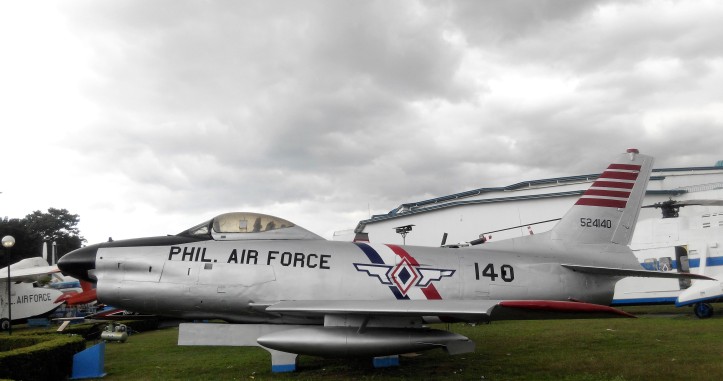
The Lockheed T-33 Shooting Star, developed from the very successful F-80 Shooting Star fighter, was the world’s most widely used jet trainer. 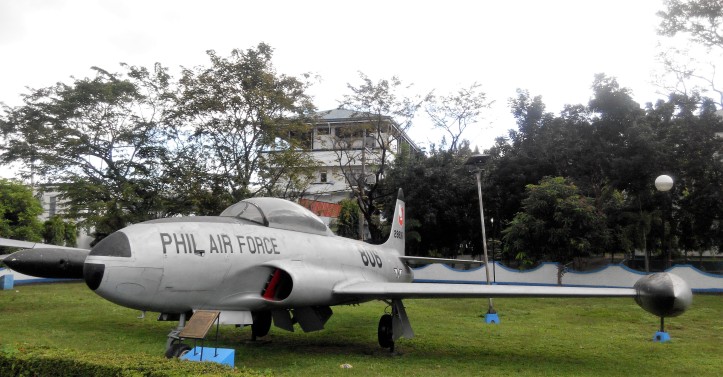
A foursome of prop trainers clockwise from top left: (1) Cessna T-41 Mescalero is the military trainer developed from the civilian Cessna 172 Skyhawk which is the most produced aircraft in the world at more than 43,000 units. (2)North American T-6 Texan. (3)Beechcraft T-34 Mentor. (4)North American T-28 Trojan.
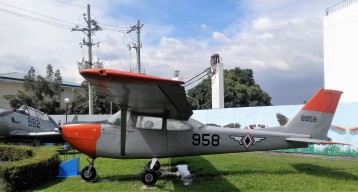
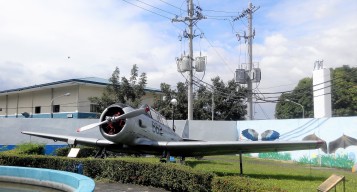
[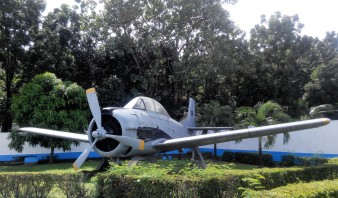 ]
]
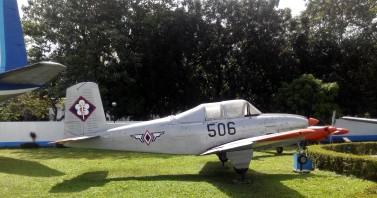
The North American P-51 Mustang is an immortal icon of WWII and the Korean War. It’s sitting proudly in all its restored glory in a nice newish building. Hanging behind it is the T-610 Cali. 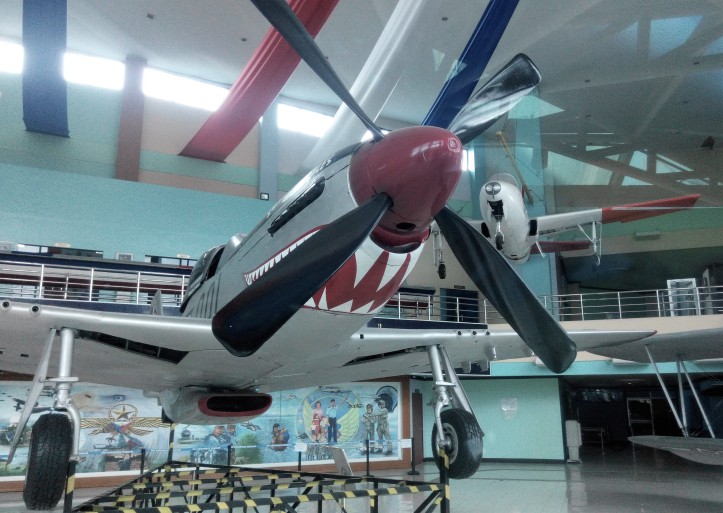
Over 10,000 of the Boeing-Stearman Model 75 primary trainer were rolled out from the factory floors in the 1930s to 1940s. After the Great War, they went on to serve in the agricultural, sports and aerobatics arena. It also became a popular performer in wing-walking at airshows. At the top left-hand corner is again the T-610 jet trainer and light attack fighter. This particular example had a not-simple background. It is the Filipino-built version of the prototype T-610 Super Pinto which was in turn developed and modified from the Temco TT-1 Pinto. That original Super Pinto prototype, numbered 233, was acquired, complete with technical drawings & production rights, to kick start a local aircraft manufacturing industry. It was subsequently lost in an evaluation flight which led to the termination of the industrialization program. That was almost forty years ago. Back to the Cali on display, it was initially numbered 234 but seemed like it has now adopted the 233 of the first unit, maybe in homage. 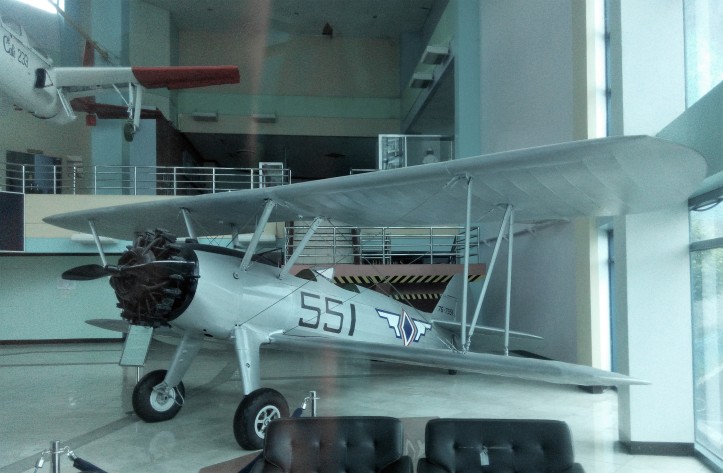
“Flying” above the SIAI-Marchetti SF-260 is what I surmise to be a replica of a Wright Brothers Flyer, possibly the third model. 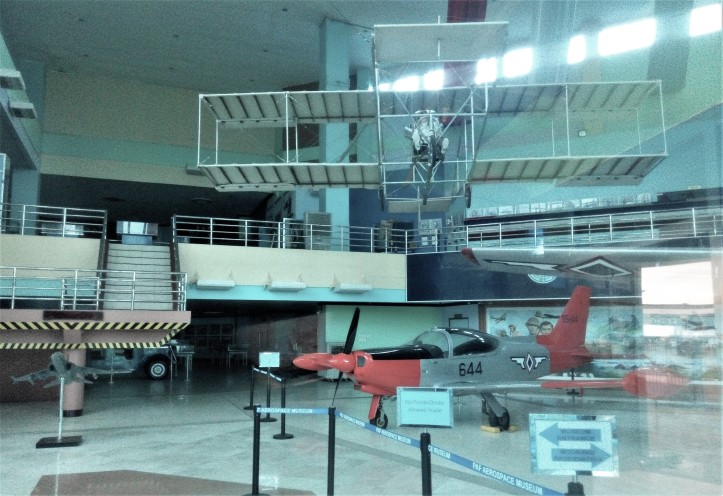
Across from and a little northeast of Gate4 is Resorts World Manila. It opened many months before its sister Resorts World Sentosa, and the latter’s new hires were sent to RWM for on-the-job training. Oh, by the way unlike our RWS (free entry for short-term foreign visitors but citizens and residents are accorded the privilege of lightening their pockets to the tune of SGD150 and SGD3,000 for 24 hours and one year respectively), there’s no entrance fee for both foreigners and locals. Just for fun and to while away the hours of a very early landing years ago, I registered for and received the free Membership Card. 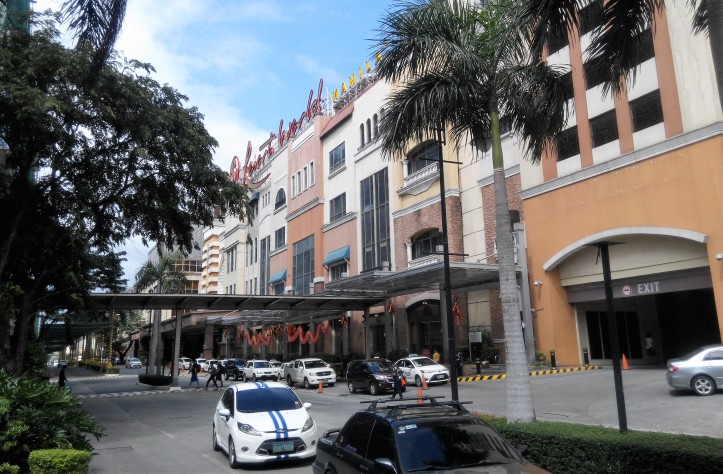
to be continued… … Next up: Manila Chinatown
This is a recount from one of my numerous trips (lost count, but probably about 90 times and accumulatively more than 2 years’ stay) to The Philippines since the late 1970s. As before, I’m breaking it up into several parts.
Here we go.
Part 3
Chinatown. The world’s oldest Chinatown is located in the Binondo District, with its beginnings in 1594. For a long time up to WWII and before the rise of the modern Makati City as the national financial powerhouse, one of its main streets, Escolta functioned as the commerce and finance centre of Manila, and by extension, the whole of the Philippines.
Dubbed the “Wall Street of the Philippines”, many banks and insurance companies still populate the stretch till this day. During the 1980s recession and debt crisis, it actually played a determining role in the disparate Peso-USD exchange rates that resulted from the massive currency black market. The subsequent involvement of moneyed Chinese-Filipino businessmen rallied by then Trade Minister Roberto Ongpin who established the “Binondo Central Bank” helped stabilized the situation.
The main drag running through the heart of Binodo in a wide arc northwards is Ongpin Street and this Chinatown is often referred to by that name which is an eponymy for revolution supporter Don Roman Ongpin who was demised 105 years ago at the age of 65. Among his prominent descendants are great grandsons Roberto Velayo Ongpin and Jaime Velayo Ongpin. They had served as Minister of Trade & Industry during the Marcos era and Cory Aquino’s Finance Minister respectively.
This is a real living, breathing Chinatown, warts and all, as opposed to the “septic tank” rebuilt-for-tourism, renovated showroom piece that was drawn up in ivory tower boardrooms which we are shoved upon in the Little Red Dot. Oh sure, there’s progress as seen in modern developments dotted here and there but they are organic and a natural amelioration that did not try to reinvent tradition. There is no superficial pretense or “true lies” or “alternative facts” (latter phrase coined infamously by Counselor to the POTUS Kellyanne Conway on January 22, 2017) at work here; just plain and simple everyday life lived by everyday people. A worthwhile destination not that far away to immerse in the disappearing authentic, gritty world.
The Arch of Goodwill at the eastern entrance of Ongpin Street. Situated opposite is the Santa Cruz Church which originates in the early 1600s. In between them is the iconic 19th century Carriedo Fountain. There is a 20+ year old exact replica that took a year to construct, in front of the Metropolitan Waterworks and Sewerage System building in Quezon City.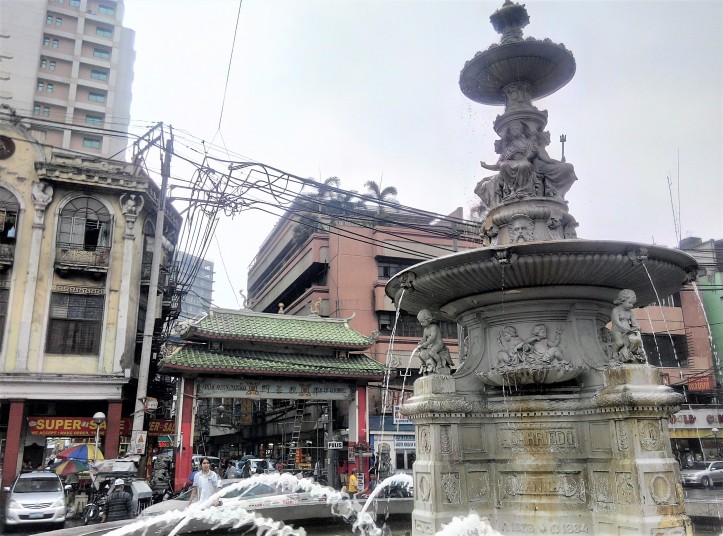
Despite the grime and the occasional potholes, and buildings that have seen better days, riches are also openly evident, especially in the form of the multitude of popular gold ornaments shops along the narrow streets and inside the confined precursors of shopping malls. 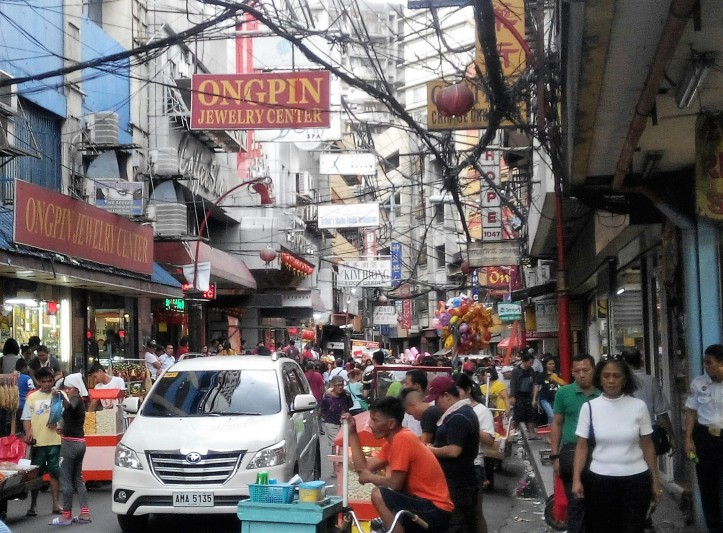
Another welcome arch to Binondo, this at near the western end of the curved Ongpin Street. 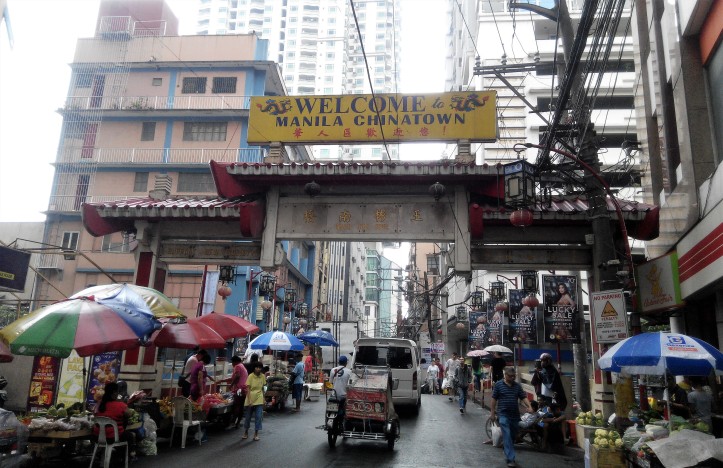
I was there on Lunar New Year eve and decorations were up along some sections of the main street. 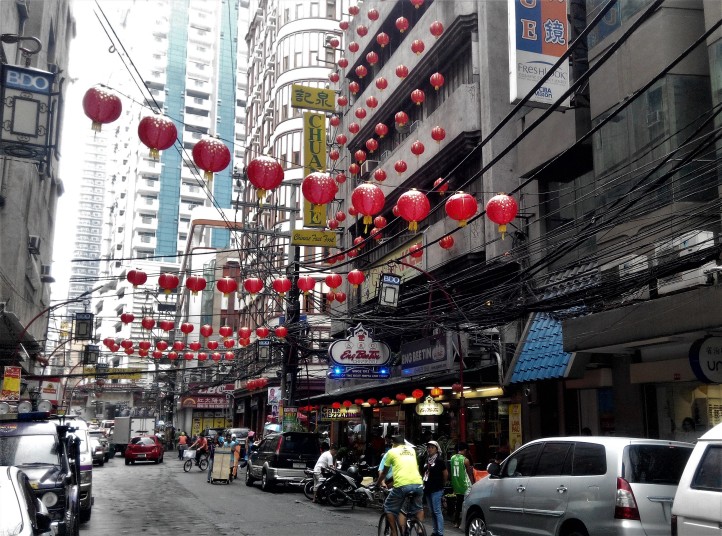
New Year goodies on display at sidewalk stalls. 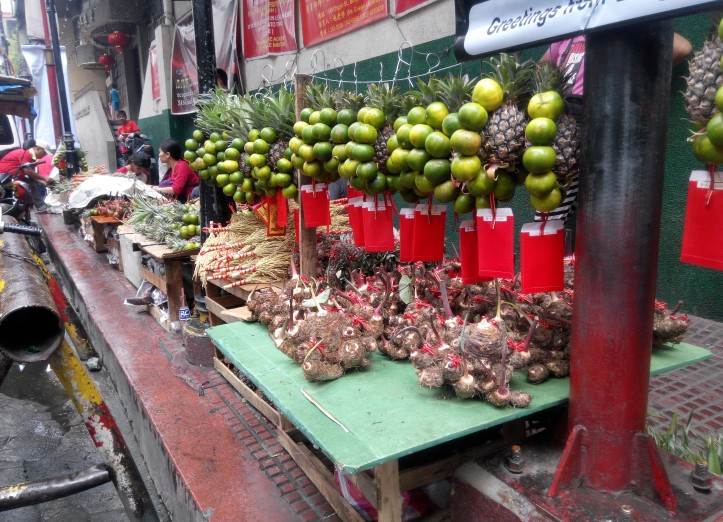
Nian gao or glutinous rice cake and known as tikoy locally. There are many flavors available, such as white sugar, brown sugar, yam, pandan and corn as can be discerned by their colors.
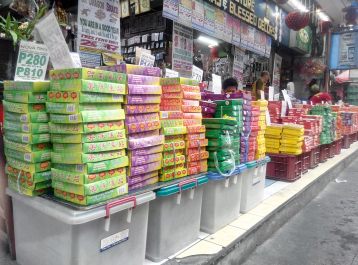
Restaurants and cafes are all over the place. There’s always one to suit any budget. Most of them serve – no prizes for guessing correctly – Chinese or to a lesser extent, Chinese-Filipino food. I’ve eaten there in all sorts; predominantly fast food joints and hole-in-the-wall eateries and once in a tinted moon, a fine Chinese restaurant. During the half dozen years straddling 2010 when I stayed there often, my favorite was this mid-sized two-storied place called MXT or Maxim Teahouse; mainly for their dim sum and mini steamboat. Very reasonable price and tasty food. I noticed it now goes by Mei Sum Teahouse. Same name in Chinese spelt differently in the Roman/Latin alphabet. 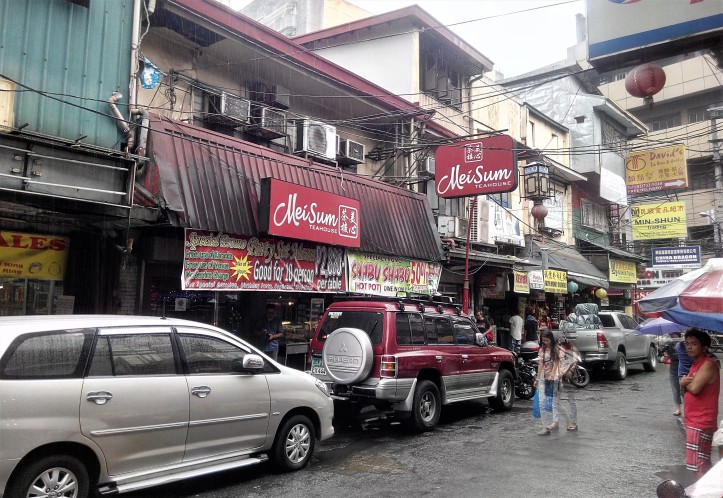
Ah, my regular abode then was a low-cost homely Chinese hotel with really friendly staff that I came to know very well. Very basic and old rooms but clean and safe. There used to be a casino inside but I only popped in for a look-see as I ain’t no gambler. It was renovated and renamed as Good Life Hotel a few years ago but I have not stayed there nor patronized the nearby Mei Sum Teahouse since the makeover.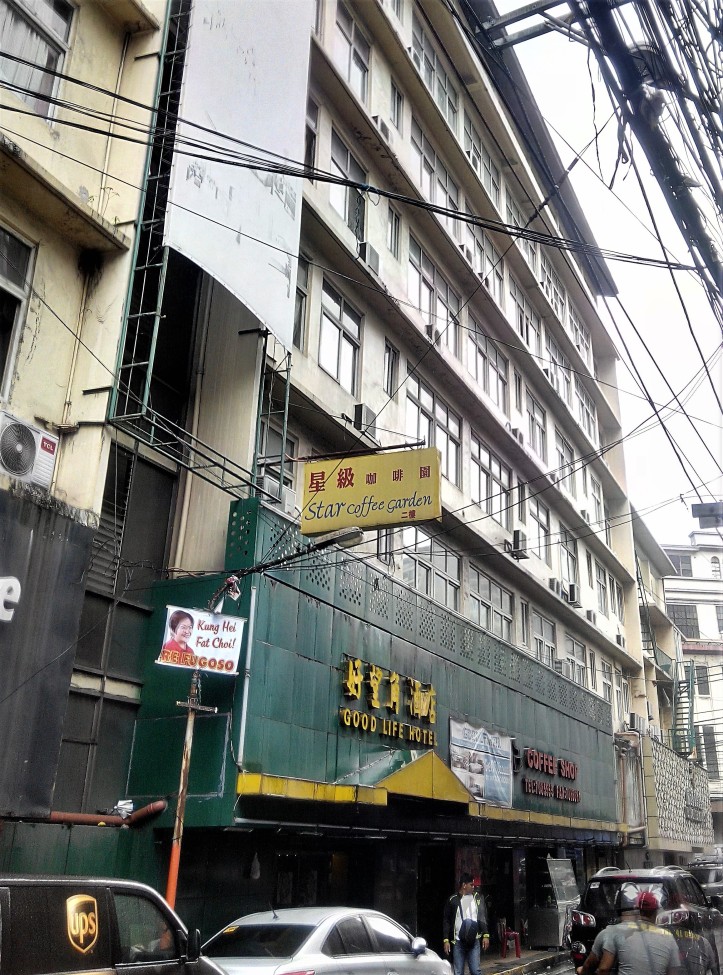
Right at the western end of Ongpin stands the landmark 16th century Binondo Church. It has been renovated and rebuilt many times over the centuries, the latest major effort being the mid 1950s. Current pic on the left and one of almost five years ago on the right. The spruced-up exteriors include the new coat of paint on the stone wall which was earlier in its natural state.
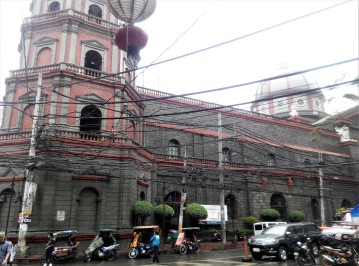
The unique purple fire engines that can be spotted all over Binondo are privately owned by corporations and individuals, and are manned by volunteers. Some are garaged inside buildings whilst others like this example nestling by the church are parked along roadsides. The convenient and beneficial arrangement is a legacy from bygone eras when fires break out often, both accidentally and through fraudulent attempts to claim insurance payouts. 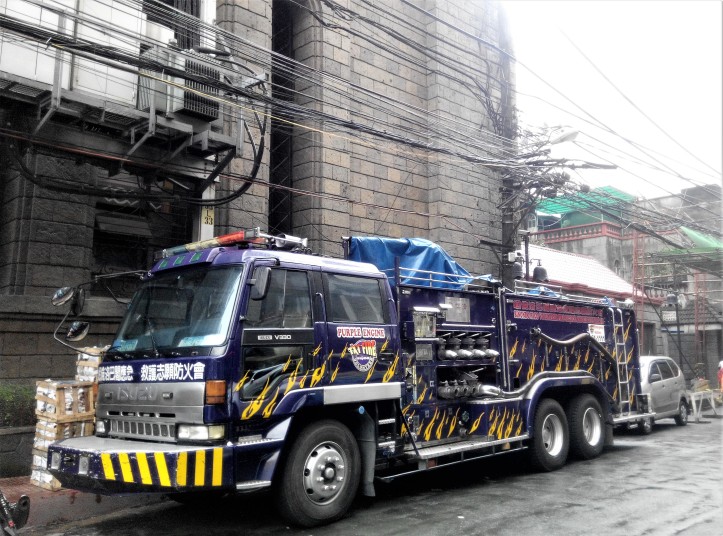
Binondo is one of the very few areas in Manila where one can take a ride in a kalesa or horse-drawn carriage. The Spanish colonists first introduced them into the Philippines in the 18th century, initially for noblemen and high officials. They are still in limited everyday use in some provinces. 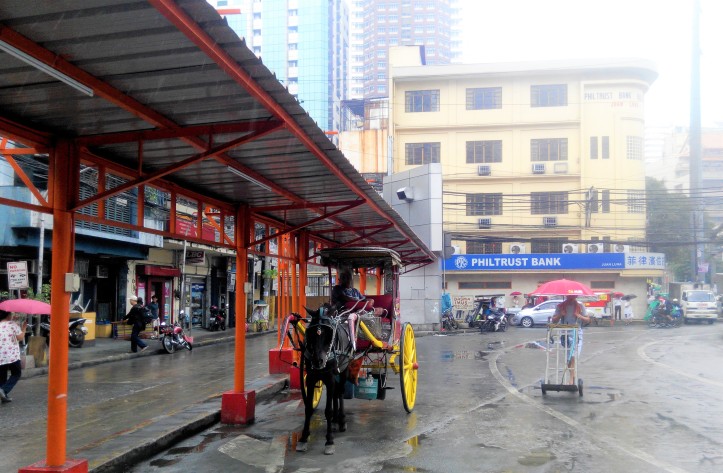
A dirty sight of Chinatown. Still, it’s not as filthy and smelly as our Singapore River before the big cleanup in the late seventies that took ten years and cost 170 millions in the SG dollars of the day. 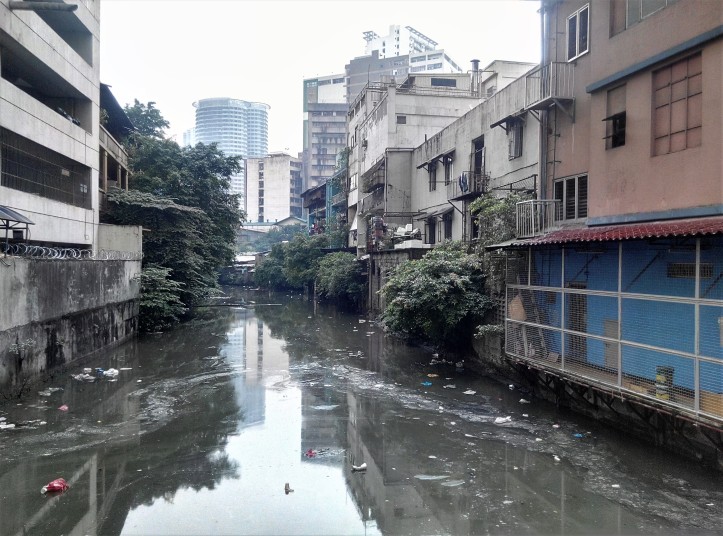
Beyond the western edge of Chinatown and a few hundred metres north from the western end of Ongpin Street is Divisoria district, known for its amazingly wide range of retail and wholesale of affordable goods. There are malls galore offering bargain-priced products from China and elsewhere. Real stuff and knockoffs can be found side by side. This is where you pay for what you get and get what you pay for. They are generally honest businesses who don’t try to pass off imitations as the genuine article. Stalls by the roadside sell the cheapest stuffs whose quality could sometimes be suspect.
The clustered numbered malls like 11/88, 168 and 999 are good bets. Though navigation could be confusing amidst myriad narrow corridors overflowing with boxes of goods, it’s still a reasonably comfortable experience thanks to the generally adequate air-conditioning. Shopaholics can expect to spend the best part of the day perusing the bewildering arrays of just about everything under the sun….and the moon. The area is not called “the mecca of value shopping” and “the mother of all markets in Manila” for nothing. If hunger pangs strike while on the “sacred mission”, not to worry as there are many foodcourts littered all over the malls. Shop till you drop but caveat emptor.
On Soler Street; 168 to the right, 999 to the left and 11/88 a little beyond, on the right. 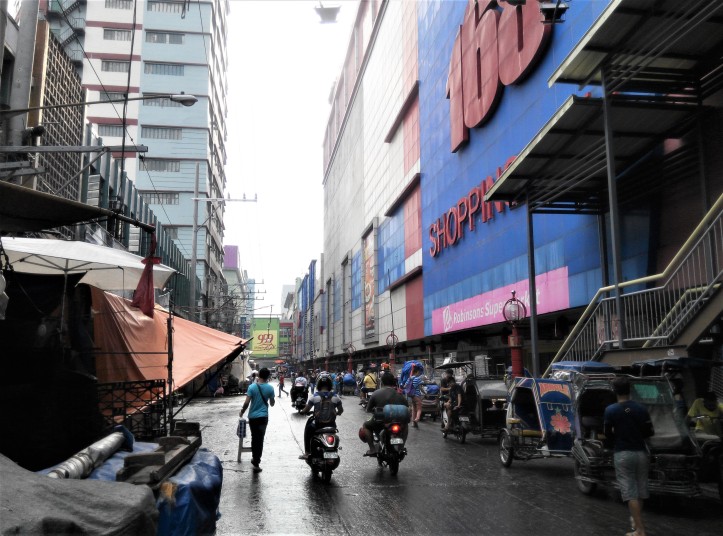
From the other end of that section of Soler Street, with 11/88 now on the left. 
Recto Avenue side of 999 Mall. On the right is another good place to immerse in; t he Tutuban Center Mall which was converted from the former Tutuban Central Station in 1993. Nice to spend some time here, if not for the shopping, then at least to soak in the sights of the ornate cast iron structures of the more than a century old ex train station’s preserved interior. 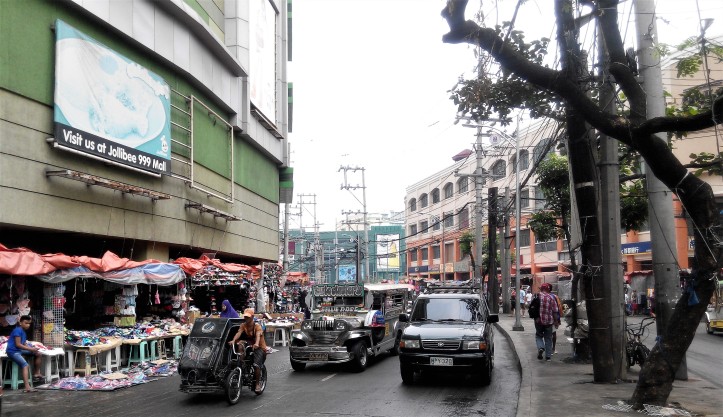
Interior of one of the numbered malls; 11/88.
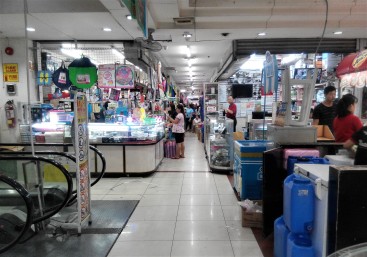

A hundred plus metres to the east of Carriedo Fountain lies the conveniently located Carriedo LRT Station. A tad further on is historically rich Hidalgo Street – named after the great 19th century Filipino artist Félix Resurrección Hidalgo – in Quiapo district, an old Manila downtown. Once regarded as Manila’s most beautiful street over a century ago, it became a mecca for photographers of all denominations. A variety of shops offering equipment, accessories, consumables, finishing, framings and repair services line the two sides, vendors of a mélange of other wares crowding the thoroughfare notwithstanding.
To make the “photographers’ haven” closer to heavenly, the “Hidalgo Project” initiative by top commercial photographer John Chua was carried out with governmental support in 2006 to rid the roadside vendors and make Hidalgo Street great again. The road was transformed into a beautiful uncluttered walkway for leisurely strolling and shopping; both of the window and actual variety. However, that makeover lasted only for some years and slowly but surely, the vendors crept back to de-beautify it and head it to the same old mishmash. What gradually went wrong? Probably because its easier to build than to maintain. Ah well, at least the phoenix had risen from its ashes for a while. Will it rise again? Who knows?
The cluttered-again Hidalgo Street of today.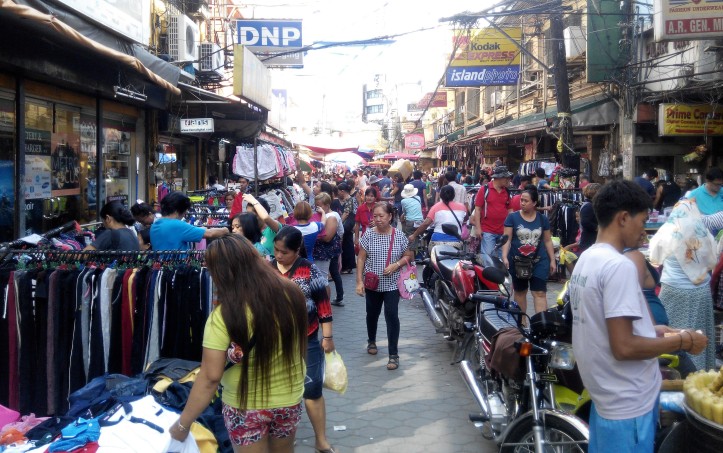
And backing up to the front end of the street. What does this augur? For the better or the same old, same old?
Like that Rebellion a long time ago in a galaxy far far away, one can only Hope ![]() .
. 
to be continued… … Next up: A few words on IP copyright and some interesting places nearby
You’re welcome, Git. ![]()
This is a recount from one of my numerous trips (lost count, but probably about 90 times and accumulatively more than 2 years’ stay) to The Philippines since the late 1970s. As before, I’m breaking it up into several parts.
Here we go.
Part 4
There are tons of interesting places near Binondo that I had been to previously but did not on this trip. As such, there are no pictures to show (too time consuming without guarantee of result to try to dig out the previously taken images). Yeah, there are many pretty photos out there in the web but google for them if interested. I post only pics taken by me or by acquaintances, with their permission.
There is something called copyright which many are either unaware of or worse, choose to ignore. That’s them and their choice. Me and the people around me respect the issue of intellectual properties; especially that concerning photographs by individuals. (As for the Google maps & images that appear in my posts, Google allows it under fair use: Brand Resource Center | Products and Services - Geo Guidelines). With this little unsolicited moral rambling out of the way, I will run through in just words the worthy nearby sights to visit.
The Quiapo district I previously mentioned is a little cousin of Divisoria, at least as far as shopping is concerned. The character is more mixed here, with a couple of major mosques mingling with temples and churches. Muslim visitors would feel at home here. Quiapo is also synonymous with the Minor Basilica or Quiapo Church of the Black Nazarene fame. The Procession of the Black Nazarene in early January (a life-size image of Jesus carved from ebony wood) is a huge annual event for Catholic devotees. The crowd had ranged from hundreds of thousands to multiple millions.
‘This is the place where the dead lives better than the living’. That’s a remark from one of the guys in our group when I first visited the Chinese Cemetery way back in 1979 as we passed through the squatters’ ramshackle abodes outside the fenced and gated community of the departed. Inside, its like a little township replete with actual solidly-built houses and mansions lining the streets. Plenty of those “dwellings” are air-conditioned, with beds, sofas, kitchen and other peripherals for comfortable earthy subsistence.
Visiting friends and relatives would spend many hours and even overnight with their lamented dear ones who are no longer in the temporal earthy world, particularly during All Souls’ Day and Qingming or tomb-sweeping periods. The cemetery, founded in the 1850s by prominent Filipino-Chinese Lim Ong and Tan Quien Sien aka Don Carlos Palanca Tanchueco, is around three kilometers to the north of Chinatown. A must-visit venue though a good number of the houses had fallen into varying states of disrepair as I witnessed on my last viewing about four years ago.
Two kilometers westward is the notorious Smokey Mountain rubbish dump in Tonto district but unless you are seriously into garbage, I wouldn’t recommend heading there. Wait, the waste landfill and the surrounding slum had become history for some two decades now, phew! Not quite. A new second Smokey Mountain twenty kilometers as the crow flies, northeast in Quezon City’s Payatas district had taken over the fishy smelly business. The Payatas Dumpsite has become the Philippines’ largest open garbage heap. Many of the tens of thousands of scavengers had migrated over from Tonto to continue making their improvised living.
Just a kilometer south of Binondo, across Pasig River is the walled city of Intramuros (Spanish for “within the walls”) and inside it, Fort Santiago.The over 400 year-old wall enclosing the then district of about twenty crisscrossing streets laid out in a grid, began to be constructed after being taken over by the Spanish to be their Philippines “capital”. Wars, natural disasters, age and neglect relentlessly ravaged it, and its final rebuilt occurred in the mid 20th century when it was declared a National Historical Monument.
Fort Santiago, at the northwestern-most corner of Intramurous was built to defend the walled city. Philippine national hero, José Rizal was imprisoned in the fort prior to his execution by the Spanish in 1896. The firing squad was composed of Filipino conscripts of the Spanish Army. However, there was a “backup” detail of Spaniards ready to shoot the local shooters should they fail to fire on the signal. His shrine there is well worth a looking over.
Rizal Park/Luneta Park
The extensive Rizal Park, among the largest in Asia’s urban areas, can be seen just beyond Intramuros’ southern walls. I remember the old musical dancing fountain, which has been rehabilitated some five years ago, very well. My slide, shot in the evening, of the colorfully lighted sprouting waters against a deep blue sky won me the second prize of a valuable wide angle lens in the only photo competition I ever entered, far back in 1980. A stone throw northeast from the fountain is a massive relief map of the Philippine Islands and near surrounds in an artificially crafted lake.
In the opposite direction rise the imposing Rizal Monument obelisk and in front of it is Independence Flagpole – the tallest such by law in the Philippines – and the Kilometre Zero marble marker where all distances from Manila begins. As an aside, remember our very own SG milestone markers of yore that began to disappear in the seventies with the adoption of the metric system? Those granite distance indicators of 1, 2….10 and so forth (with smaller intermediates of ¼, ½ & ¾) all radiate from the former General Post Office at Fullerton. Most of their full height of almost 2 metres was buried in the earth with only the engraved top of 350mm showing (the full miles ones are taller and broader but I don’t have the dimensions), but I digress.
Want to visit the entire Philippines without stepping out of Manila? Yes you can; by heading for Nayong Pilipino within a hundred metres northeast of the Japanese Garden. This very much smaller version of the Philippines-in-miniature, with replicas and scaled-downs of famous landmarks, was only opened recently to make up for the closure of the sprawling original adjacent to Manila Airport Terminal 2 and its ill-fated planned replacement in reclaimed land along southern Manila Bay many years ago. There’s also a somewhat bigger ten year old Nayong Pilipino in Clark, 80+ km north of Manila.
In and around Luneta Park – its other name by which is actually more locally known – are many other attractions that include – but not limited to – the Chinese & Japanese Gardens, Flower Clock, Orchidarium & Butterfly Pavilion, Quirino Grandstand, grand old dame Manila Hotel and family-oriented Manila Ocean Park. Nestled inside the latter is Makan Makan Asian Food Village.
Does the name ring a bell? It should, and that’s because its consultant and the man who was tasked with setting it up many years ago is none other than Makanguru K F Seetoh of Makansutra fame. From there, continue south along the further kilometers stretch of Roxas Boulevard overlooking Manila Bay where the sun sets spectacularly against the imposing masts of majestic moored yachts but let’s not get too far away……for now.
to be continued… … Next up: of food, and a “Silver Shadow”
Interlude
For those who are interested, the above is a link to more details about the Walled City. In the foreground of the pic is Fort Santiago. The thumbnail image in the link is enlarged (fair use as it is inside the article itself) below:
This is a recount from one of my numerous trips (lost count, but probably about 90 times and accumulatively more than 2 years’ stay) to The Philippines since the late 1970s. As before, I’m breaking it up into several parts.
Here we go.
Part 5
Did I make more than some passing mentions of food so far? I guess not, so here goes; from Manila and a bit beyond:-
As per the usual tradition, not long after the Official Opening, the group of organizers and VIPs adjourned a floor above to a sumptuous dinner at DADS World Buffet. The extravagant spread features calories-laden dishes from diverse cultures across the globe. The cuisines of China, Thailand, Singapore, Korea, Indonesia, India, Malaysia, Greece, Italy, Spain, America, Brazil, Japan, and of course the Philippines are represented. The only pic I took was of my filled plate at our table. It’s so much that despite inadvertently skipping lunch, I had no room left for dessert except the Filipino delicacy Puto Bumbong, a steamed purple-colored sticky rice cake shaped like little logs and liberally self-sprinkled with brown sugar, butter and freshly-grated coconut. Dinner prices for your pick of everything in sight is below 900 Pesos(SGD25/USD18), with approximately 16% and 28% lower costs for just Japanese or Filipino buffet respectively. It’s not fine dining, far from it, but really good scrumptious food with huge diversity of choice at great value. 
At the lowest end of the price spectrum is street food of which there is much to ogle at. Here’s a fast snack on the go; from one of similar franchises whose carts can be usually seen in malls and along roadsides. Three dainty bite-sized dumplings on a mini oval paper plate for the princely sum of only 10 pesos or SGD0.29/USD0.18. Another franchise stall on the left, Lugaw Republic, sells tasty porridge. 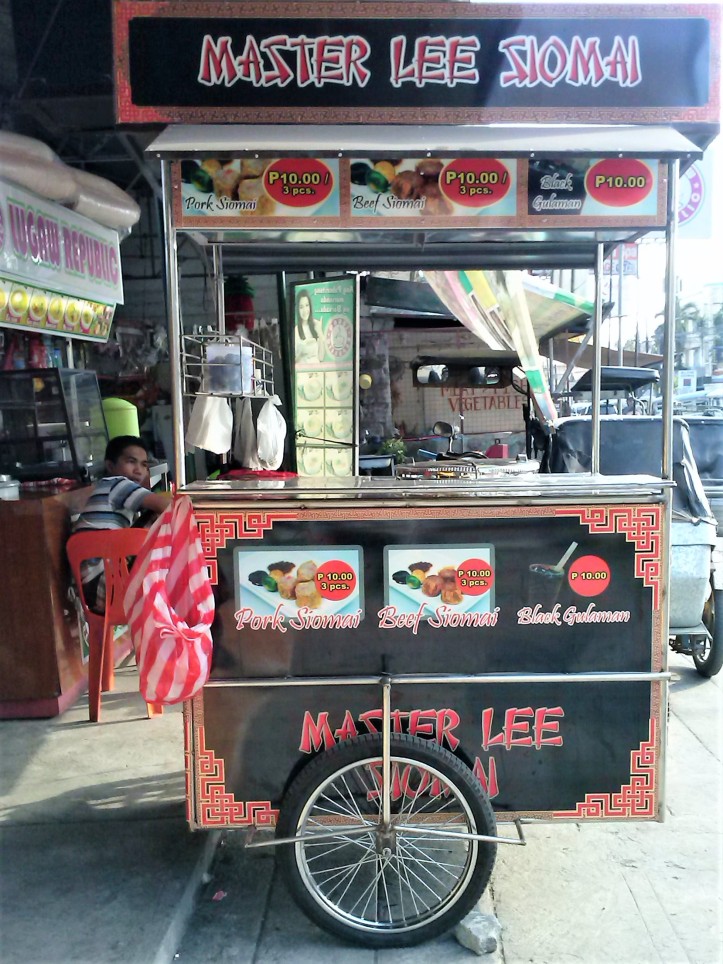
I usually take the redeye flight on the outbound, to arrive in Manila before or around dawn, and make a beeline for my fave brekky at a Jolliebee outlet. It’s 150 Pesos (SGD4.40/USD3.15) a set that consists of Palabok (plain noodles topped with egg, pork, pork crackling, shrimps & shrimp sauce), a piece of succulent fried chicken (imo more finger licking good than KFC’s) and a drink of choice. 
Another of my must-eat local dishes is Sizzling Sisig. It has a long history but the current popular iteration is a national dish originating from Pampanga province, a short distance north of Manila. Primary ingredient is pig’s ears, jowl & cheeks. The top pic is what I had at a foodcourt. The other is my own whipped up version at home when I craved for it with my next Philippines trip months away. Roasted pork belly is substituted; paired with Filipino-style garlic fried rice, and condiment.
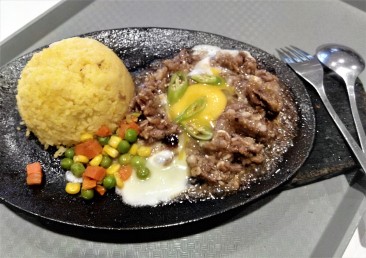
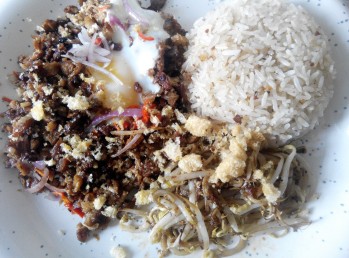
A late night snack for two; of barbecued fish and roasted chicken washed down with a local beer. On the left is another of Crispy Pata (deep fried pig knuckles), a very popular main dish or beer food.

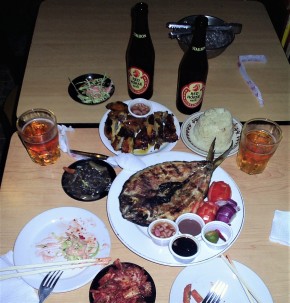
Yeah, I know, it’s mainly unhealthy grub but I’m addicted to it all and more, on every trip. What to do? Let me retell a little story that was narrated to me a long ago, and there are variations of it out there. A sixty year old man was at a medical checkup and suddenly asked his doctor who’s also a friend: “How long more can I live?” “Well, if you abstain from your alcohols and fatty foods, you have maybe another twenty years or more” was the answer. Unfazed, the man continued, “And if I don’t?” The doctor remarked; “Five years at the most.” “With a big smile, the man then blurted; “My friend, I rather do what I want and go sooner than to suffer for the last twenty years of my life!” I rest my case.
More fatty sin! My ¼ kg portion – at 500 Pesos a kg – of whole roasted piglet called Lechon Baboy, Cebu style. Comes with dips of a liver sauce concoction and vinegar with chili. Masarap(yummy)! 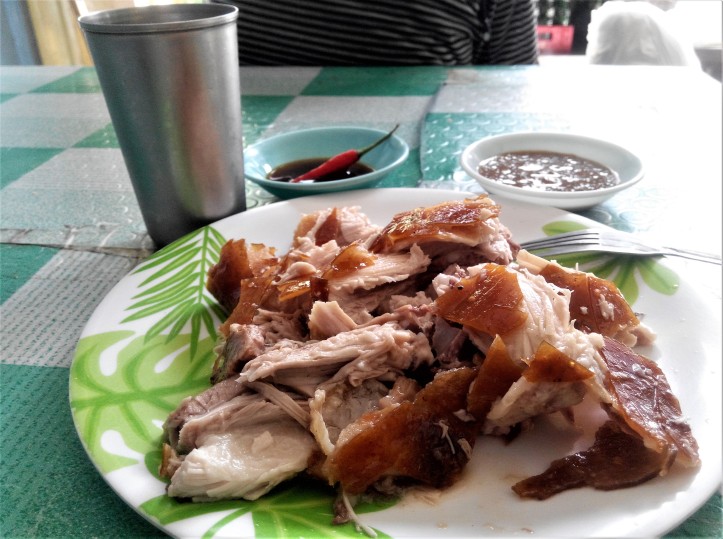
My regular Lechon stall. Besides pork, they also do chicken, calf & lamb. This pigsy being chopped up weighs about 25 kg; after its fiery final journey. It was a fast & effective but fatal way to slim down. 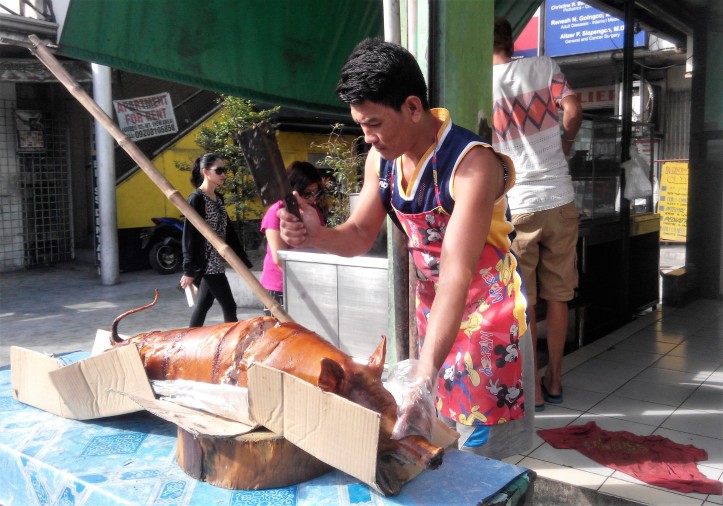

This is even more unforgivable! Inihaw na Liempo or grilled pork belly. Awesome!! The stall that I have been patronizing for more than 10 years does not have tables to dine in, so its takeaway to the hotel room. Having no proper utensil is not an insurmountable problem. I always eat it together with piping hot Pandesal, a Filipino bread roll of Portuguese origin. It’s velvet soft and chewy inside, with a thin crunchy crust covered in finely ground bread crumbs. To my palate, it’s the best bread I have ever come across in the four continents I’ve been to. It can be found in just about every Filipino bakery but most of them are cold which are not as great to the taste though still passably good. The shop that I got my regular fix from sells the fist-sized delights straight from the oven at 2 Pesos apiece. That’s six SG cents/4 US cents. I usually gobbled up to five at one go for dinner. 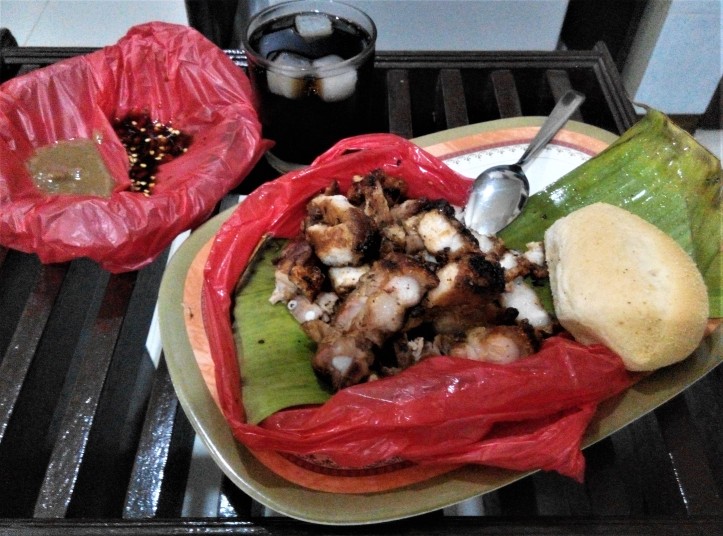
The same Liempo as above being earlier grilled to super crispy perfection over a bed of smoking hot charcoal. The boss personally cooked it for me as only he knows exactly how I want it done which is really, really not to be recommended to the health conscious. That said, a health nut who once accompanied me on my indulgence had kept admonishing me nightly but on the fourth occasion, he couldn’t resist the aroma and duly surrendered to order one for himself. 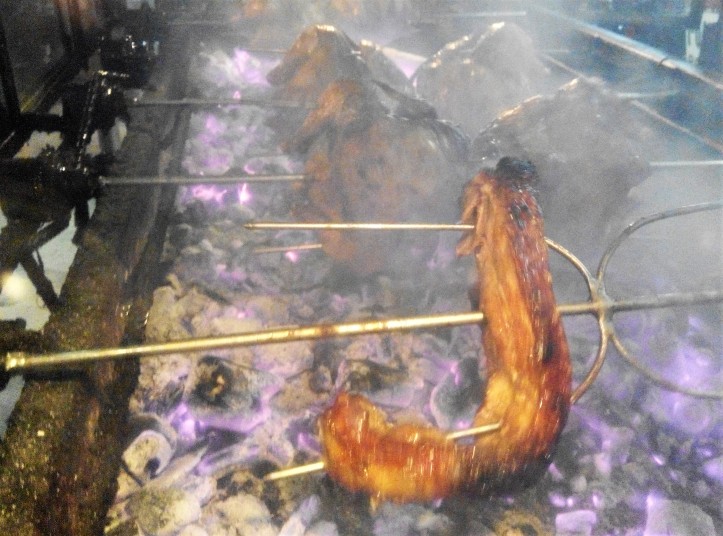
Ok ok, this is a (slightly) more balanced meal; a similar Liempo but accompanied with salad and noodle soup dishes this time round. 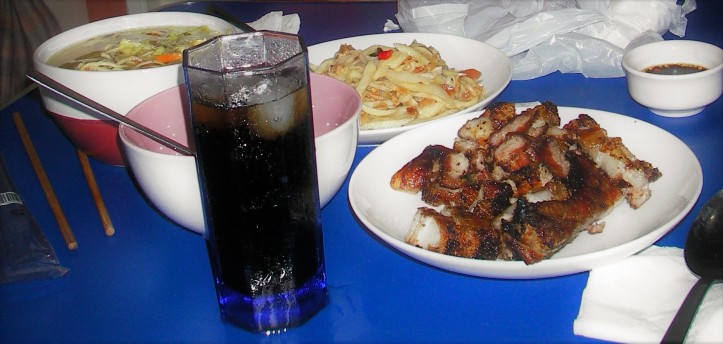
After all that epicurean immoderation, how about some medicine to counter the ill effects? Just pulling some legs here. The image below is of one of many generic medicine chain stores that are all over the Philippines. I do drop by one of these outlets now and then to top up on my small inventory of pills at home; for cold, cough, fever, and muscle pain. Good and cheap alternative to the all-in-one Panadol tablet when you caught just a single or couple of maladies. You down exactly what is needed; not more, not less. 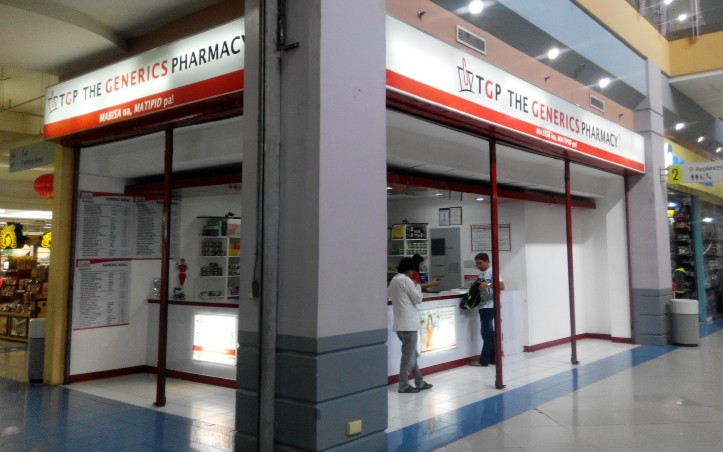
One for the road. Fancy a luxury limousine to drive or be driven around in? This aged but fine Rolls-Royce Silver Shadow II has been spotted sitting in a nearby province in the last two years or so. The current owner just might be willing to lower his expectations should your interest be aroused. Drop me a line if so
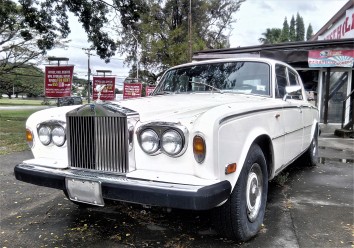
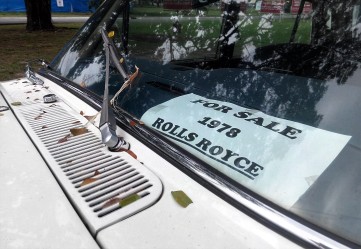
The end … … … and next change, a quick revisit to China’s Fujian province and Hong Kong, again from my archives.
China is a vast country with the world’s largest population and the longest continuous recorded history of 5,000 years. After over 500 years of decline, beginning towards the end of the Ming Dynasty and through the reign of its last dynastic imperial rulers; the Manchurian Ching Dynasty, the Sleeping Dragon has risen from its long slumber.
When Singapore eventually permit all and sundry of its citizens to visit the Middle Kingdom in the middle of 1985, I quickly finalised my dusty backpacking plans to crisscross most of the country; with the exception (due to visa length restriction of maximun 3 months) of its very farflung provinces of Xinjiang, Tibet, Inner Mongolia and the Dongbei region of former Manchuria.
The August to October '85 swing through the China proper of olden (but not antiquity) times referred to as Zhonghua took me 80+ days of bus, rail and boat travel (tried to book on sole internal airline CAAC for a few of the longer sectors but the flights were all full to the gills).
Fast forward to this June 2017 trip, and I’ve already done maybe close to a dozen return short hops to a number of cities. Shenzhen and Xiamen & its nearby minor cities were the most frequent because of proximity to Hong Kong in the case of the former. As for the Xiamen area, it’s the biggest city of Fujian where my ancestors hailed from circa a century ago.
Here we go.
Part 1
Fujian & HK: quick revisits
THIS UMPTEENTH TRIP TO MY OFT-TWINNED DESTINATIONS WAS REALLY NOT UNDER SERIOUS CONSIDERATION IN THE FIRST PLACE. KAKI (buddy) NICK HAS BEEN WANTING TO SET VIRGIN FOOT IN THE MIDDLE KINGDOM FOR A ZILLION YEARS. AS WAS MY CUSTOM, EVERYTIME I PLANNED TO GO OVER – WHICH WAS MANY IN THIS DECADE ALONE, I WOULD SEND HIM MY INTENDED DATES FOR THE FLIGHTS TO AND FROM HK ONCE I SPOTTED A GOOD DEAL ON AN LCC.
COMING ACROSS ANOTHER OF SUCH AT THE END OF DECEMBER FOR A JUNE TRIP, I TENTATIVELY MESSAGED NICK THE PROBABLE SCHEDULE TO TEST HIS WATERS. HOWEVER, UNLIKE ON ALL PREVIOUS OCCASIONS, HE SURPRISINGLY REPLIED IN DOUBLE QUICK TIME THAT WAS NOT ONLY AN AFFIRMATION OF INTENT BUT ALSO THAT HE HAD BOOKED THE FLIGHTS. WOW, IT WAS OUT OF THE BLUE BUT WHAT ELSE FOR ME TO DO EXCEPT TO FOLLOW SUIT……I COULDN’T LEAVE HIM IN THE LURCH, COULD I?
The nuclear reactors/missile silos of southern China… … …not. ▼
*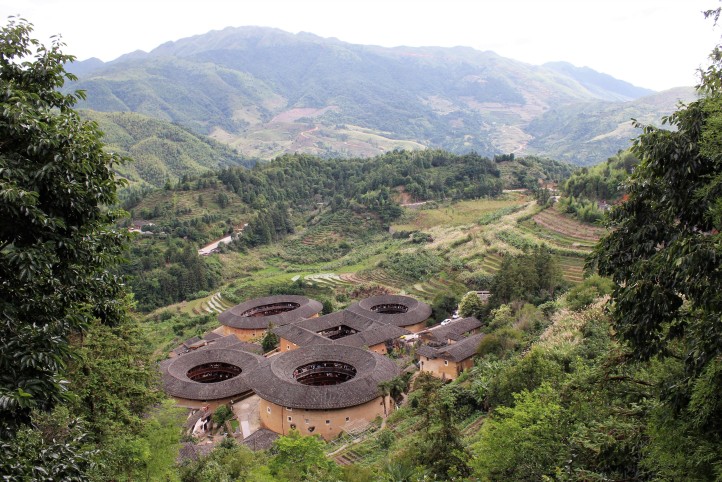
Now, in recent times, I would always take a Scoot redeye on the outbound and an early dawn return flight to maximize my time on foreign soil. As Nick has incessantly bickered about my penchant for flying at unholy hours on our Phil and Jakarta hops previously, we took Jetstar’s more normal departure times, arriving at destination in the early afternoon. We split to go separate ways on arrival at HK Airport, he boarding an express bus to transfer to the MTR in the New Territories for the border crossing into Shenzhen. I took another airport coach to HK island to look up some acquaintances and to continue on to the border town only late at night. We met up again the next morning at Chinese border town Luohu and then on to Shenzhen North Railway Station for the noon HSR train to Xiamen in Fujian province.
From Zero to Number One. Before carrying on, let’s have a little discourse on China’s High Speed Rail. In the 10 years since its first introduction into service, the Middle Kingdom’s breakneck speed of construction of the country-wide HSR network has seen its meteoric rise from absolute nothing to now possessing the world’s longest such routes of 22,000 km which account for a staggering two third of the planet’s total. Current planning envisages the tracks doubling to a mind-boggling 45,000 km by 2030. (Those plans have been greatly accelerated since then. As of end 2021, the total length in operation is 40,000 km, with another 10,000 km to be completed by 2025). Average operational speeds range from 200km/h to 350km/h but the upper end has since been limited to around 300km/h for energy conservation so as to lower ticket prices, and to a lesser extent safety reasons.
The Xiashen Railway we took was a tad over 500km with 15 short stops at other towns and cities along the way, the journey clocking less than 4 hours. This line is the first along the mountainous southeast coast and as such, took six years or more than twice as long to build than others of comparable length. Also with more twists and turns, maximum speed never goes much more than 200km/h.
Talking of speed, the fastest train service’s operational speed is the Shanghai Maglev Train which can reach 431 km/h but due to the limited length of the Shanghai magnetic levitation track of only 30 km, the maglev train’s average trip speed is only about 245 km/h. Its top non-commercial speed is 501 km/h. Anyway, the top speed attained by a non-maglev train in China is 487.3 km/h by a CRH380BL train on the Beijing–Shanghai High-Speed Railway during a testing run on January 10, 2011, but I am digressing too much.
A couple of HSR trains at Xiamen Station. (Oh, in case you’re wondering, the station is as close to spotless as can be. That blotch in the ceiling was caused by a rain droplet on the camera lens as it was beginning to drizzle when I stepped out beyond the roof). ▼ 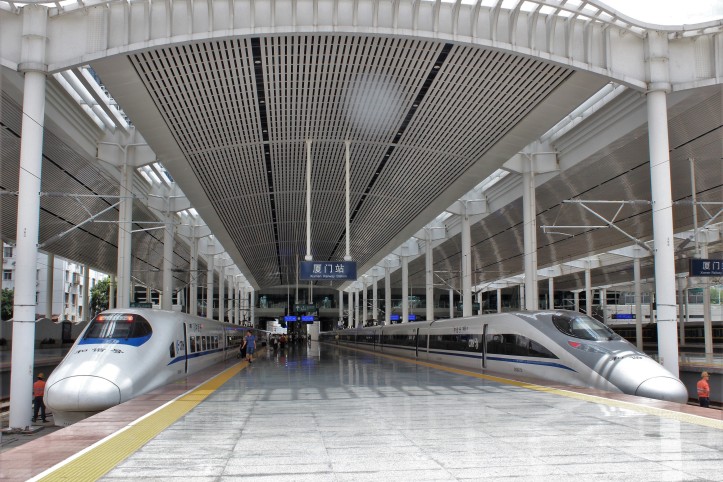
Xiamen. After checking into our hotel rooms in the late afternoon, we relaxed for awhile before heading for a seafood dinner hosted by a Xiamen-based Singapore friend. As said, I’ve been to this island city numerous times but for Nick’s benefit, we drove around the next day and revisited a few scenic spots such as the Island Ring Road, the centuries old Nanputou Temple, Zhongshan Park and Zhongshan Road shopping & entertainment belt.
Before setting off from the friend’s premises, I was customarily greeted with a “ni hao” (how are you) from Xiao Bai, the company mascot. The sparse feathers on the body is the result of Xiao Bai’s masochistic tendencies. ▼ 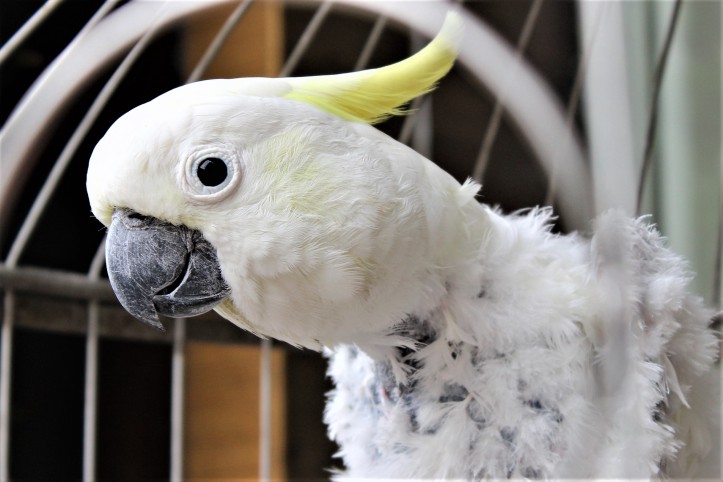
First stop; at the seaside branch of my Xiamen-based friend’s wedding studio. The coffee bar Nick was looking at is a supplementary outlet. ▼ 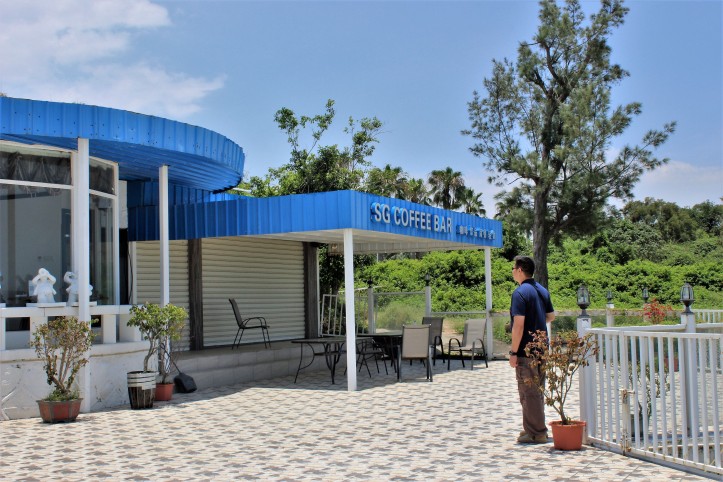
Nick’s “kiri puseng” (left turn) view from the same spot. ▼ 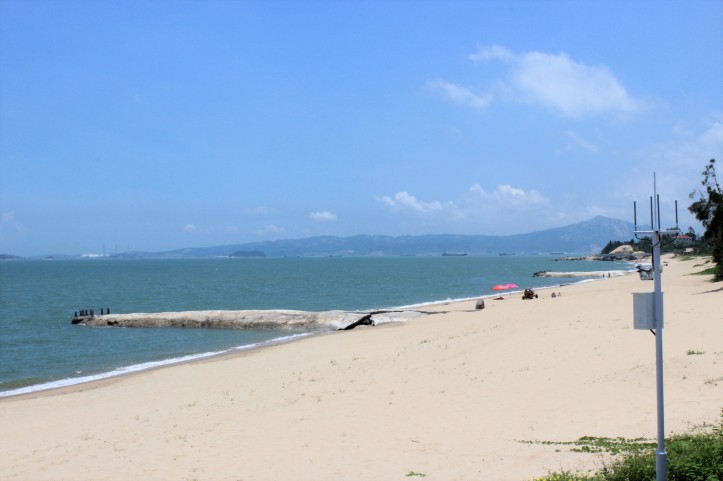
Front view of the facilities, with our ride in the foreground. ▼ 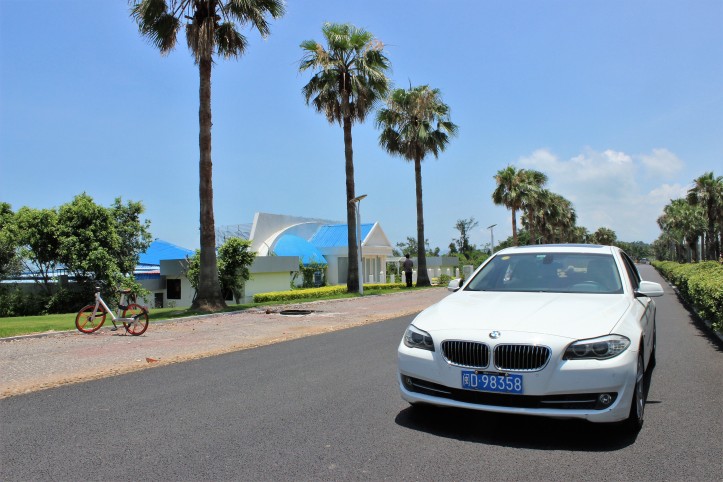
Through the windscreen of our transport, along the scenic Island Ring Road, on our way to Nanputou Temple. Those twin towers in the background resemble a pair of Hudiedao (Butterfly Sword)…………bad Fengshui! (literally wind & water, the term refers to Chinese geomancy) ▼
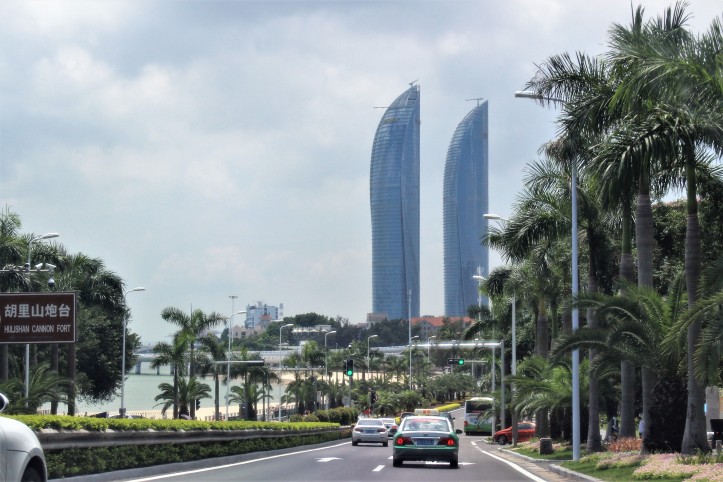
An architecturally striking overhead pedestrian bridge, this through the car’s side window. The reflections came with the territory. ▼ 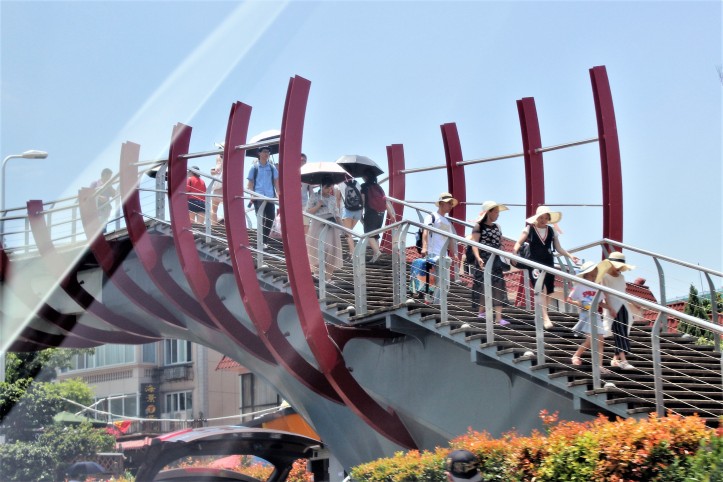
Upon arrival at the Tang Dynasty era Nanputou Temple, it;s already lunchtime so we made a beeline for its in-temple restaurant’s set meal. All these vegetarian dishes for the three of us left our stomachs feeling bloated. ▼
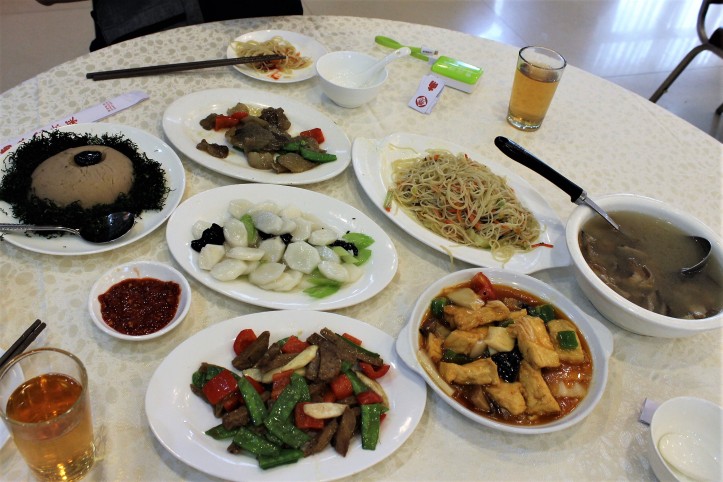
Time to burn off all those calories; with a stroll around the extensive temple grounds. ▼
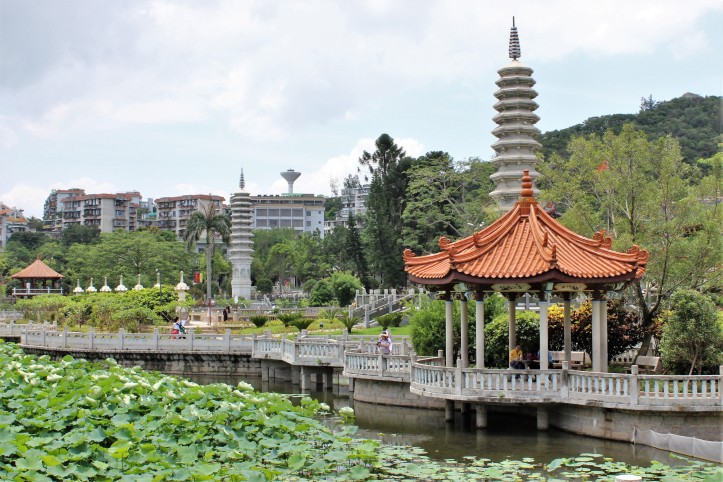
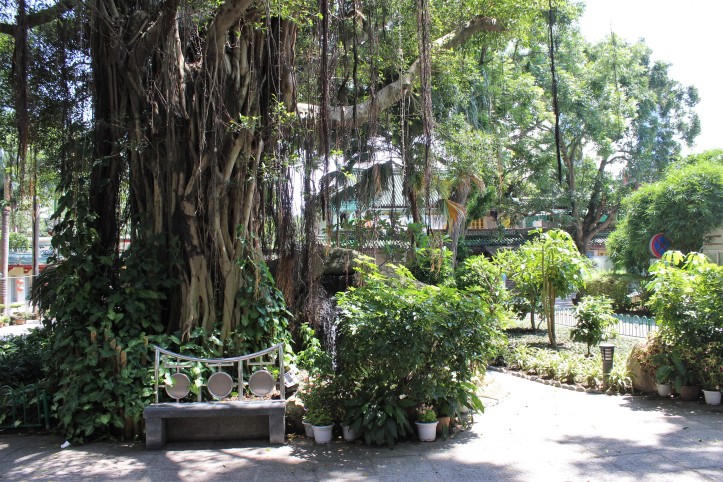
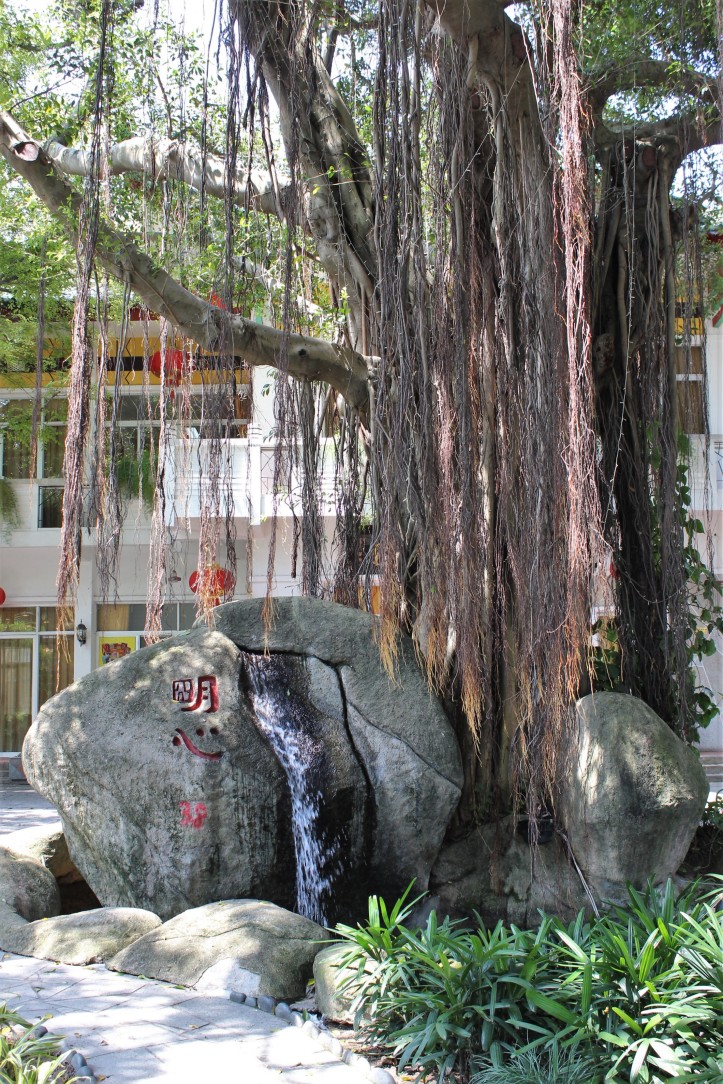
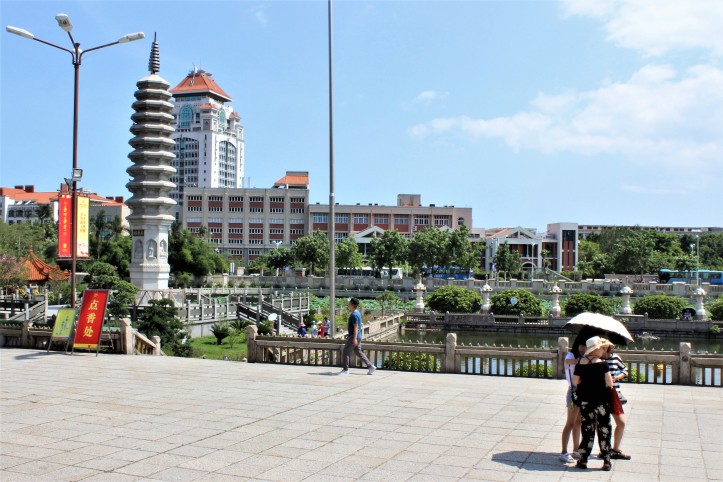
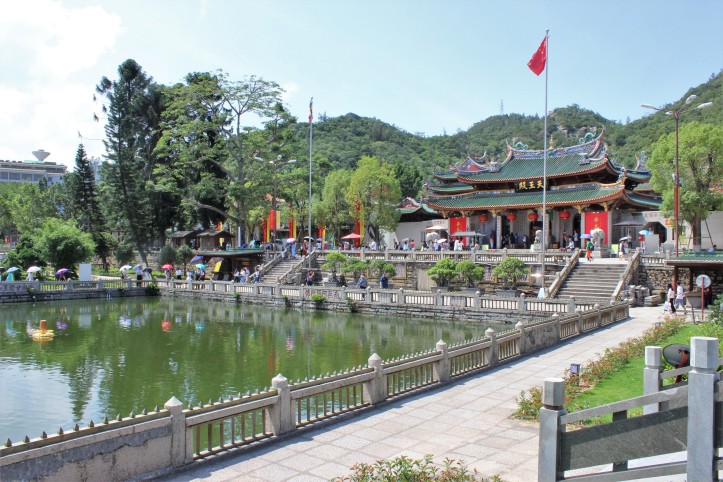
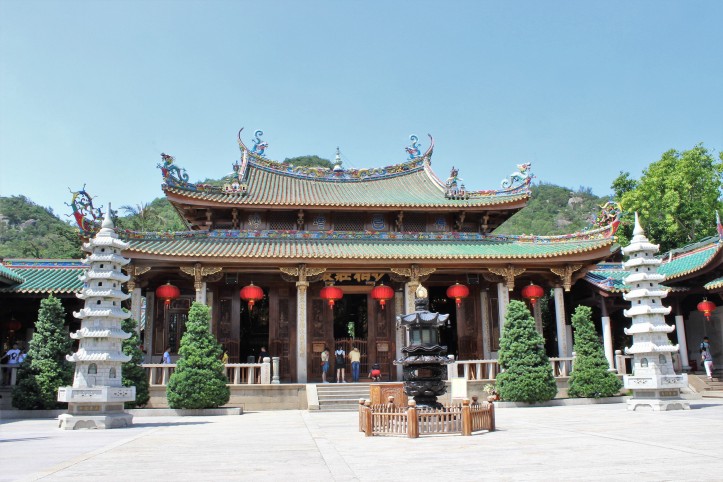

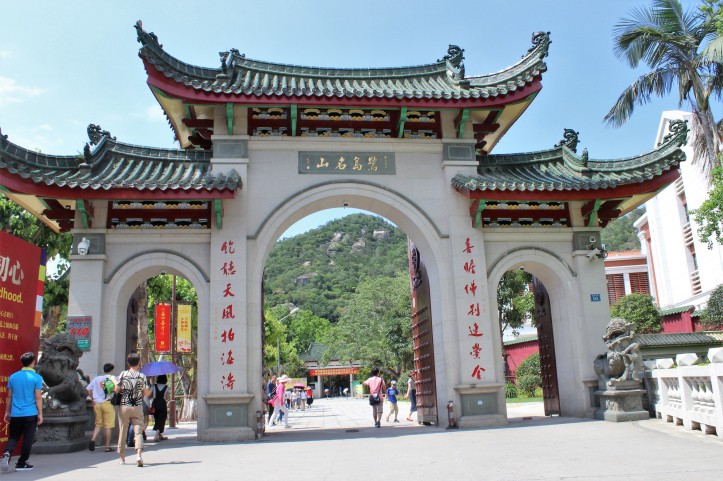
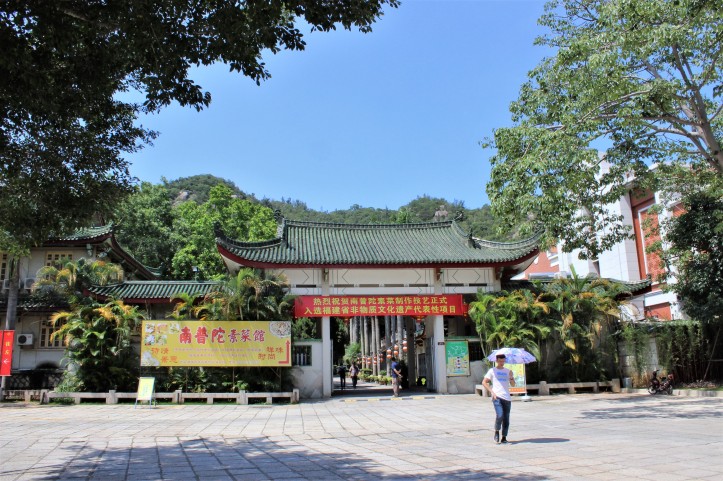
Some eye candies strutting their stuffs. ▼

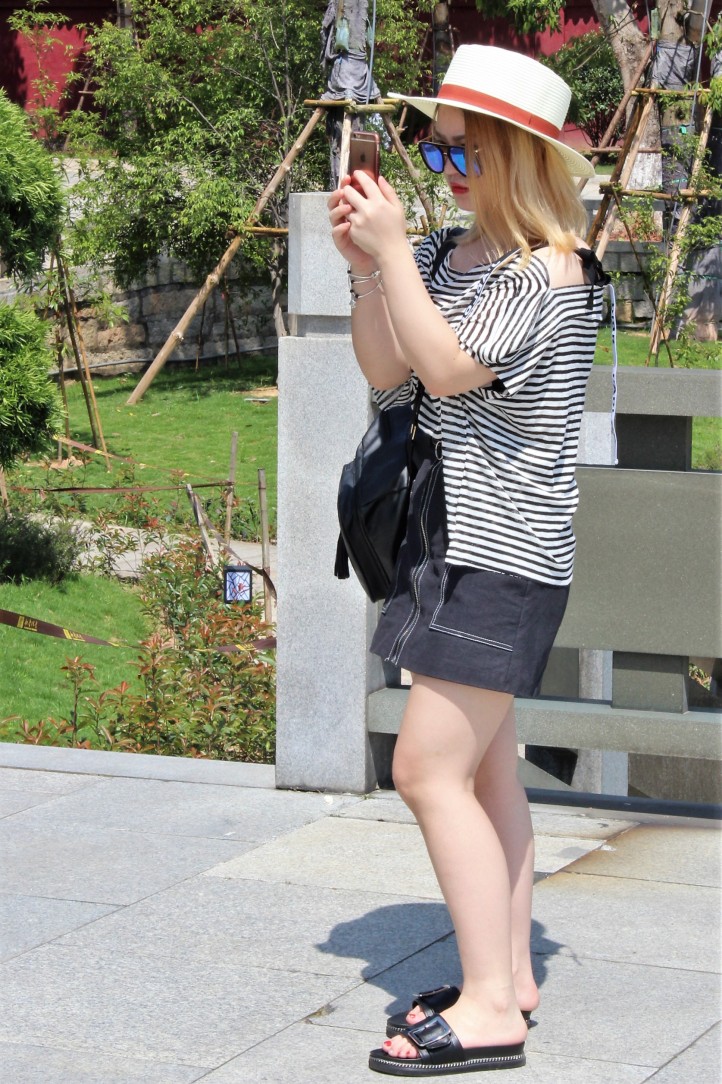
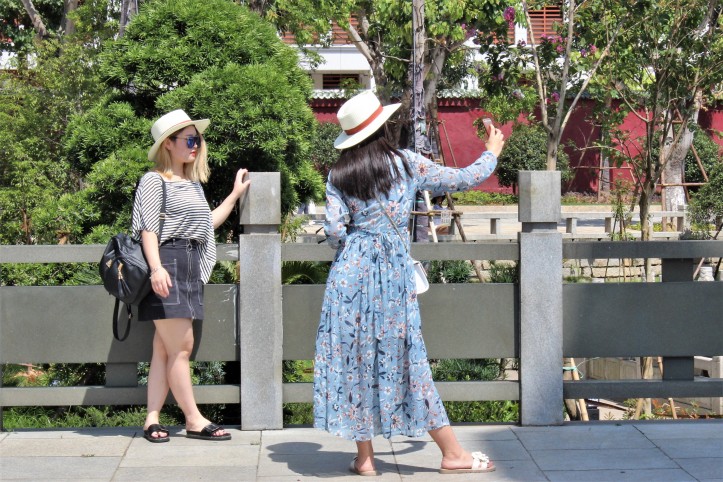 *
*
In contrast, this lady is more spiritually devoted than narcissistic. ▼ 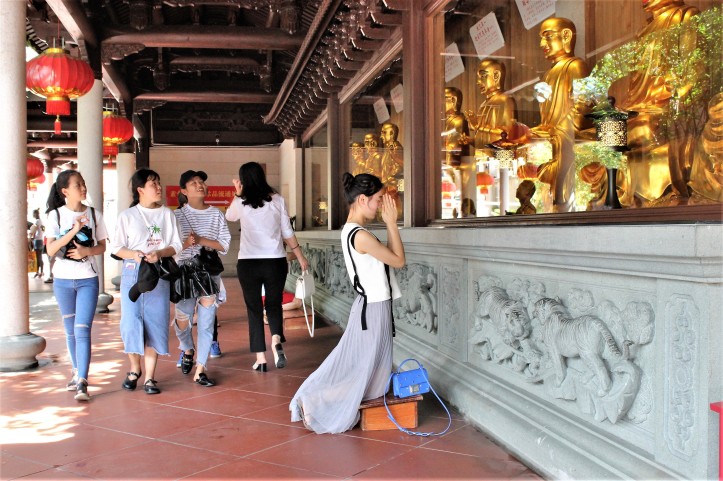
There are of course other, more permanent denizens. ▼ 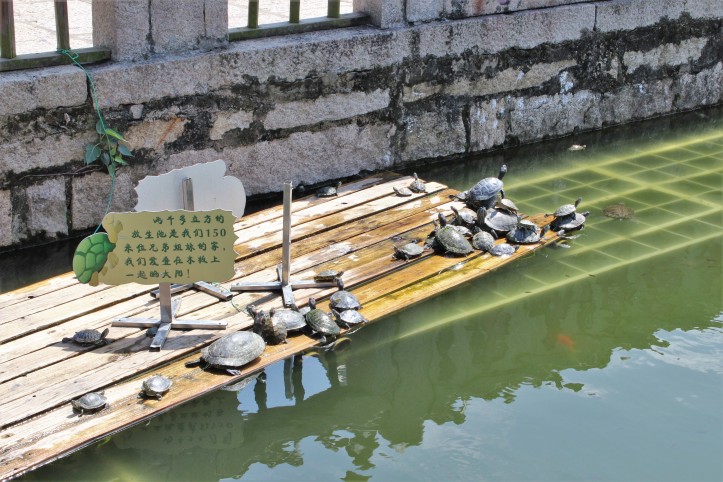
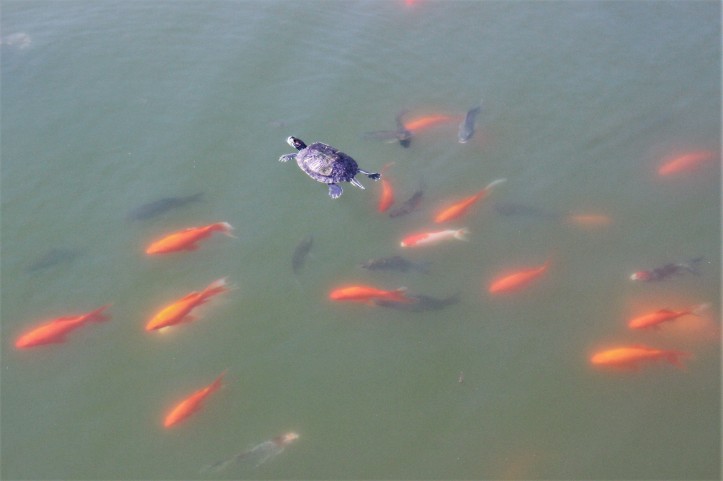
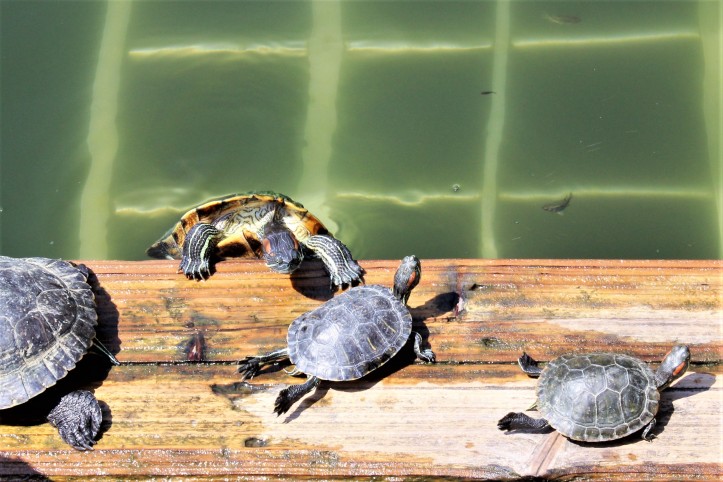
Next ̶p̶o̶r̶t̶ place of call: Zhongshan Park, named after Sun Yat-sen or Sūn Zhōngshān (孫中山) in Mandarin. A tranquil environment right at around the city centre. ▼ 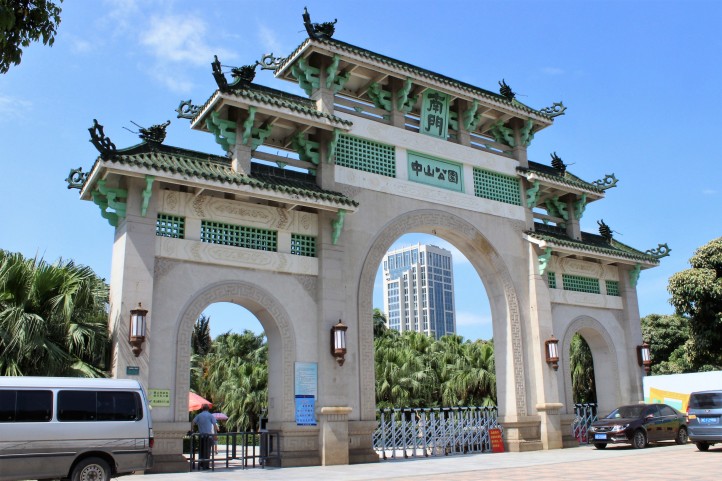
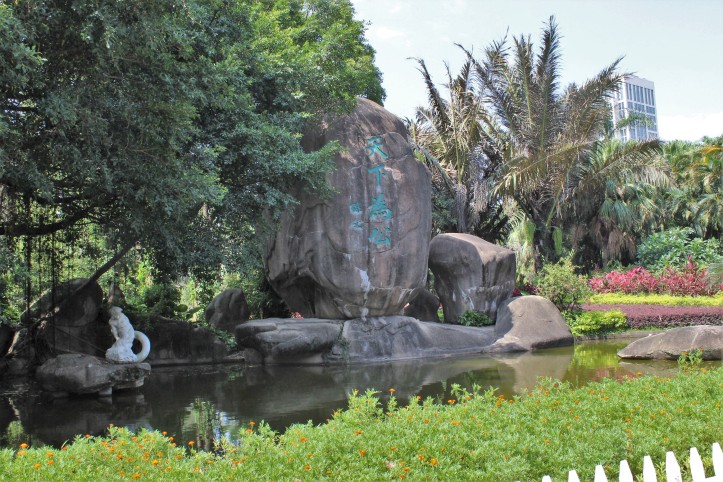

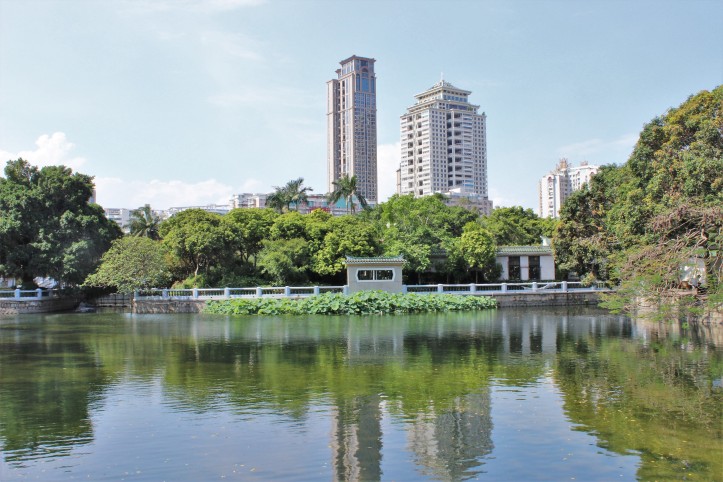
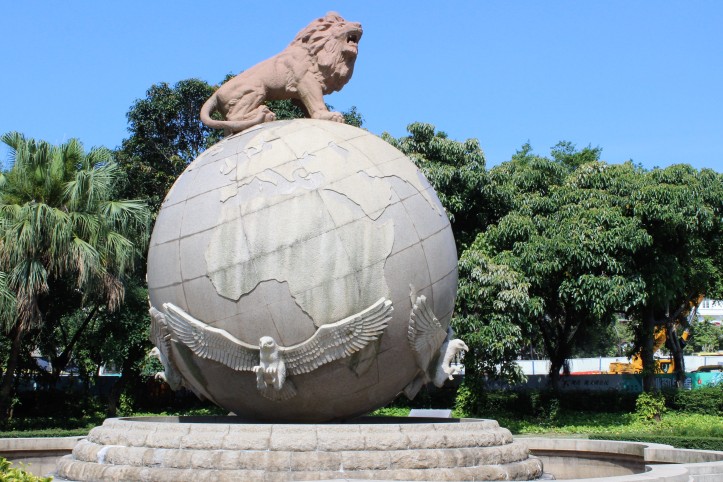
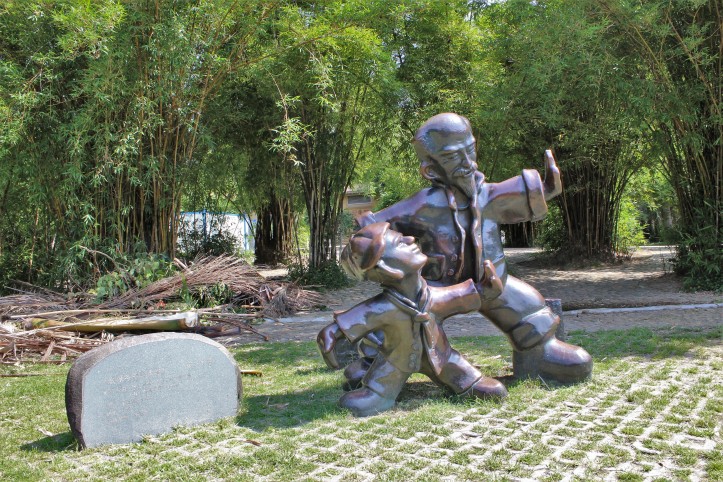
Some leisure activities were evident in the shady respites at the park’s lush grounds. ▼ 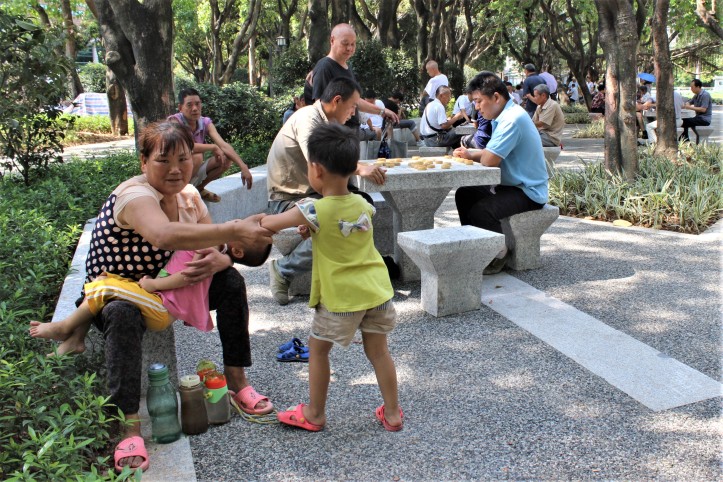
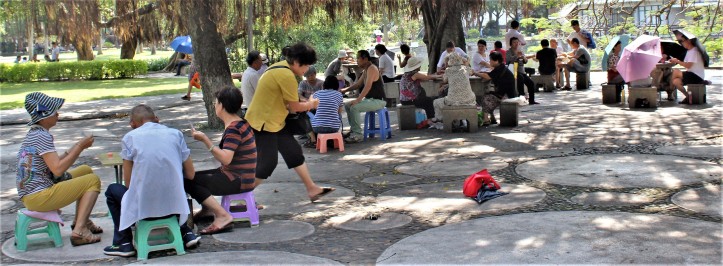
A few hundred metres southwest from Zhongshan Park’s south entrance is Xiamen’s equivalent of the Little Red Dot’s Orchard Road; Zhongshan Lu. Its westernmost section leading to the sea is designated a walking street, free of motorized traffic. Being the heart of the island’s commercial area, it’s a bustling, prosperous sub district of shops and malls along not only the main drag but also the side streets and alleys. Most of the buildings there owe their existence to the Huaqiao or Overseas Chinese. ▼ 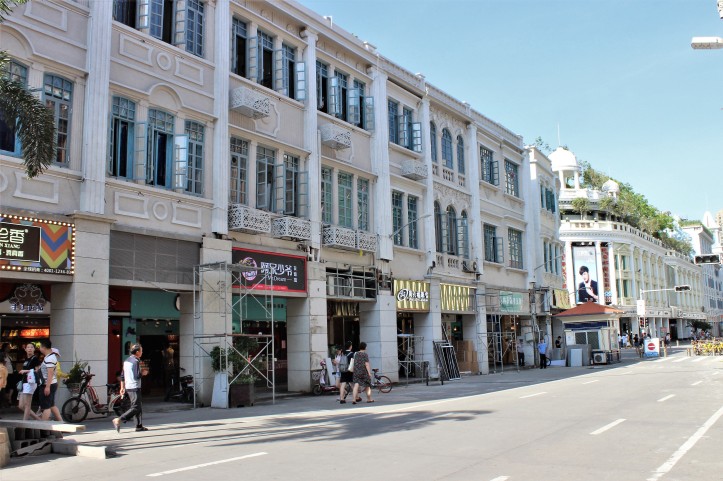
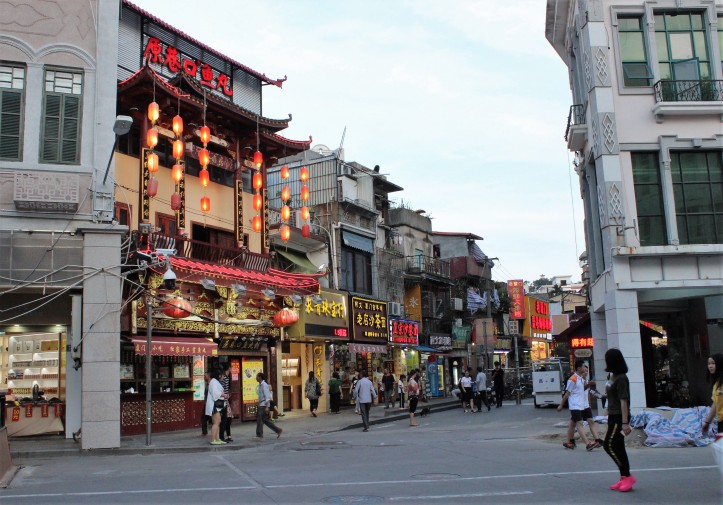
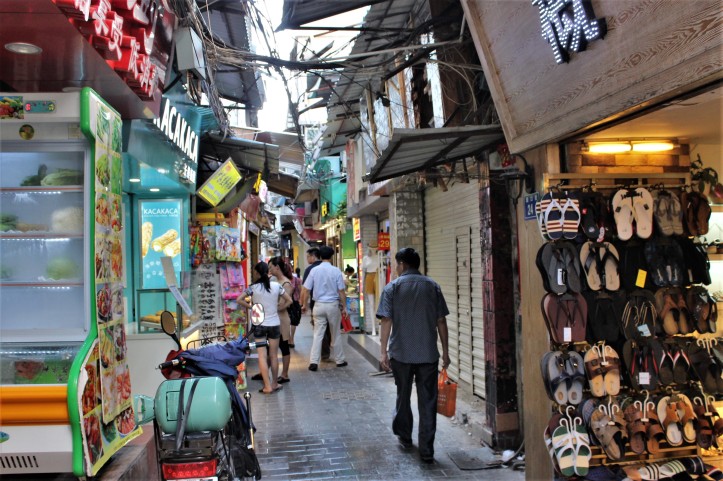
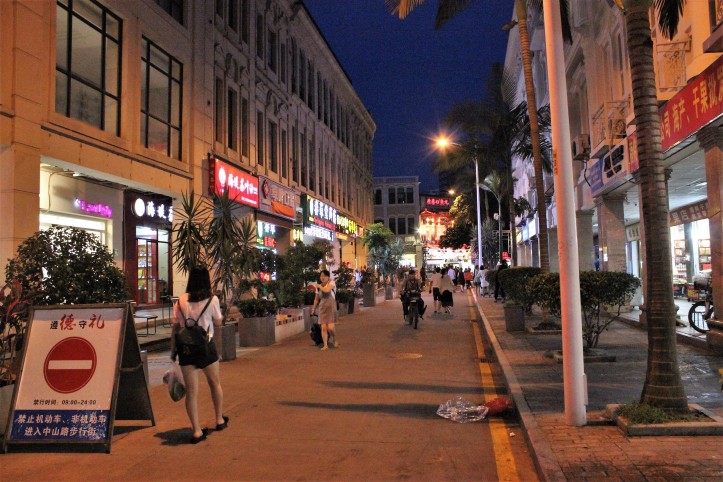
Earlier, at the northeastern end, at its junction with Datong, Xinhua and Huyuan Roads is the massive glass-walled building housing the Communist Party of China’s Xiamen Weizhengfa Committee. ▼ 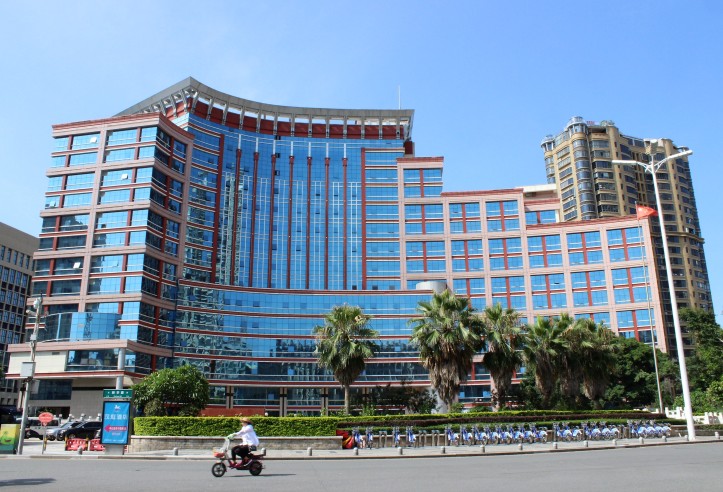
The largest mall in Zhongshan Lu; China City. Note the giant LED display screen, so prevalent in China. ▼ 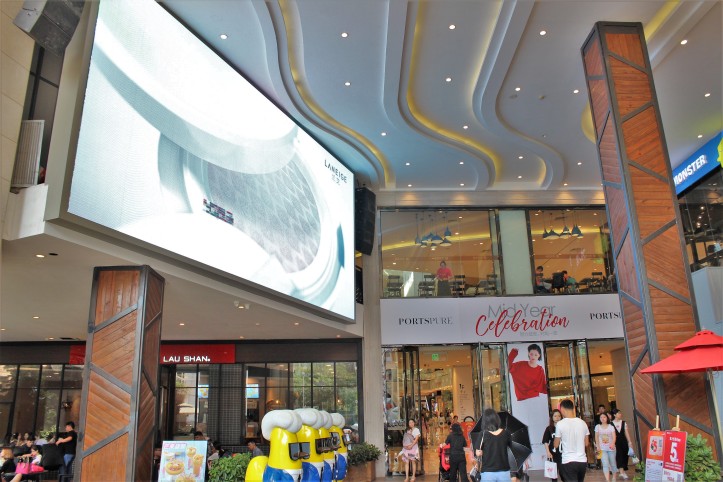
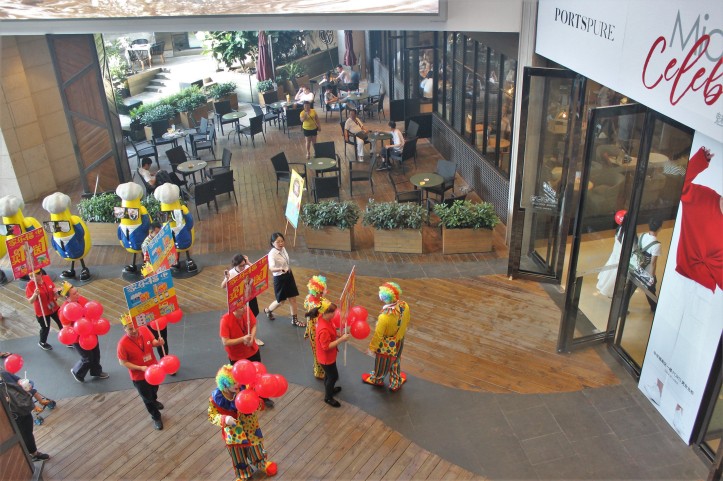
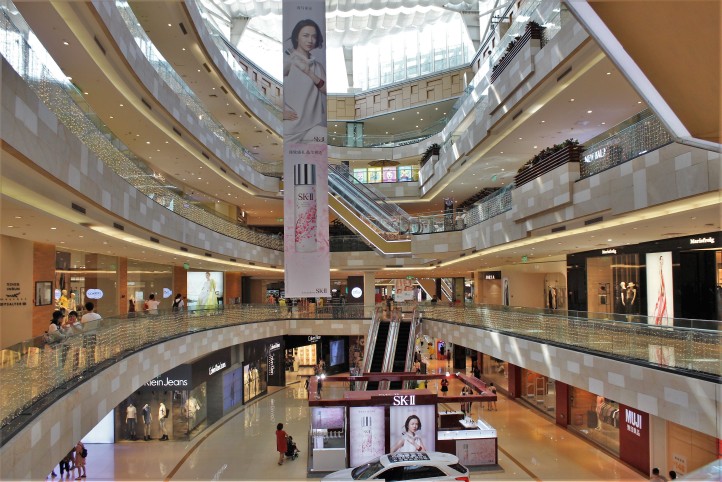
An outlet in the mall selling the imported Thermos brand of flasks whose prices are about 20 times that of local equivalents. ▼ 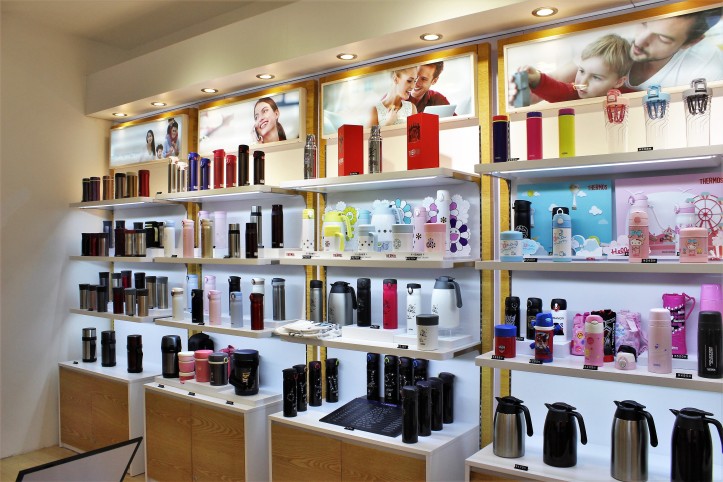
The friendly proprietress of a dried goods shop and her precocious little son. The smart kiddo can recite the 2,000 character long entire volume of San Ji Jing or Trimetric Classic without batting an eyelid, as we had witnessed. ▼ 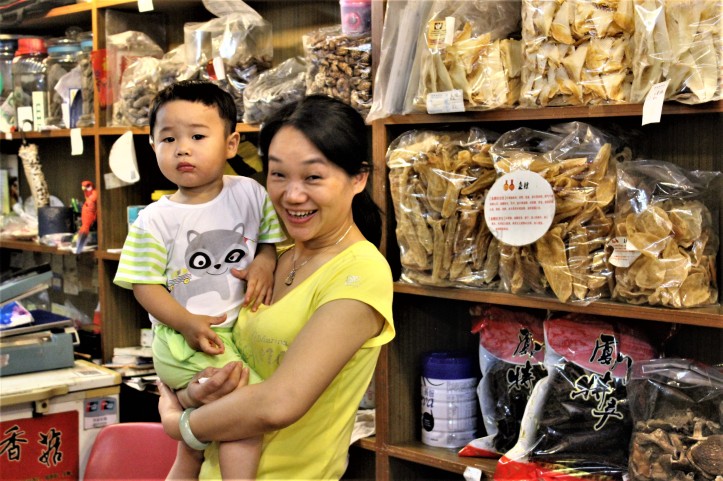
With such a full lunch at Nanputou earlier, we only had room for a dinner of satay noodles and a shared plate of wuxiang (five spices meat roll)……barely. ▼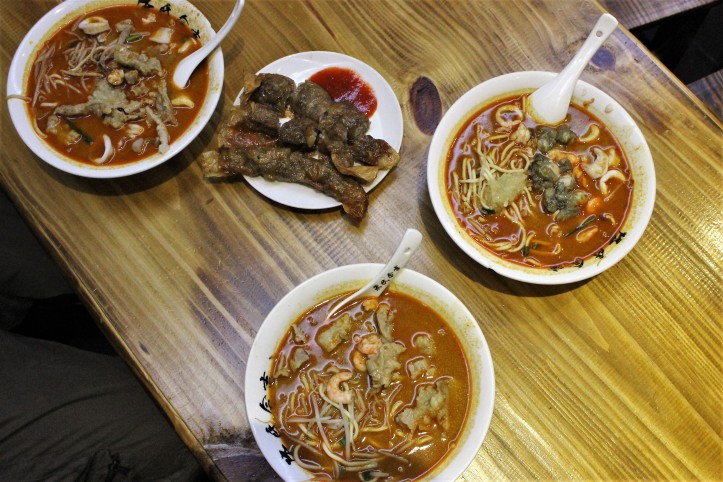
My eyes did a double-double take. Is that a certain Lee something going through his Taichi moves? Nah, couldn’t be. Maybe a distant cousin doppelganger. (He’s a 80% lookalike of Singapore’s Prime Minister Lee Hsien Loong) ▼ 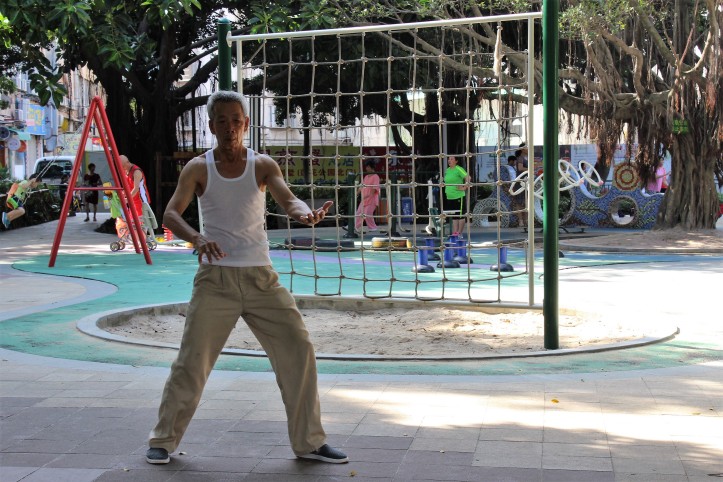
Other health conscious residents doing their morning exercises at a park behind my Lotus Road hotel. ▼ 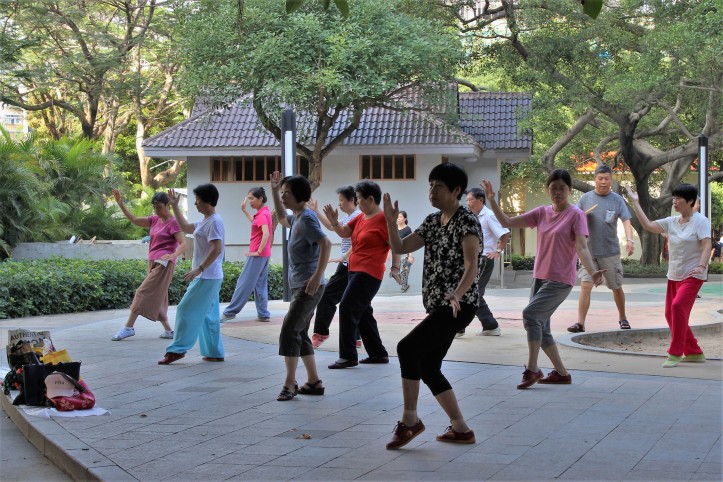
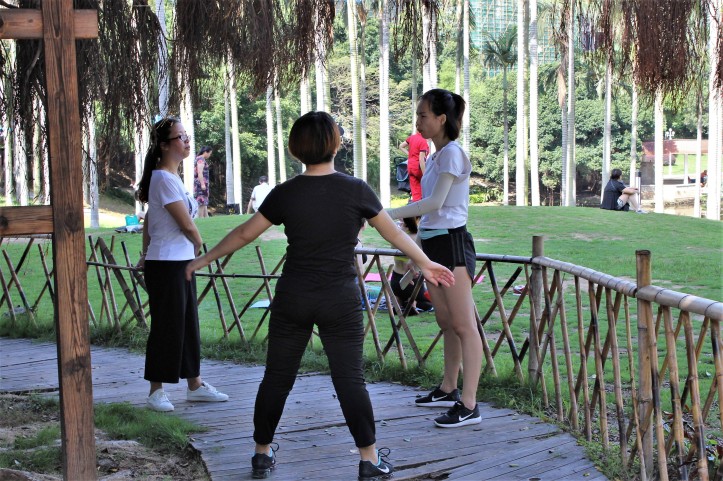
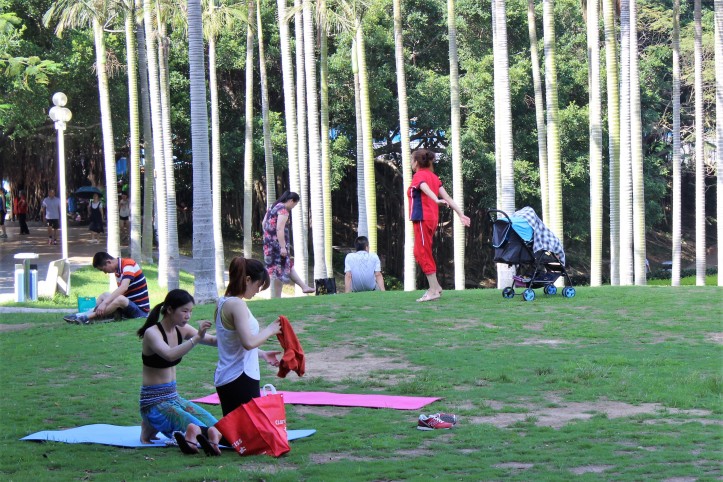
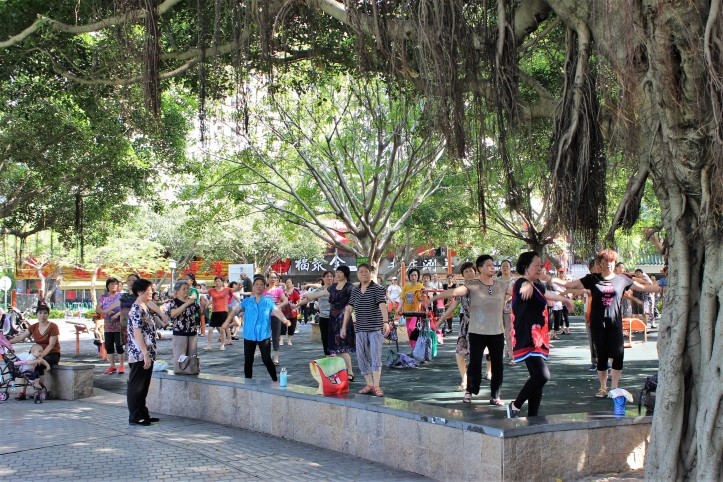
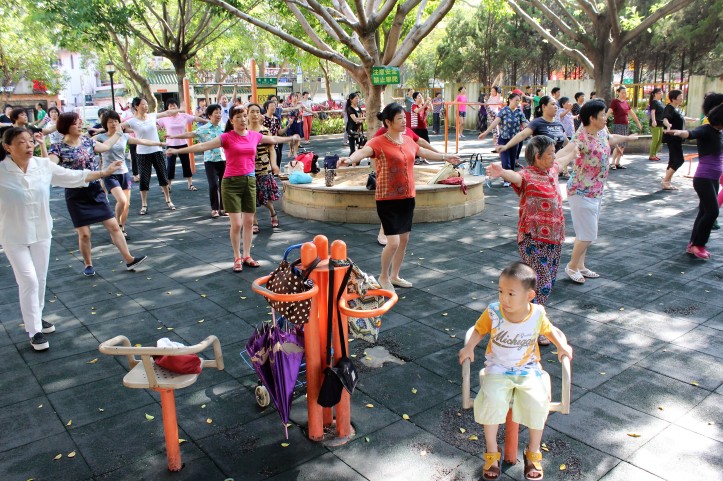
Almost, and I stress, almost an upskirt shot. Not by design, honest! ▼ 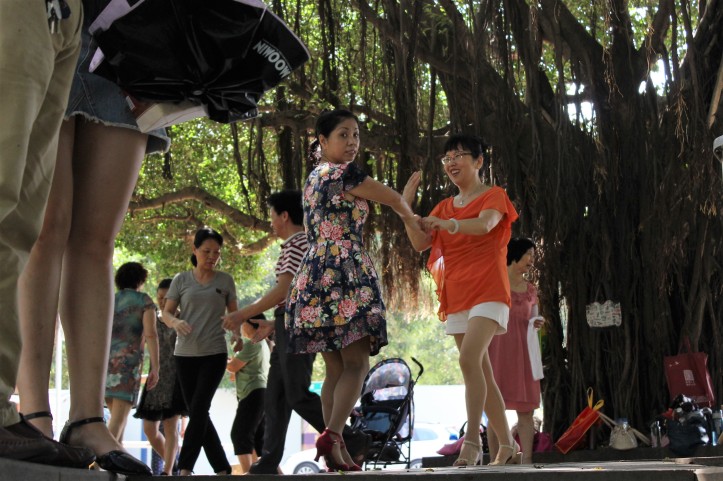
Wonder what these people were looking at? Search me, really! ▼ 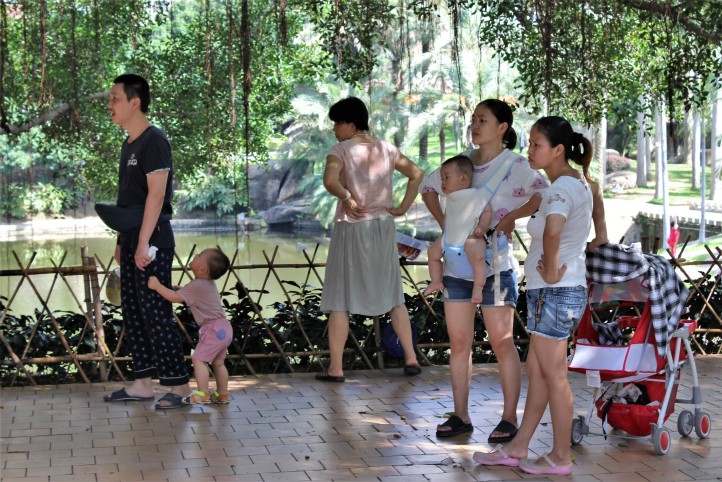
This seemingly multi-tasker apparently practicing his taichi and shooting the lotus leaves simultaneously……maybe. ▼ 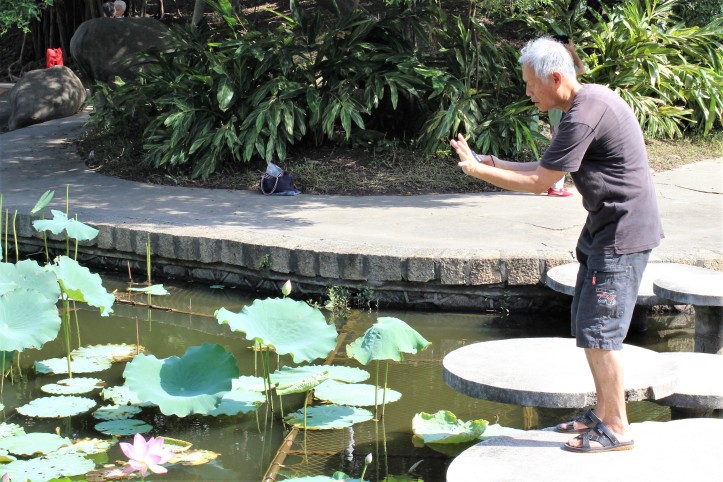
Other views of the pond-in-the-park. ▼ 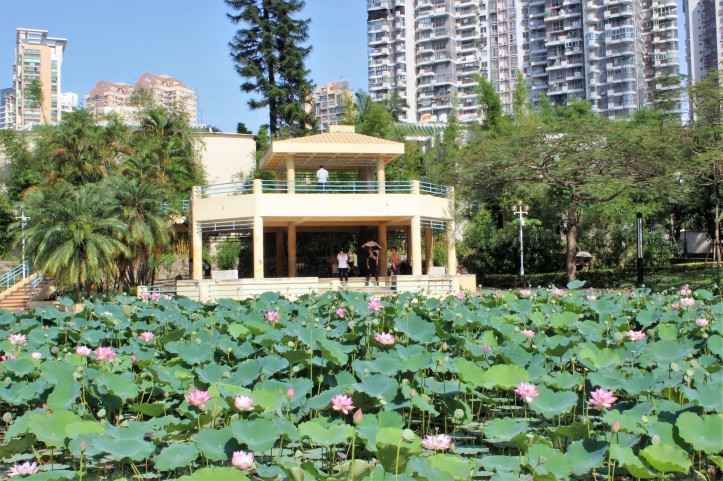
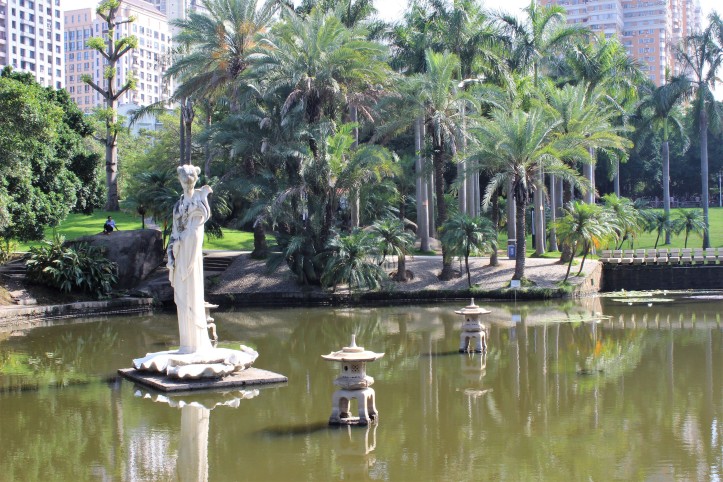
A helpful warden (?) attending to a damsel-in-not-so-distress. ▼ 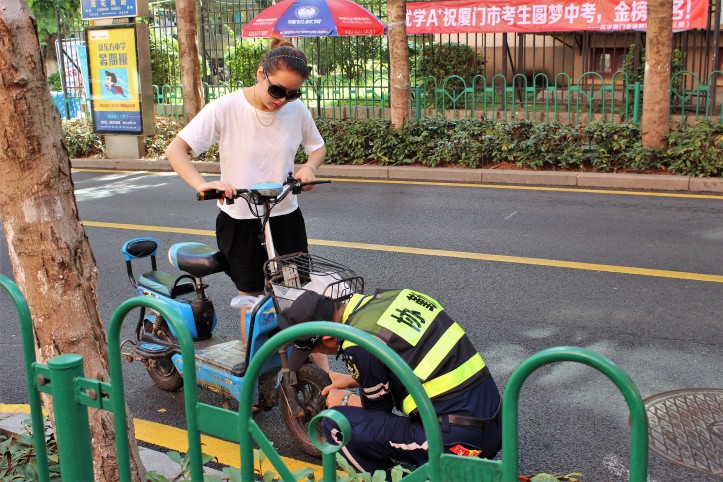
Xiamen’s BRT (Bus Rapid Transit) system, the first such in China. It has its own dedicated elevated roadway except at bridges where their specialized buses merge with regular traffic. It operates much like MRT systems, with similar stations and ticketing. Talks in the grapevines postulate that the buses will eventually be replaced by trackless trains called Autonomous Rail Transit (ART) now being developed by China. Watch: China unveils world's first 'trackless' train-World News , Firstpost ▼ 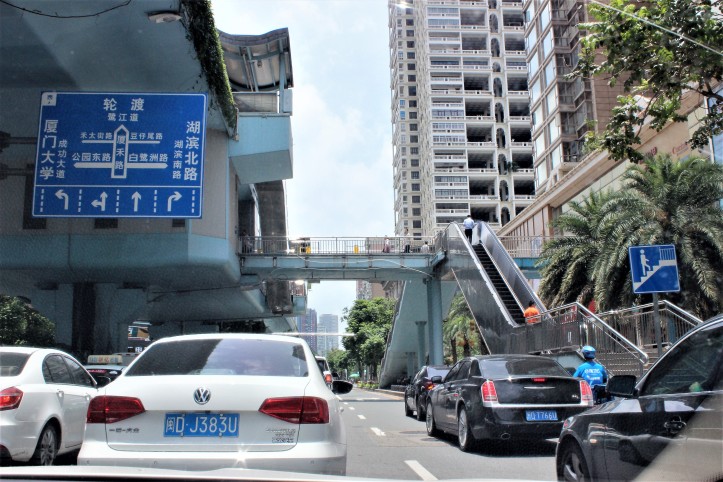
to be continued… … Next up: a cousin-ly meetup, and upclose to some Tulou or giant fortified earthen dwellings.
Part 2 of
Fujian & HK: quick revisits
A lunch visit to my China cousin’s newest office; his sixth such in Xiamen. He’s the youngest male of my generation, and the most successful. ▼ 


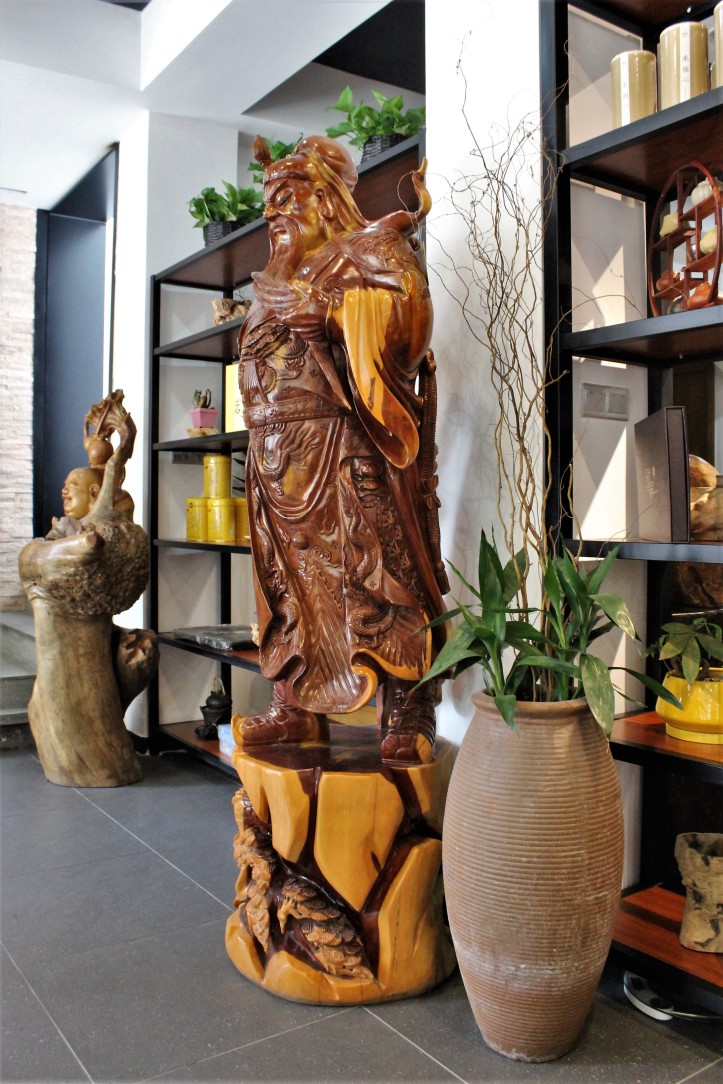
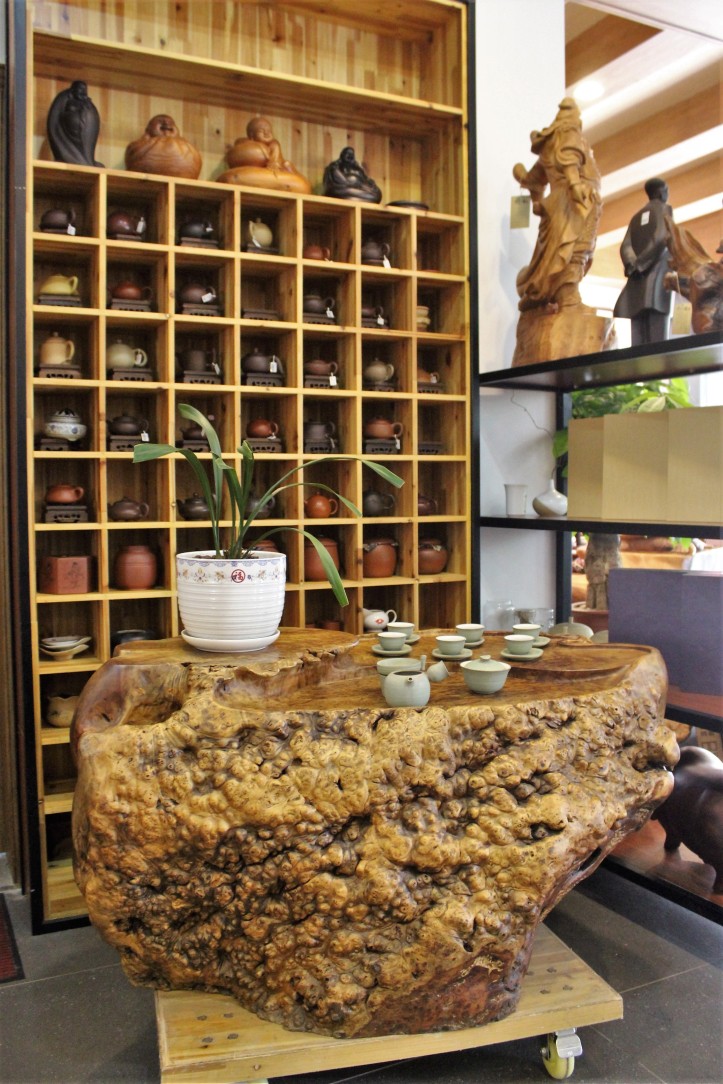
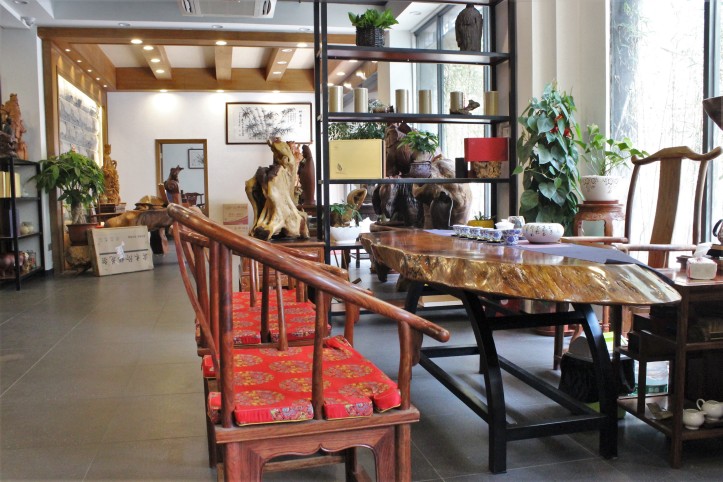
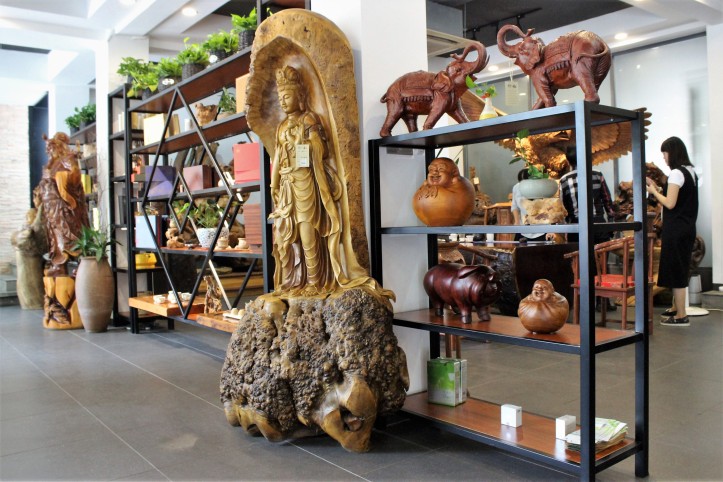
In-house Wine & Dine. ▼
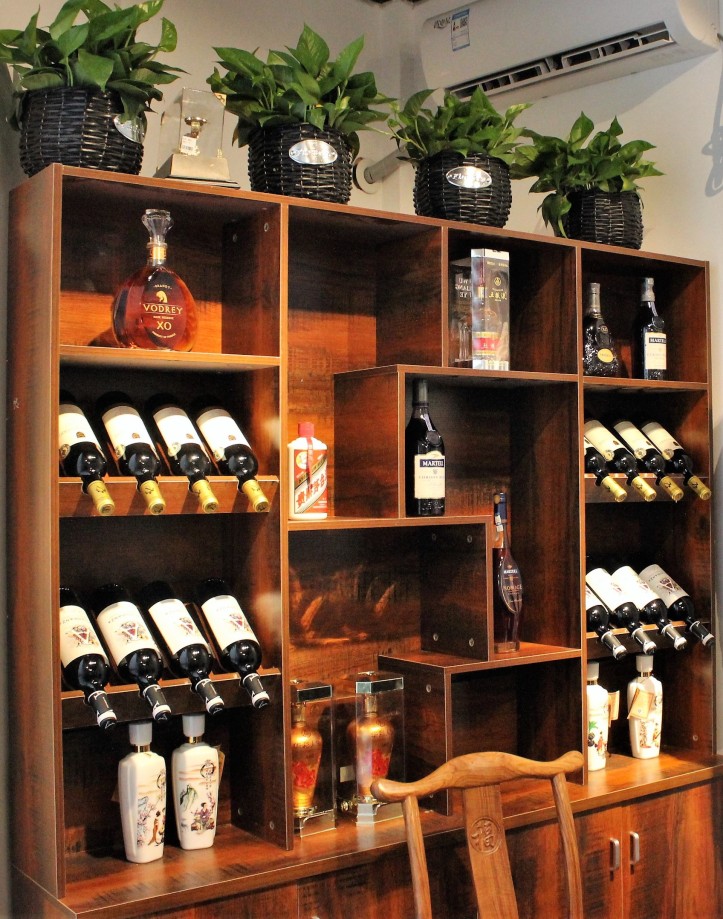
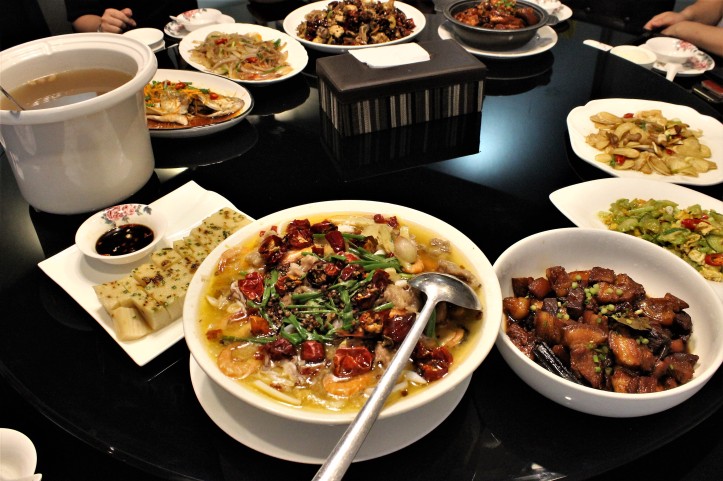
Somewhere in Xiamen is “Coffee House Street”, a row of almost twenty caffeine joints. Night owls rejoice! ▼ 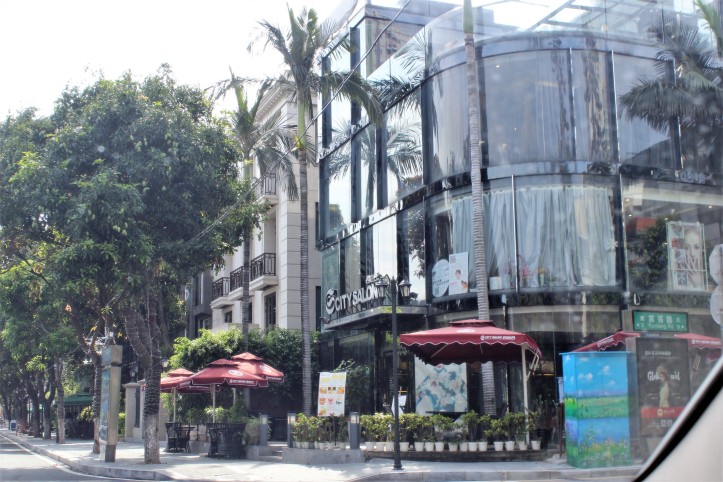
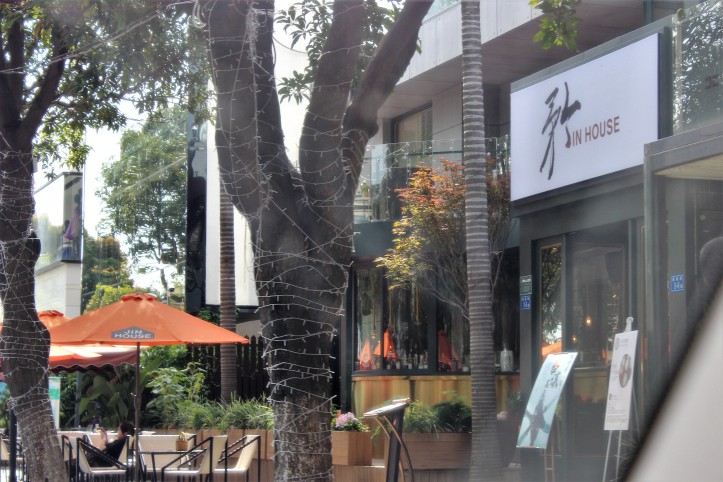
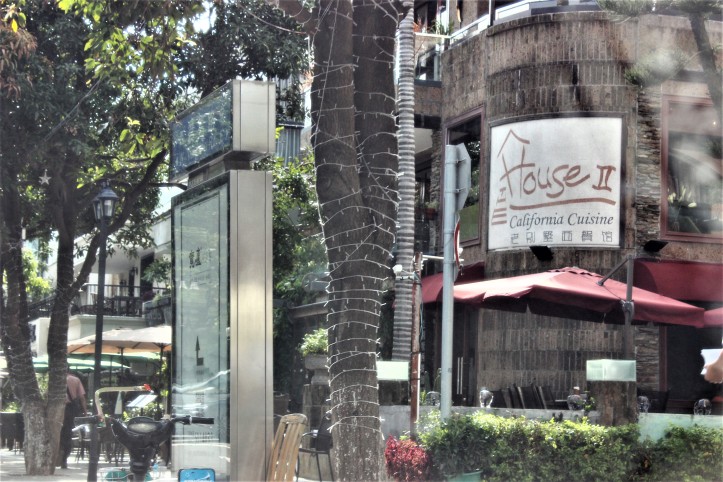
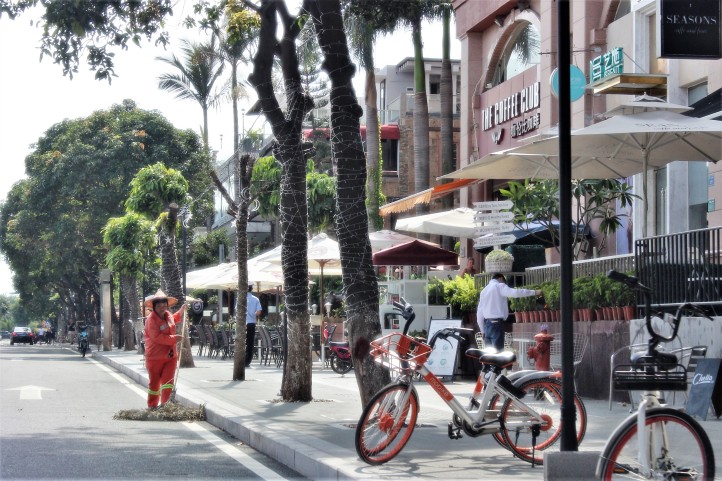
Adjacent to the stretch is a few watering holes of the alcoholic kind. ▼ 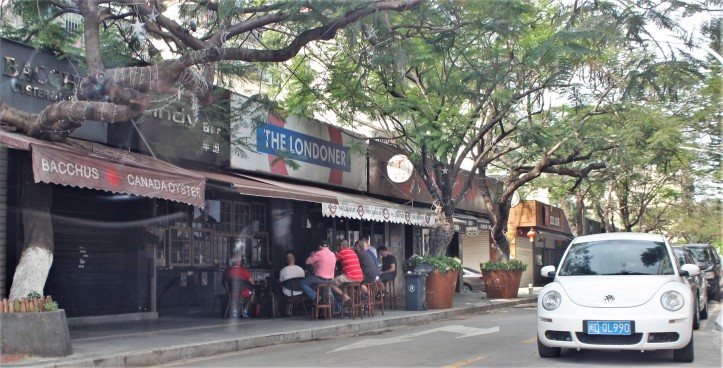
Their counterpart to our Sim Lim Tower electronics haven. ▼ 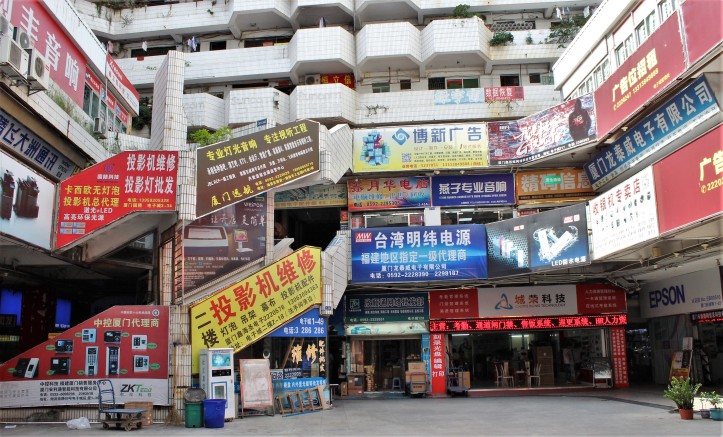
……and their version of Sim Lim Square. ▼
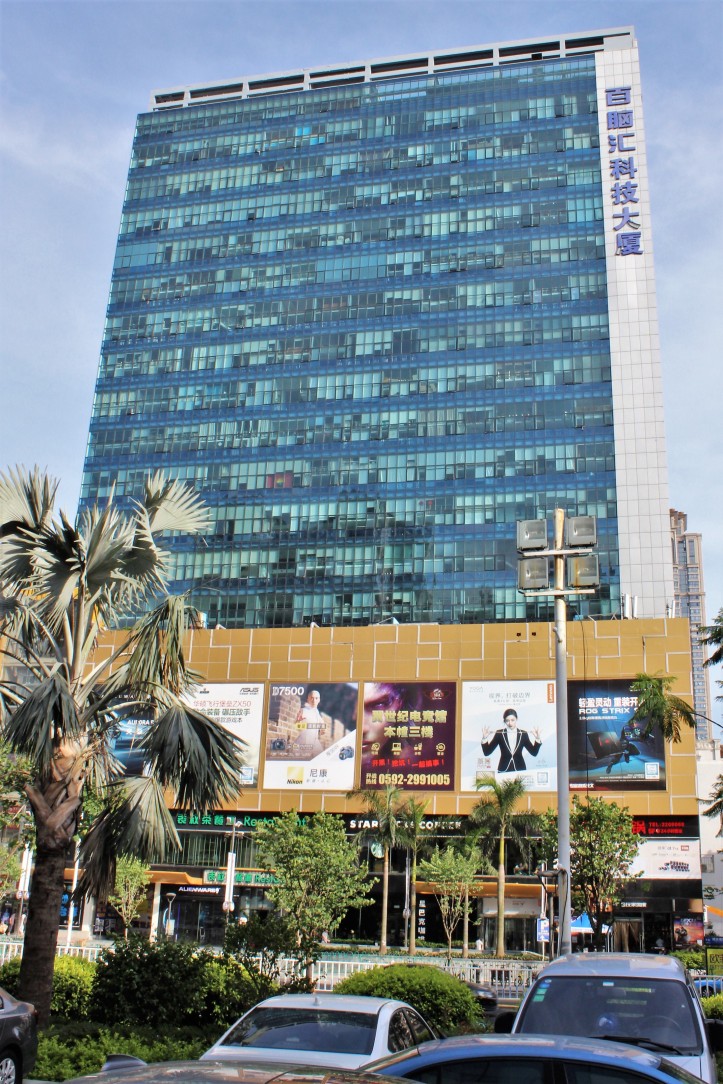
A bunch of wedding services enterprises. ▼ 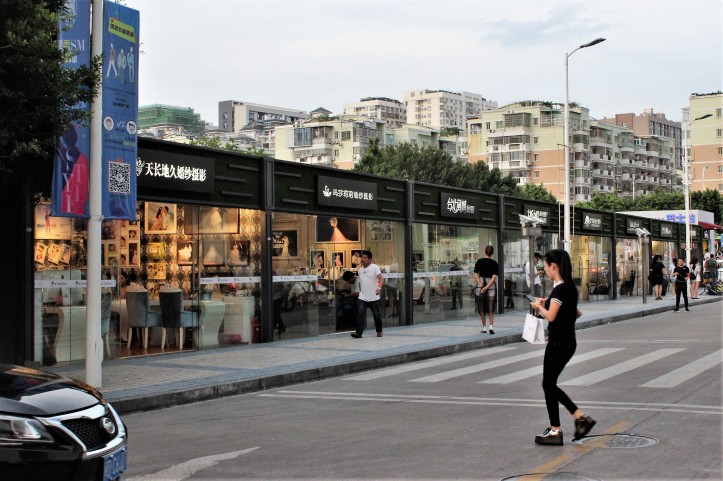
Tulou - massive earthern abodes: The dawn of another day, and the beginning of a journey to the Nanjing collection of Fujian tulou or earthen buildings. We set forth for the nearest such dwellings to Xiamen, called the Chuxi toulou group. It is an easy combination of a 45 minutes HSR and an hour’s car ride away.
A sea of humanity at the Xiamen Railway Station in town where we embarked on the first leg; to Nanjing county. ▼ 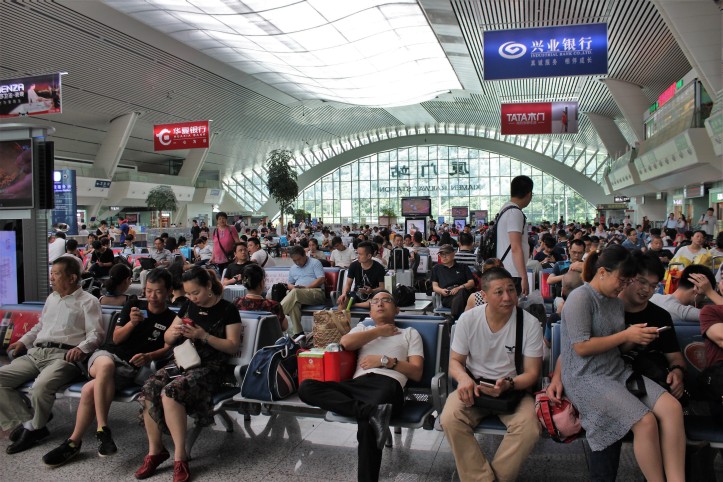
At rural Nanjing station, we encountered smiling & grinning lady food vendors who were ecstatically happy to have their pictures taken, hoping they will appear on TV and newspapers.
Dream on, aunties! From here on, the newer buildings and structures tend to mimic the architecture of the tulou, such as the centrepiece of the train station. ▼ 
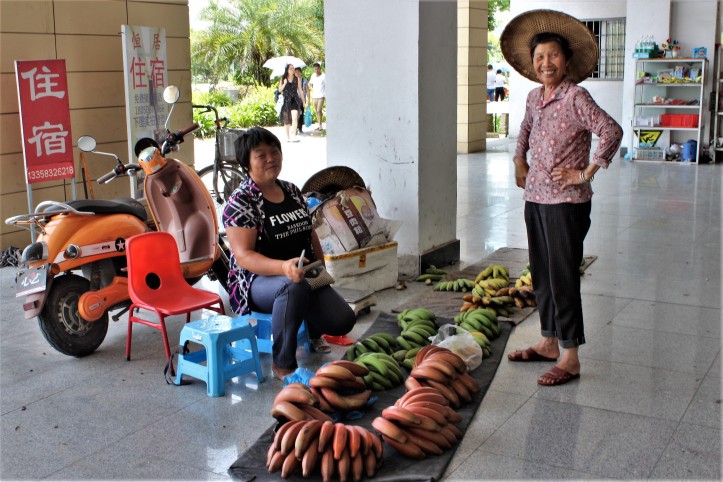
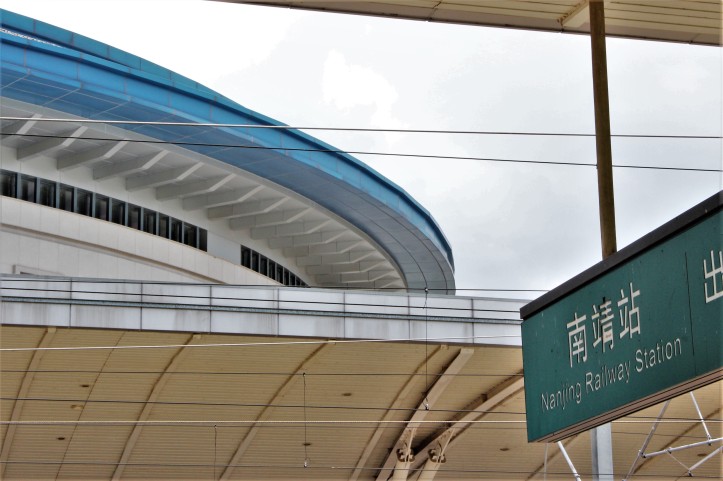
Just to be clear, what is being talked about here is Nanjing county 南靖县 meaning Southern Peace county in Fujian province as opposed to the similarly Romanized Nanjing 南 京城capital city of Jiangsu province which means Southern Capital or City. There are tens of thousands of tulou in China, mainly in Fujian, which are dwellings of the Hakkas or “Guest People”. These were constructed as long ago as the 14th century.
When early US reconnaissance satellites with their then low resolution cameras first captured the images of these mostly round (with some square and the rarer elliptical ones) giant earthen structures during the Cold War period, the Americans were shell-shocked by what they mistakenly surmised were nuclear reactors and missile silos. In a panic over what they thought were the overwhelmingly massive numbers of China’s nuclear arsenal, they dispatched ground spies to check them out. What a relief to those top brasses that it all turned out to be a huge false alarm.
A quick stop for lunch on the continuing road trip. ▼ 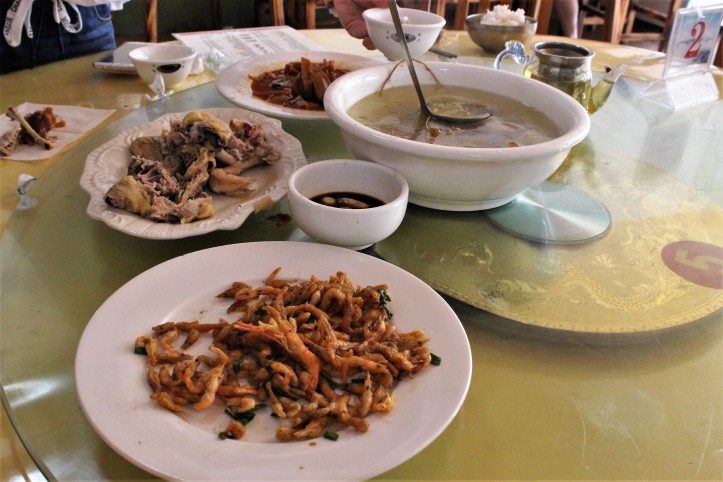
The more accessible (and touristy) Fujian tulou are mainly in Yongding and Nanjing. The first tulou group in our itinerary was the very much photographed Tianluokeng tulou cluster of four rotundas encircling a single square example, and some peripheral buildings. ▼ 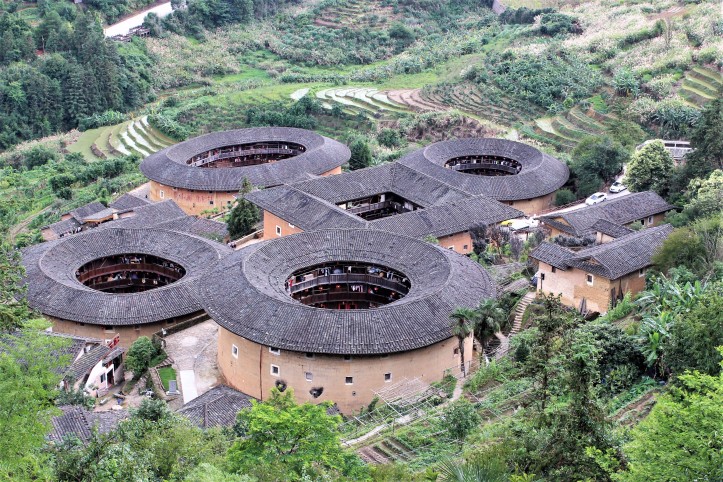

Pano shot by Nick inside one of the tulou of Tianluokeng. He was still on his feet after spinning himself 360 degrees from the centre of the tulou. Note his reference point of the structure’s entrance which appeared at both ends of the image. ▼ 
The square centre building of the Tianluokeng cluster. ▼ 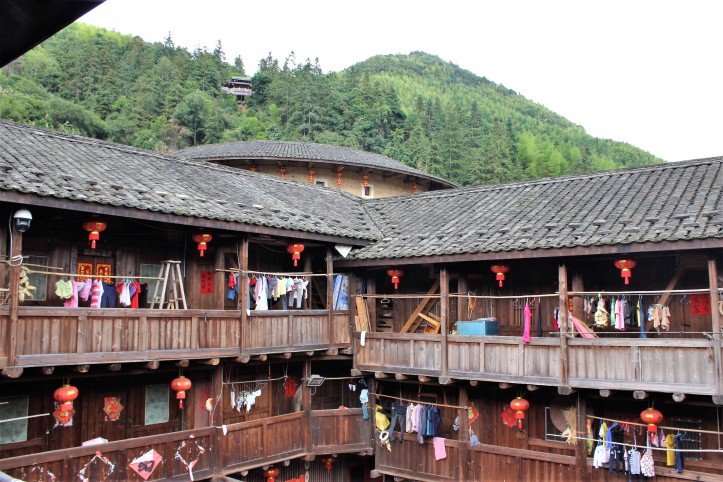
A top inside view of the same. ▼ 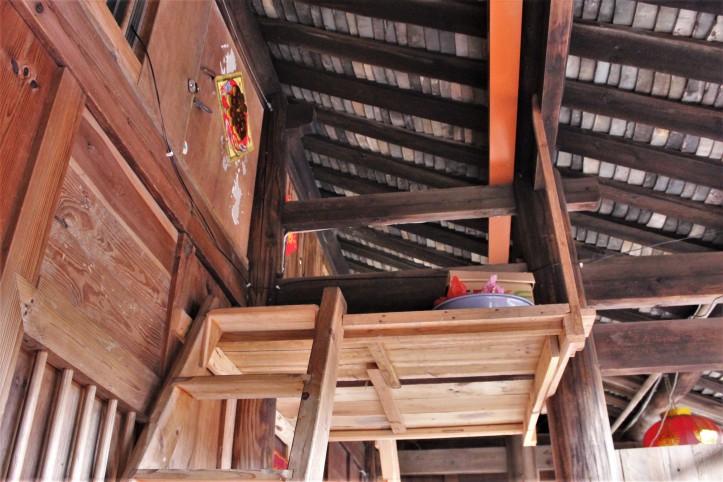
Dumpling leaves hung out to dry nearby. ▼ 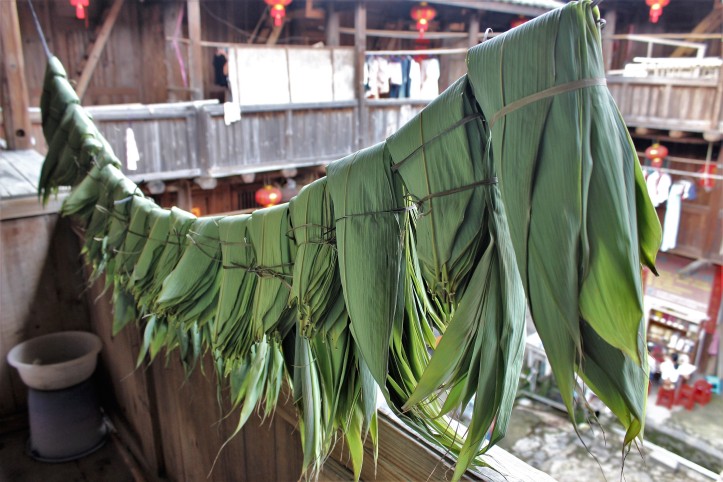
Two lasses engrossed in a game of badminton inside the compound of a smaller building. ▼ 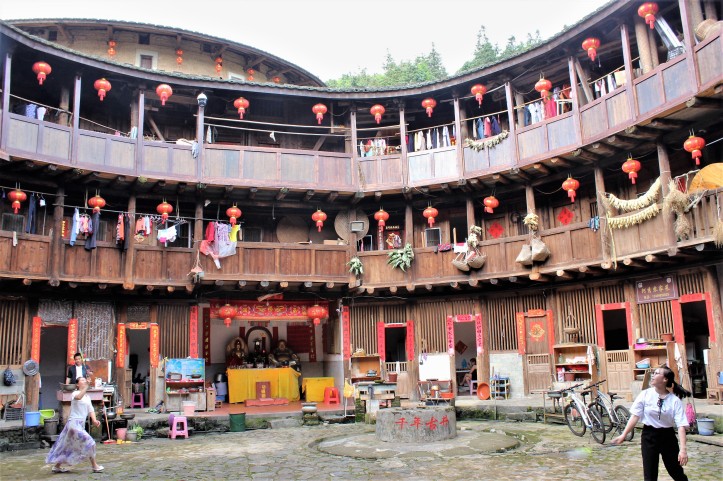
Some visitors being “entertained” by a stall selling tea leaves. ▼ 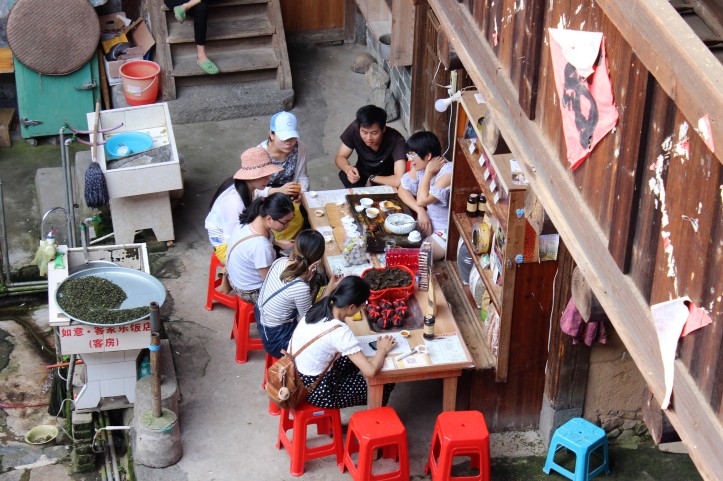
A scene of everyday life: that of a mother drying her child after a bath. ▼ 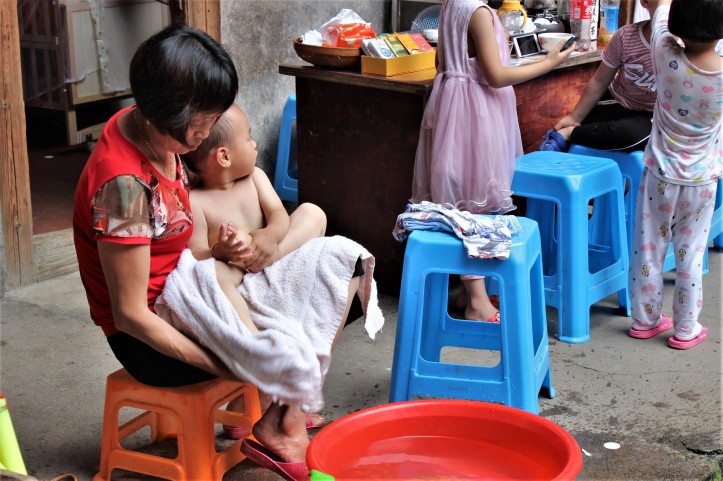
Feeding time. ▼ 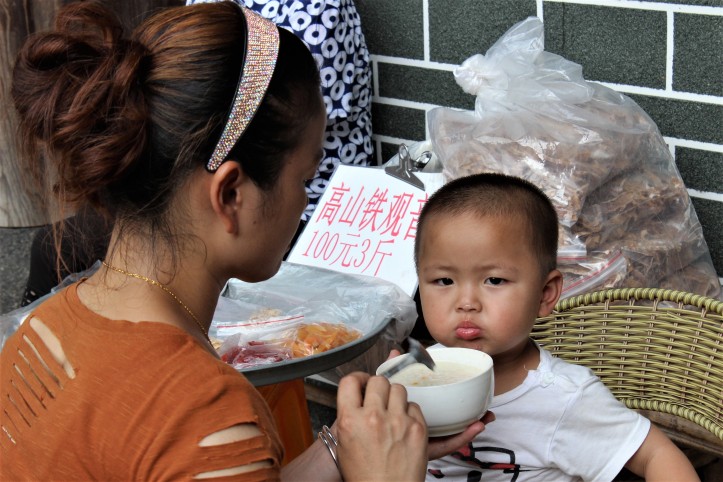
Patience, perseverance & persistence in slow coaxing were the order of the day to get this little girl to cooperate being her natural self for the camera. ▼ 

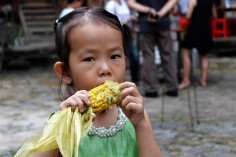


As for this old gal, its another story altogether. She kept on moving away expressionlessly upon the slightest hint of intention to snap her. Attempts to break her stoic countenance failed abjectly. Only the employment of tactical guerrilla shooting maneuvers finally yields a result just before she made herself totally scarce. ▼ 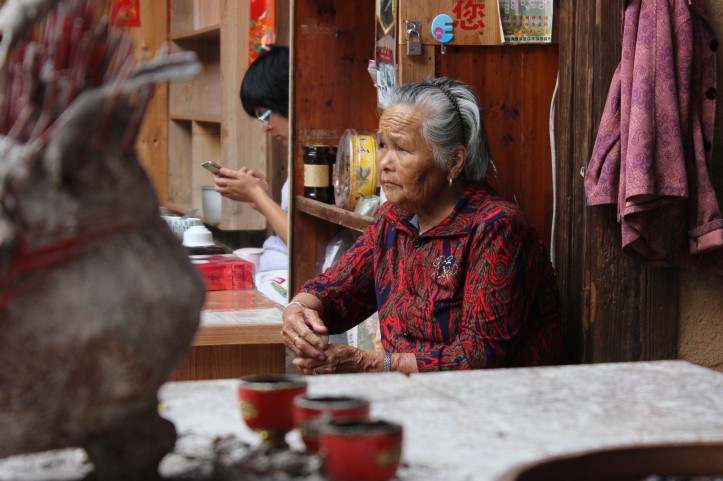
Not so this other of the same vintage. She wouldn’t give a damn either way. ▼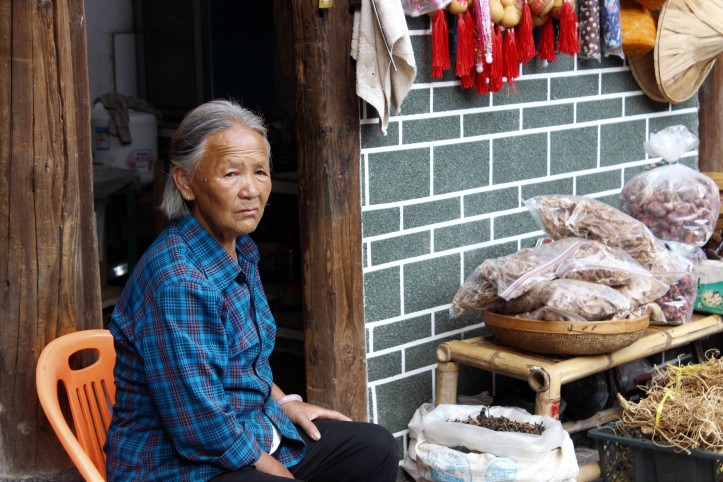
The most cooperative of them all is a certain Mr Xi but then “He” didn’t have any say in the matter, do he? Joke aside, that’s a tulou stall selling reproduction paintings to tourists. ▼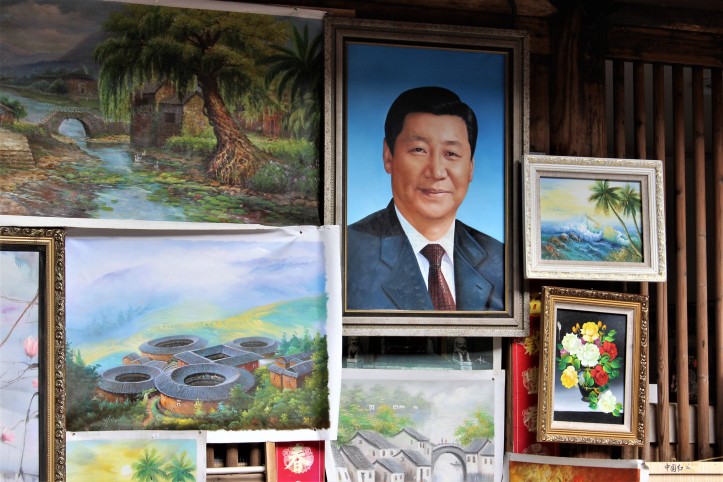
Old building, modern necessities of life. ▼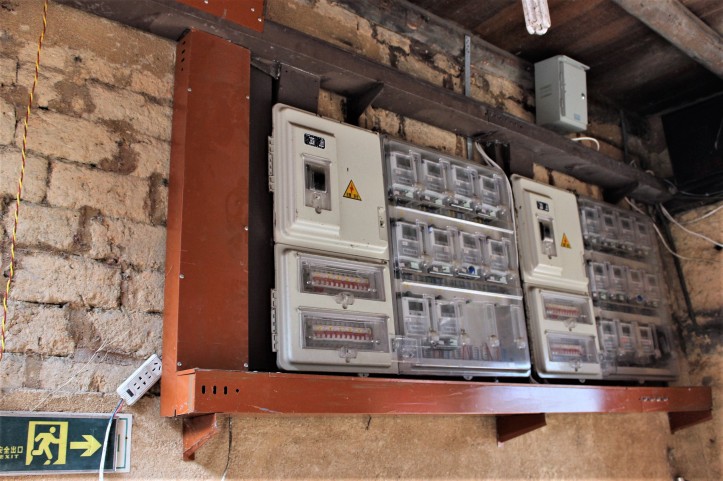
With these present-day gizmos, life is now a far cry from the old baby-making days of yore when there was nothing else to do at night. ▼ 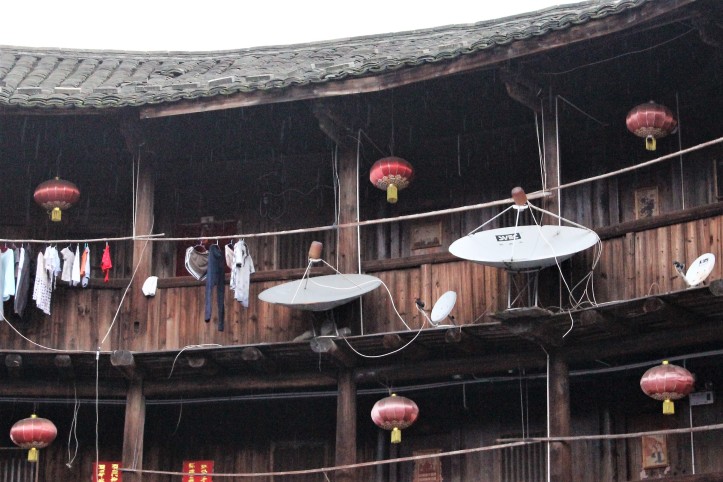
A good old door knocker. ▼ 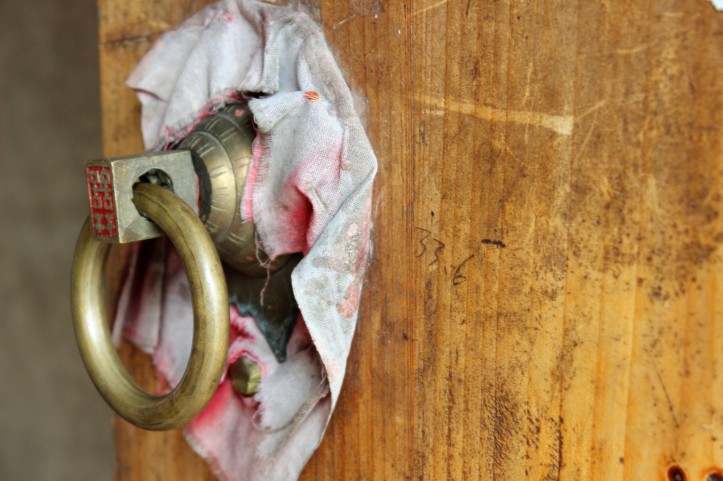
Closeup look at what make the tulou stand the ravages of time and weather: hardened rammed earth reinforced by an internal unsecured latticework of individual bamboo sections, this single exposed example sticking out like a sore thumb. ▼ 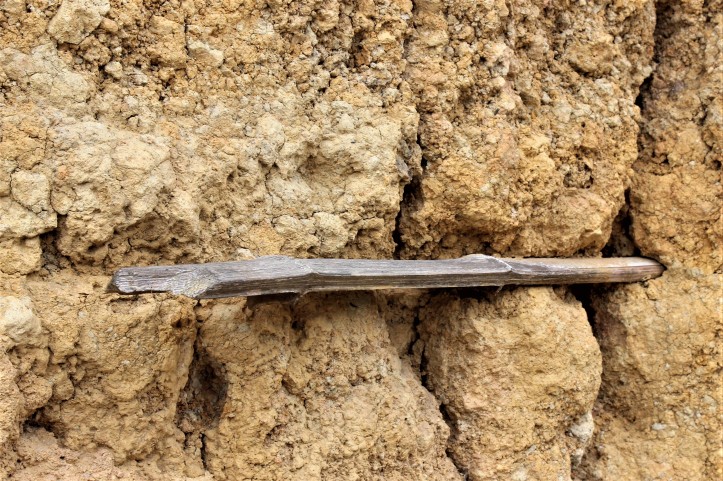
A near view of a roof. ▼ 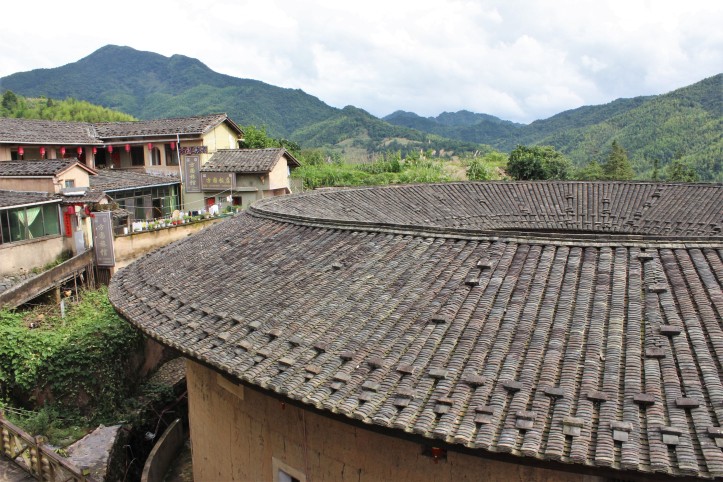
Directions. ▼ 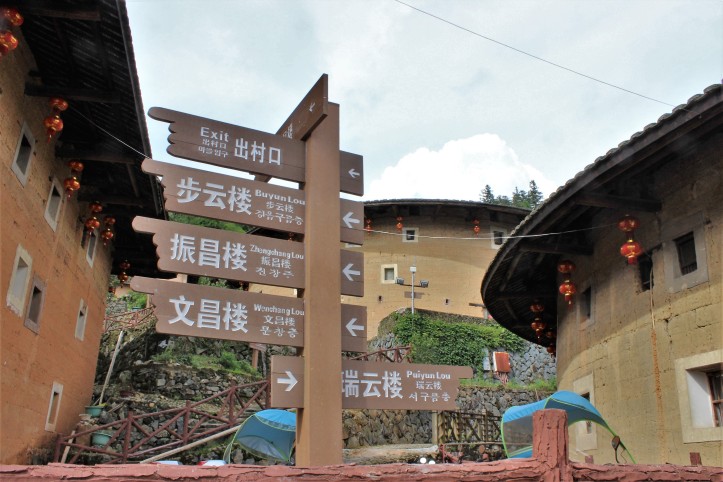
Yuchanglou built in 1308. This is a biggie; 36 metres in diameter, five stories and almost three hundred rooms. Note that the lower levels have no windows. This likely due to structural integrity reasons in the design. There are even larger toulou than this one elsewhere of above five hundred rooms. ▼

The picturesque delightful historical little township of Yun Shui Yao – which could be translated as “Song of Cloud & Water” – where we stayed for the night. The place, originally named Changjiao Zhen, was renamed after the blockbuster movie that was shot there a little over 10 years ago. I had initially planned to bunk down at a Tulou guesthouse but knowing Nick is not particularly enamored of roughing it out in a dinky ammonia-infused centuries old abode, we settled on this recommendation by my Xiamen-based friend. Good choice as it turned out. The second night pic below was shot at ISO6400, 1 second exposure – handheld. Well, I cheated by bracing the camera against the bridge railing as there is no way my hands can be that steady ▼
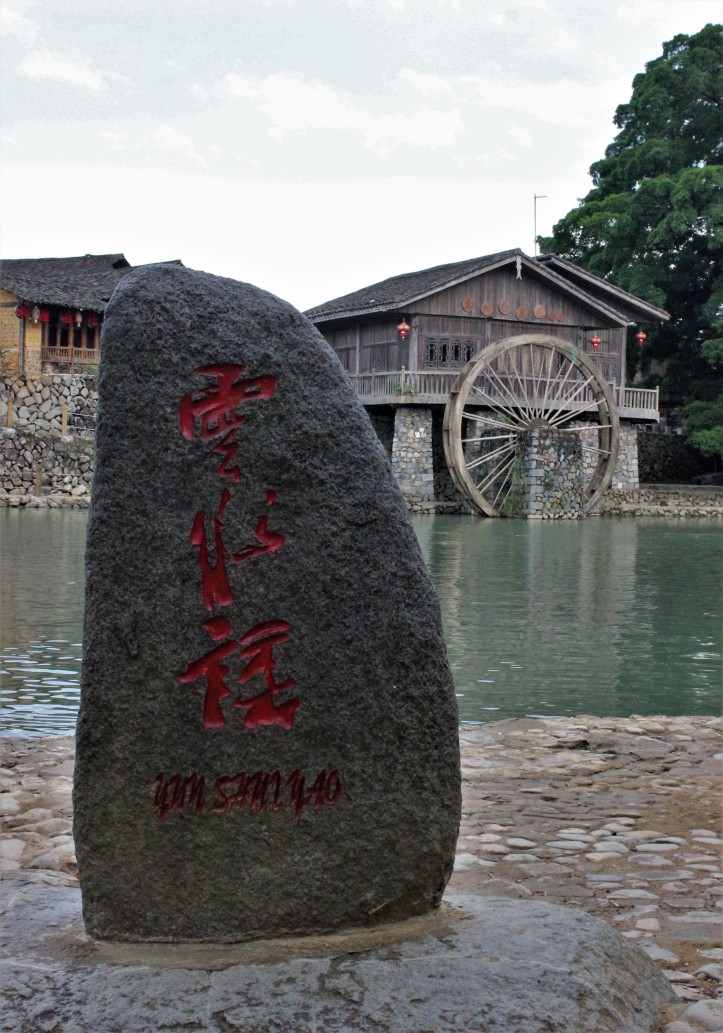
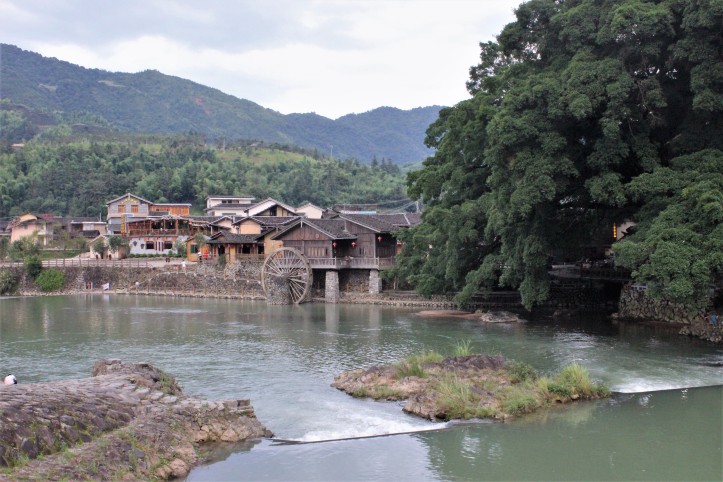
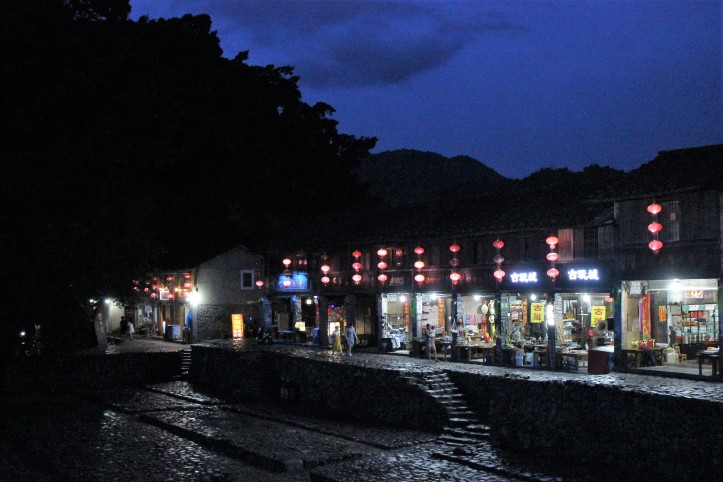
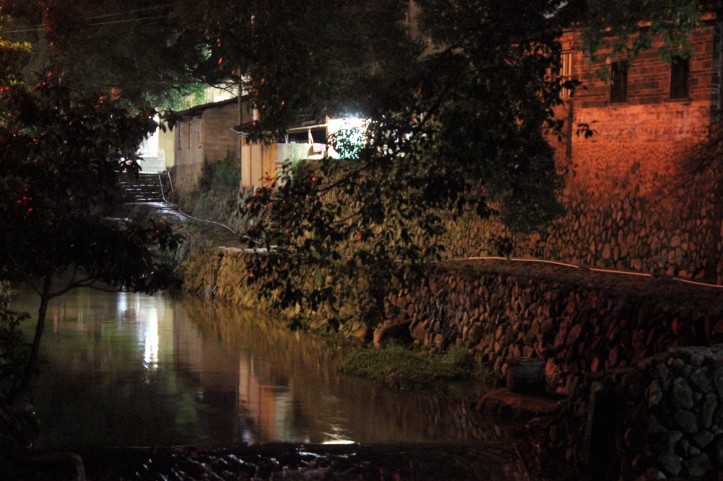
Walking around alone (Nick was down with the onset of a flu) late at night, I chanced upon a group of guys feasting merrily. I was invited to join in and I did; but only helped to consume the beer as Nick & I had a full dinner earlier. The young man on the extreme right is the son of Yun Shui Yao’s town chief. I was told his father had left a short while ago. ▼ 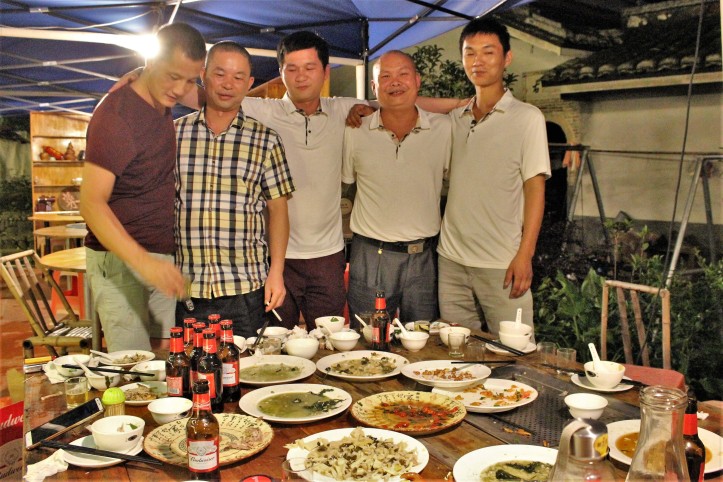
665 year old banyan tree near our hotel. ▼ 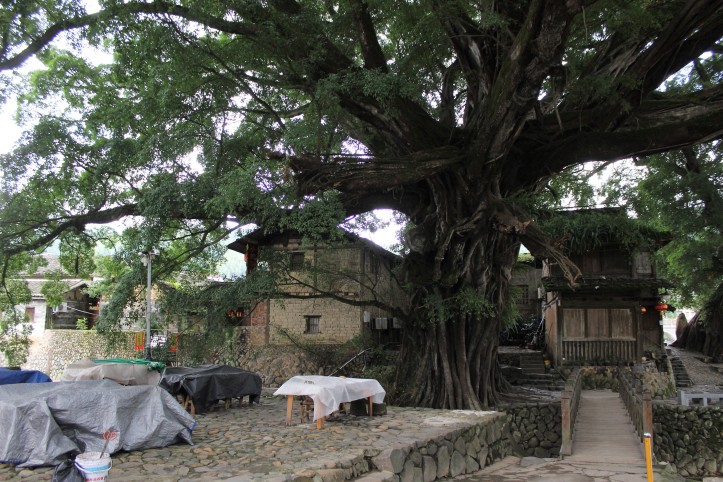
More eye candies. ▼ 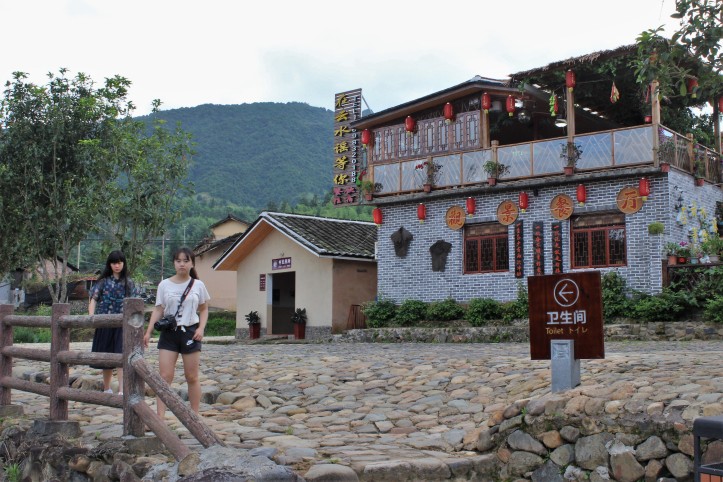
“Freezing” the water at 1/4000 sec shutter speed. ▼ 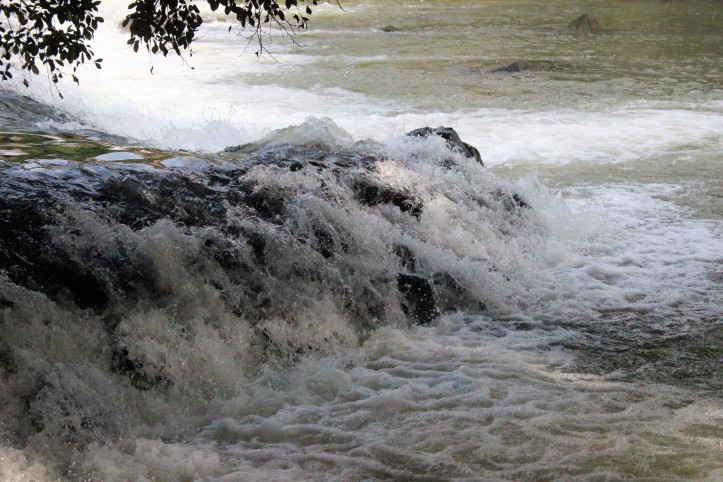
Doing the laundry by the river. Water is free, so our recent 30% increase in price not applicable ▼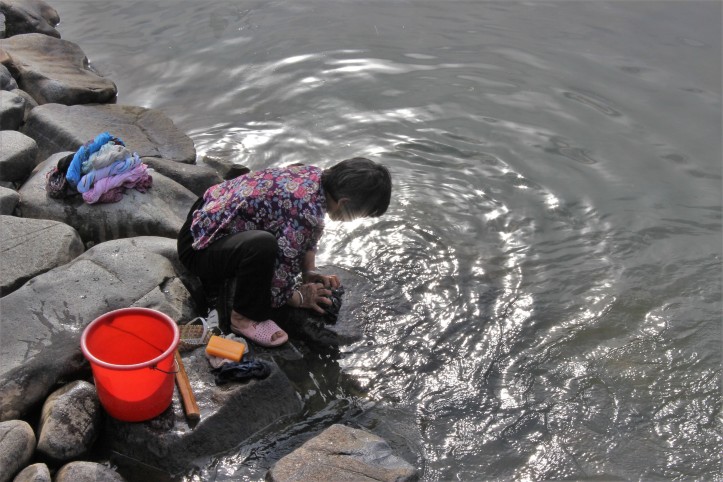
At Nanjing town, on our way to catch the HSR to Shenzhen from Zhangzhou. ▼ 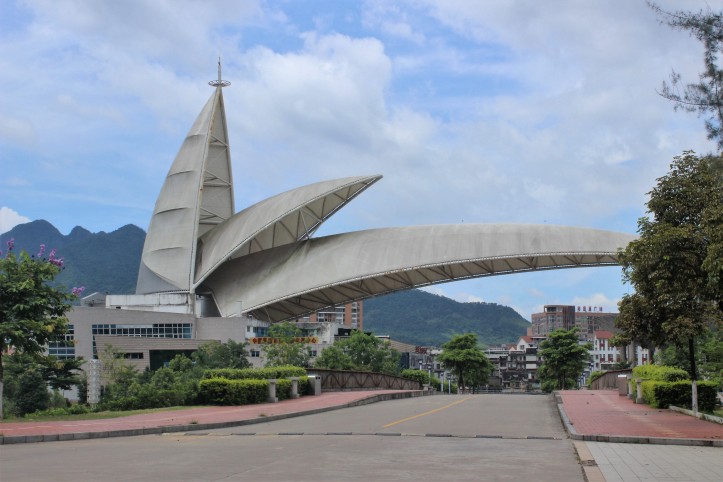
to be continued… … Next up: some earlier pics of Fujian countryside, and the return to Shenzhen & HK for the homeward flight.
Part 2 of
Fujian & HK: quick revisits
The massive exterior of Shenzhen North HSR Station, and its not even the building proper. ▼ 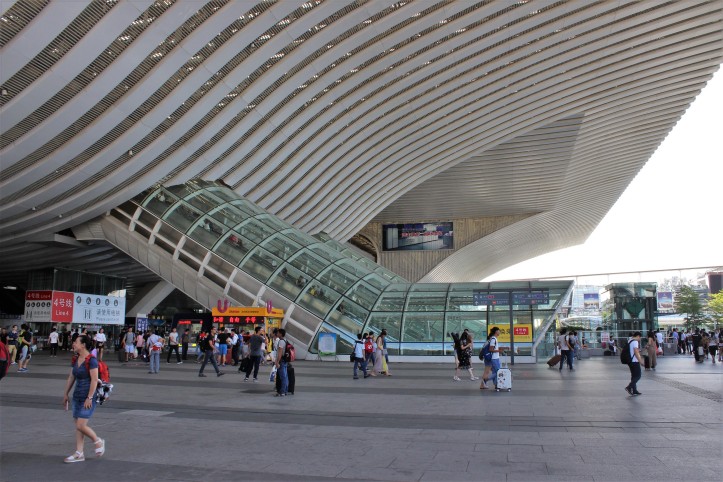
Here’s some pics taken on an earlier trip; in October 2014. Over at nearby Zhangzhou, stands the Changtai Shanchong Village with its labyrinth of majestic old stone buildings of a bygone era dating back from between the Qing Dynasty’s Jiaqing & Daoguang periods of 1796 to 1850. The grand rolling hills of blooming flowers in spring instills a nostalgic feel of being transported back to the idyllic times of traditional rural life. The Village is variously referred to as the Shangri-la of Fujian, and a miniature Ukraine; a resource-rich and scenic nation hived off from the breakup of the erstwhile Soviet Union. ▼ 
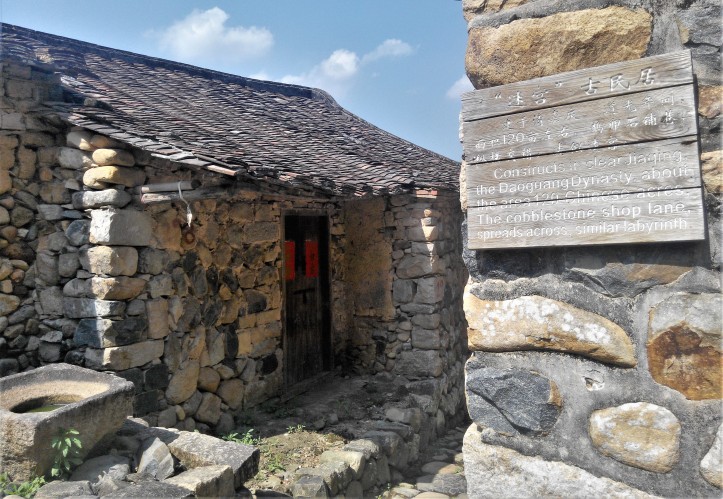
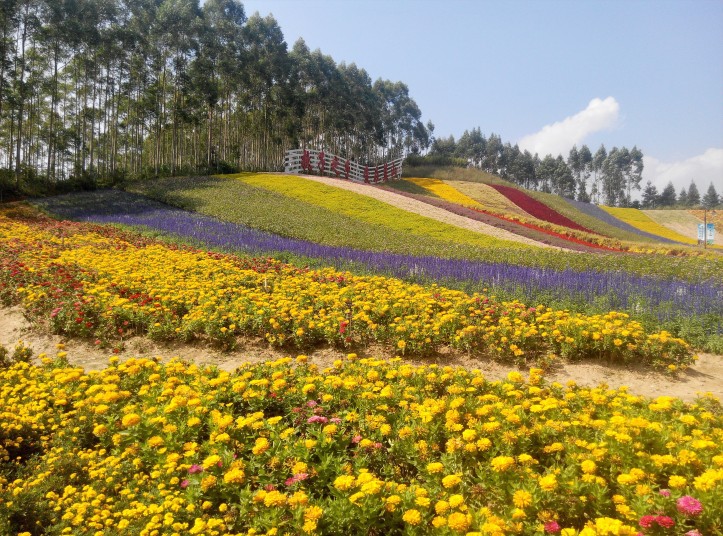
I shan’t say much and will just post a few pics on HK for this trip. Maybe more on the Fragrant Harbour some other time. Then again, maybe not. It depends. Anyway, I got back to Kowloon from Luohu in the morning of the day before our flight home, leaving Nick in Shenzhen to continue his lone – but hardly lonely – Tiongkok (middle kingdom) adventure for another night. There isn’t much I have not seen and done in this former British Colony, so I just wandered around the Tsimshatsui and HK island area.
As was my usual mode when passing just a night or two, I parked myself in one of the numerous budget lodging houses & hostels in the famed Chungking Mansions. With almost 2,000 (mainly tiny) rooms in total, I found no need to book in advance. If one of the guesthouses is full, just go to another; I never have to go beyond my third attempt even in high seasons. Options range from a bed in a dorm or private space of varying sizes to family room for 4 pax (maybe even more; I didn’t check). For me it’s just a bed for the night and an en-suite toilet/shower in a miniscule clean airconed roomlet is all I require since I spent only a few sleeping hours inside. This recent one cost me HK$150/USD19.
Like a narcissist’s phallic symbol, the island’s tallest building at 412m, the 2IFC or Two International Finance Centre towers far above anything else man-made. ▼ 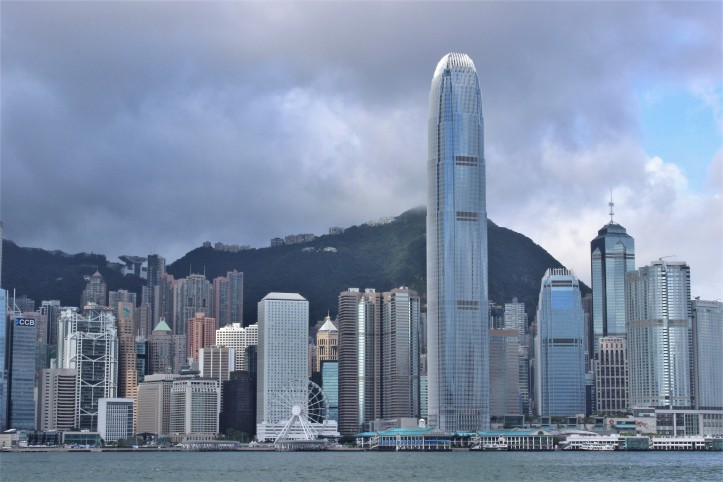
Still, just across the waters, in Kowloon rising 484m is a higher giant; the International Commerce Centre or ICC which came into being eight years after 2IFC. ▼ 
HK’s very own iteration of the Singapore Flyer; the much shorter HK Observation Wheel at 60m vs the former’s 165m. ▼
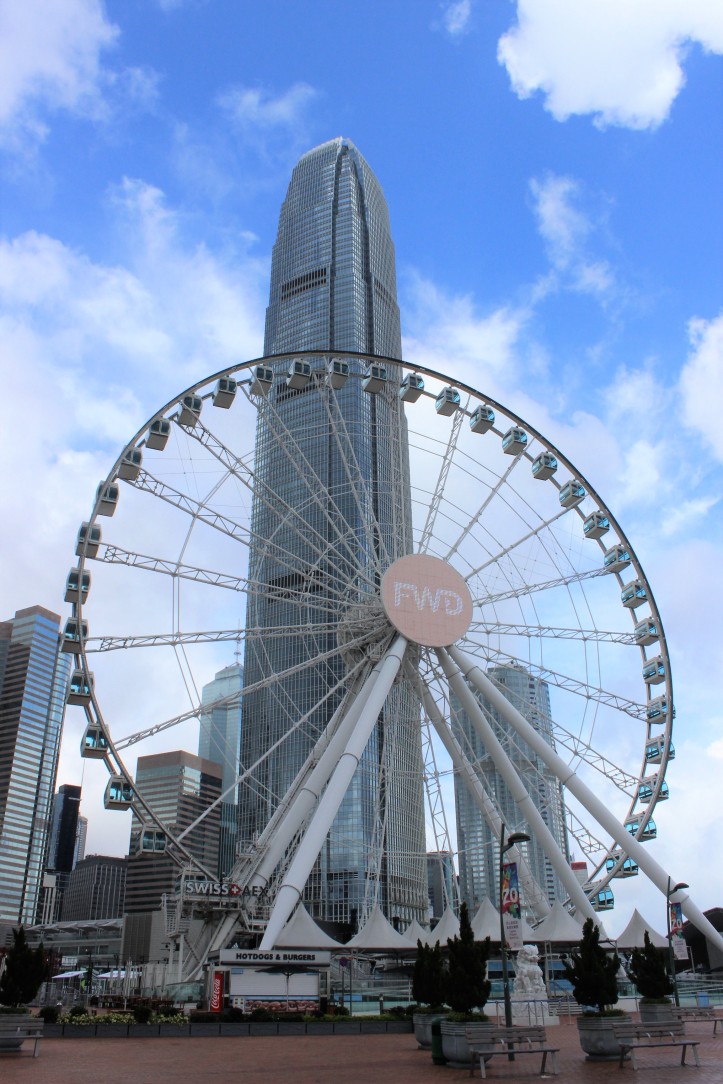
It’s already late morning and to preempt the expected huge lunchtime crowd, I made a beeline for the nearby Tsim Chai Kee eatery for a bowl of their heavenly prawn wanton mee. It’s situated at Wellington Road in Central, just beside the world’s longest outdoor escalator. A steal at HKD29/USD3.80. Just across the road is another shop that hawks the same fare that others swear by; Mak’s Noodles. The latter has recently branched out to Singapore, with multiple outlets. ▼ 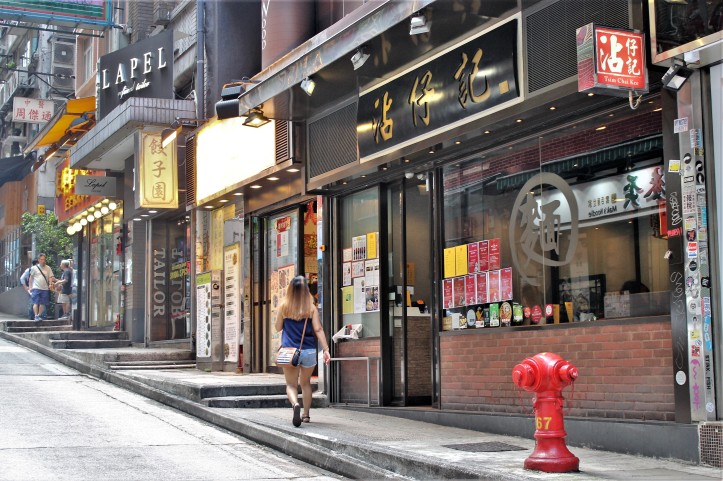
With the whole afternoon to while away aimlessly, I decided to do what I had never done before on the tram; ride it all the way to the east of the island. I have utilized this iconic transport system on the island donkey times but all always on short hops. Ok, so with a big 500ml can of ice cold beer in hand, I headed straight up to the upper level for a grand view. Not many passengers there and I was able to take a front seat all for myself during the entire one hour plus journey. Enjoy the ride as never before!
Seat with a view. ▼ 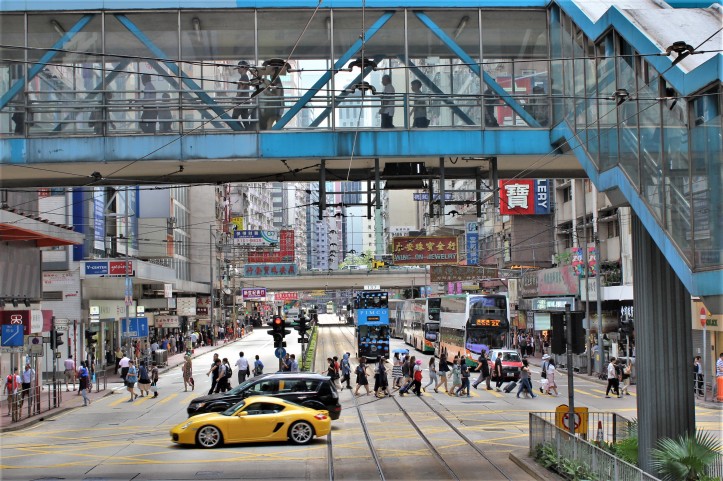
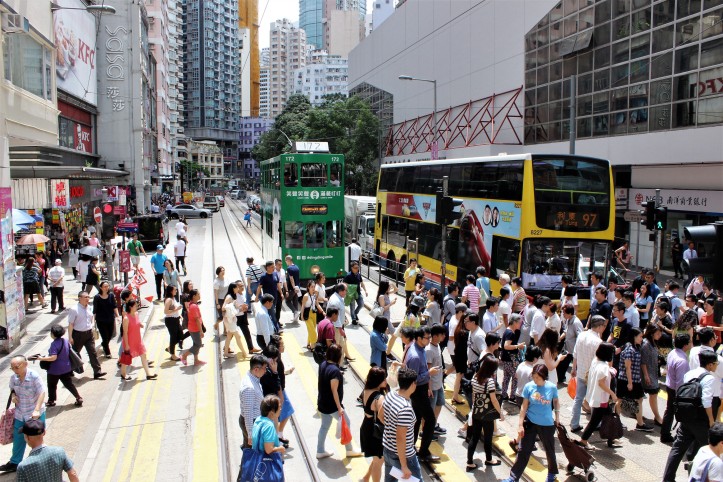
Two similar but yet different food delivery services, one modern and the other legacy, serving the same customer destination. Everything about them is a study in contrast. Apparently both can still co-exist……at least for the present. The future? Always in motion it is! ▼ 
At nightfall, with a little more time to spare, I headed to the centre north of the Northern Territories to visit relatives-in-law whom I bunked with the first time I set foot in HK……32 years ago. This is where they now stay; Heng On Estate in Ma On Shan. A jetliner was – on landing approach to the airport some 20km away – flying overhead as I got to my destination. Camera at ISO6400, hence the grainy look. ▼ 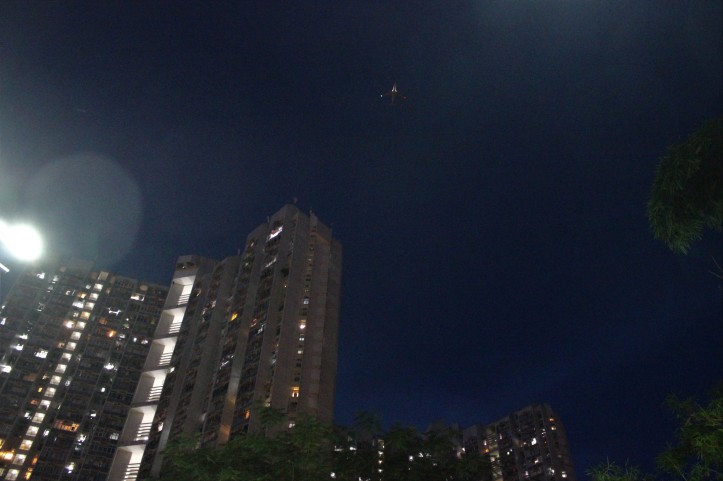
Waiting for our flight home……and no, that’s not our plane. We were early, man! As it were, Nick and I were together on HK soil only at the airport, twice. Once when we went off in separate directions upon landing and again when we met up to check in for the homeward leg. ▼ 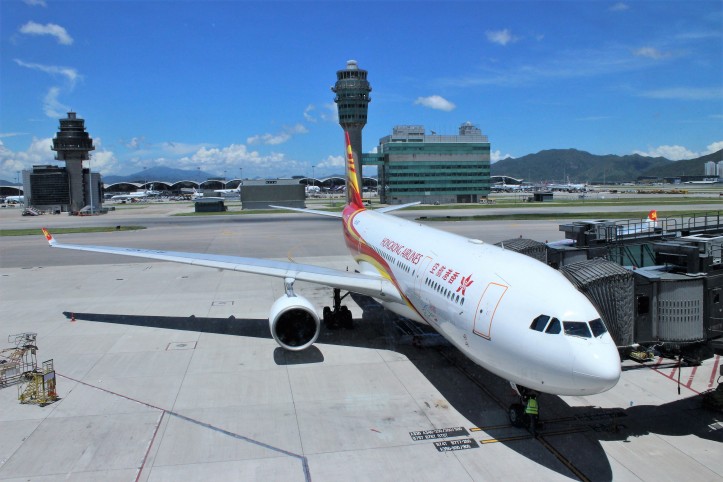
Phew! That’s my longest post yet on this blog, pictures wise. My next detailed musing & scribbling will be at year end, after a two-week long swing to Bangkok, Chiangrai, Hatyai & KL in November & December. Till then…. Oh wait, I still have my August and September/October regular visits to Manila/Angeles City and Jakarta/Yogyakarta respectively. Then again, I’ll likely be short & sharp about them……maybe.
the end… … … and coming up: the Armed Forces Museum, Jakarta
Stab in the dark - llyn Clwedog just outside Llanidloes.
Trying to think of places that have steep valleys and a dam slipway.
Edit
It’s Llyn Brianne
Oh yea Lyn Brianne, now that name does ring a bell now…thanks!
Part One
Jakarta Armed Forces Museum
MUSEUM DIRGANTARA MANDALA WAS FIRST OPENED ON APRIL 1969 IN JAKARTA AND SUBSEQUENTLY RELOCATED TO THE CENTRAL JAVANESE CITY OF YOGYAKARTA NINE YEARS LATER. DURING MY MANY BUSINESS VISITS IN THE 90S AND 00S TO THIS HISTORIC FORMER INDONESIAN CAPITAL OF 1945 TO 1948, I NEVER HAD THE OPPORTUNITY TO DROP IN TO VIEW THIS INDONESIAN AIR FORCE MUSEUM’S FINE COLLECTION OF ABOUT THREE DOZEN RETIRED WARPLANES. I WILL MAKE THE EFFORT ONE DAY, BUT IN THE MEANTIME THERE IS A SMALLER NUMBER OF OVER A DOZEN IN JAKARTA’S ARMED FORCES MUSEUM AWAITING A QUICK LOOKOVER, WHICH I DID ON THE 5TH OF APRIL.
Aircraft only constitute a part of Museum Satria Mandala’s exhibits as it does not specifically showcase the air force but the whole Indonesian armed forces’ history and tradition. Getting there is a snap as the Transjakarta Busway corridor 9B has a stop – namely Gatot Subroto Jamsostek – just a few minutes’ walk from the museum entrance. The route originates from Kota station in the north and ply southward along the major roads of Jl Hayam Waruk, Jl M H Thamrin and then JL Jend Sudirman before turning left southeast at the Semanggi interchange to JL Jend Gatot Subroto.
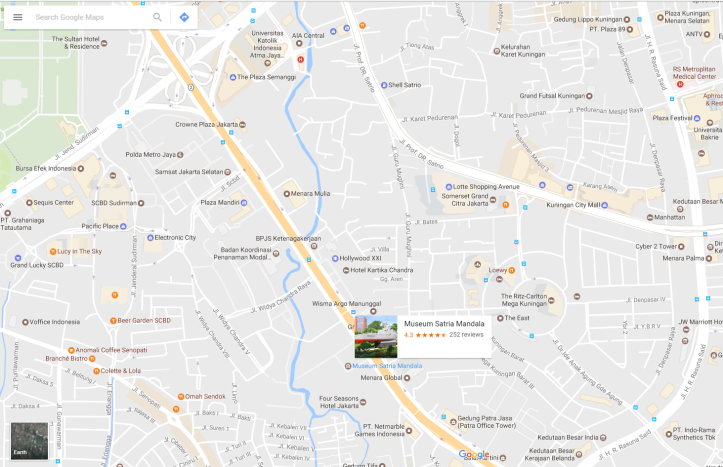
There are tanks and other military ground vehicles plus big and small guns, and a patrol boat but these don’t really interest me. The outdoor and shed displays are free to visit but entry into the museum building carries a Rp4,000 (SG$0.40) tag on the ticket though the guard asked for Rp10,000. What the heck, but there’s no point wasting time and saliva arguing over that tiny fortune. There are tons of dioramas depicting war scenes and loads of military paraphernalia plus plenty of information on top generals including Suharto. Gun freaks would, well, freak-out over the plethora of small arms on display.
On to my fave subject; airplanes. From the Busway stop, just after passing the Four Seasons Hotel, I entered the museum grounds through a side foot gate since the main affair is further up the road. Immediately on my right is a Mikoyan-Gurevich MiG-21 Fishbed, by far the most produced supersonic aircraft in world history. First built in the mid fifties, the “pencil” had rolled off the factory floor for 55 long years (including the Chinese J-7/F-7 variants), and the later generation versions are still in the service of about 30 of the world’s air forces. 3D printing tech has also given an extended lifeline to this geriatric warbird, with out-of-production parts being made available on demand. Of the two dozen or so Fishbeds in the Indonesian fleet, 13 ended up with a USAF Aggressor Squadron in exchange deals for T-33 Shooting Star, F-5 Freedom Fighter, OV-10 Bronco, and UH-34D Seahorse helicopter. ▼
Right beside the MiG is a Soviet era high-altitude surface-to-air missile, the S-75 Dvina or SA-2 Guideline in NATO-speak. Fourteen of the Dvinas were fired at Gary Powers’ U-2 spyplane in the much documented May 1960 reconnaissance flight over Russia. In that incident, one of the fourteen SAMs also downed a pursuing Mig-19 in a case of “friendly-fire”. In the background is the last of the trio of air vehicles fronting the main road; an early model of the ubiquitous Bell UH-1 Iroquois. ▼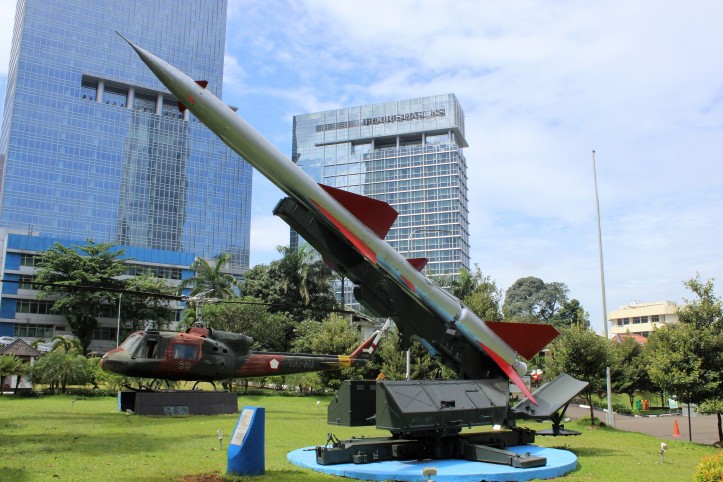
Moving on to the front of the main museum building is the Douglas A-4E Skyhawk which according to the plaque was inaugurated as a display just three weeks prior. As Skyhawks are very close to my heart, having serviced numerous units for almost 12 years, allow me to delve into more details of this particular bird. With the bureau number of 151079, it was “born” in April 1964 and saw service at various US Navy and US Marine corps squadrons till it was transferred to the Israeli Air Force in September 1972. A little over a year later, it saw action against Egypt and Syria in the Yom Kippur War. It also participated in the Lebanon War of 1982. In 1985 Indonesia bought it as part of the 37 strong Skyhawk fleet acquired from 1979 to the 1980s. It found its Asian home at 12 Squadron in Pekanbaru Air Base and was then transferred to 11 Squadron at Sulawasi’s Hasanuddin Air Base in 1996. After retirement in August 2004, it was placed in storage till its final designated abode at the museum. ▼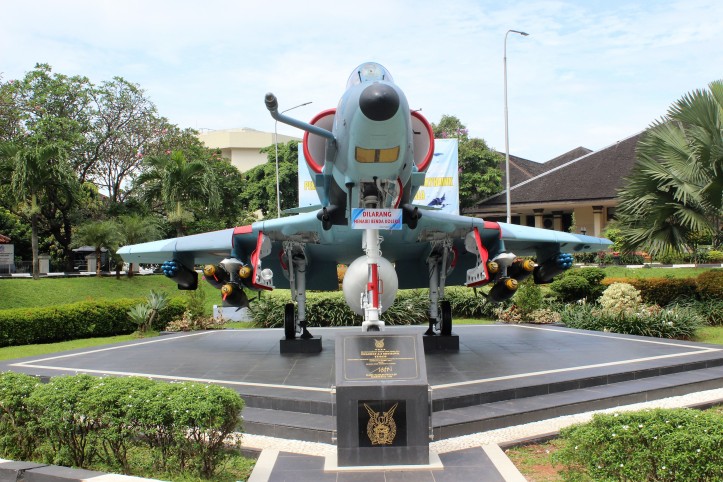
To the left and back of the building are 12 more vintage planes; three at the mercy of the elements and nine with roofs over them. First to meet the eye is WWII medium bomber North American B-25 Mitchell, acquired from the Netherlands. Next is Sukarno’s presidential transport with tail number RI 001, a Douglas C-47 Dakota. At the extreme end sits the Mil MI-4, a Soviet workhorse transport helicopter which is a larger lookalike of the US Sikorsky H-19 Chickasaw. ▼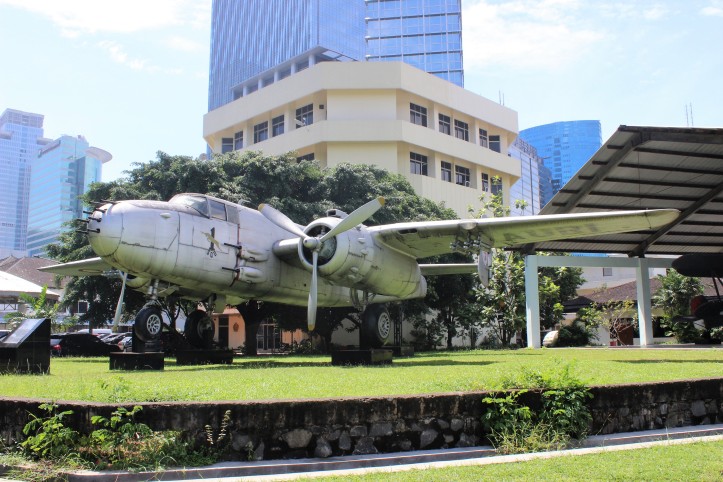
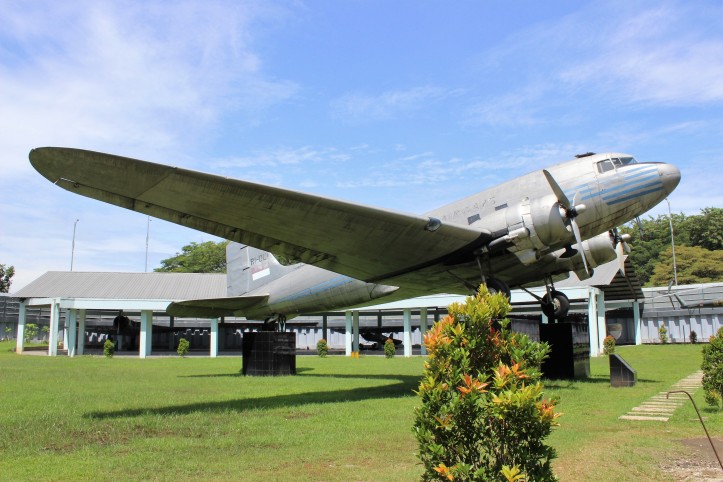
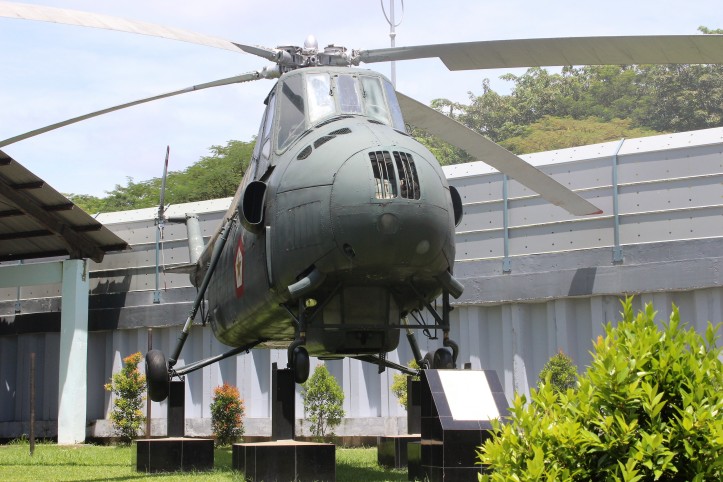
All nine birds in the two long angled sheds are largely propeller driven piston engine small crafts, most of which rare ones I have never heard of much less seen before. What a treat! The first plane is rather interesting as it was probably the only biplane ever operated by the Indonesian air Force or rather its precursor, the Indonesian People’s Security Force. Locally called the Cureng or Churen, this Yokosuka K5Y two-seat trainer sport a brace of 7.7mm guns; one each of forward and rear facing. It can also carry up to a 100kg bomb load on external racks. It had seen action against Dutch colonial forces during the War of Independence. ▼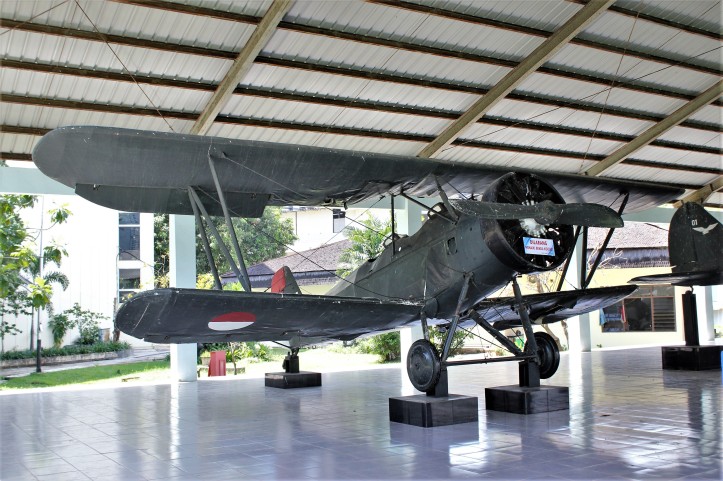
I haven’t been face-to-face with the famed Mitsubishi A6M Zero naval fighter yet but this comes close. The Nakajima Ki-43 Hayabusa or Oscar as nicknamed by the Allied Forces was the army version of the former, and bear more than a passing resemblance. It was also powered by basically the same Nakajima Sakae engine. Almost 6,000 units were built, slightly more than half that of Zeros. Anyway, the air force museum in Yogyakarta appear to have both on display so it won’t be long before I will get up close and personal with the A6M. Interestingly, the Oscar actually killed more Allied aircraft than any other Japanese combat plane, including the Zero. ▼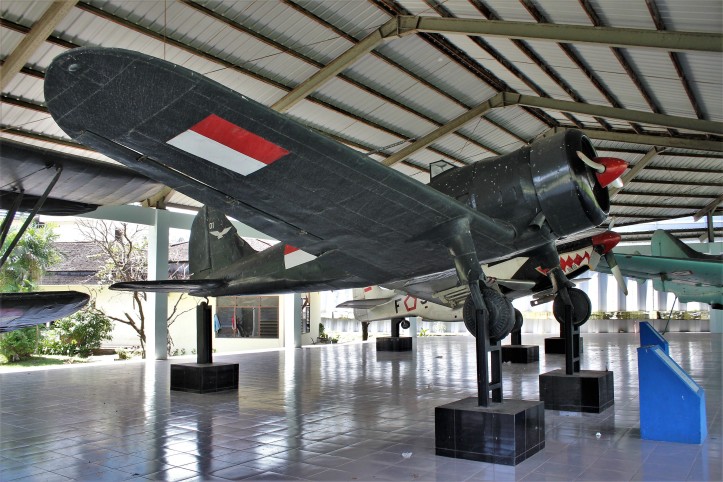
One of my all-time favorite planes is next in the line; a North American P-51 Mustang escort fighter. Among the most celebrated of WWII fighters, the Mustang was originally designed and built by the Americans for and to the requirement of the British Royal Air Force. The P-51 was so good that it shot down a number of the world’s first operational jet fighter, the Messerschmitt Me 262. One of those Mustang pilots was Chuck Yeager, then a USAAF lieutenant, who went on to become the first man to break the sound barrier. Mustangs also proved fast enough to exterminate the jet-powered V-1 flying bomb; the ancestor of modern day cruise missiles.
In 1949 Indonesia started to take over a good number P-51-Ds from the departing Dutch East Indies Air Force. From previously being used against them in the War of Independence, the Indonesians employed these combat planes to face the RAF, RAAF and RNZAF during the Confrontation. The example seen in this museum is actually one of six received in 1972/73 from the Cavalier Aircraft Corporation which rebuilt war surplus P-51s into updated Cavalier Mustang IIs. CAC started their Mustang refurbishing activities with conversions into civilian executive business aircraft seating two persons. About 300 hundred Mustangs of all types (out of over 15,000 built) have survived, more than half of which are still in flyable condition today. ▼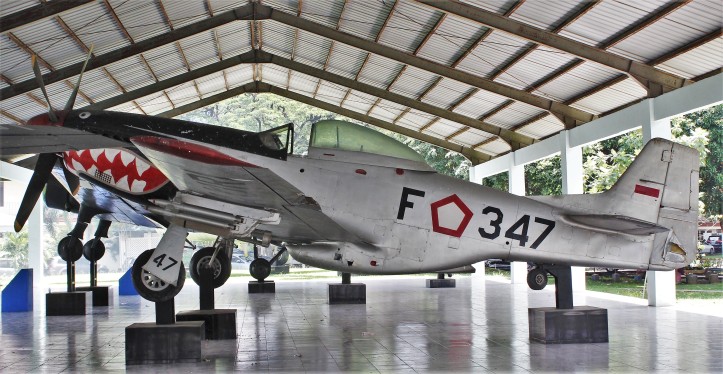
Ah, a British post-WWII prop warplane! Not common in that part of the world. The anti-submarine warfare and strike fighter Fairey Gannet has an unusual powerplant configuration. The two co-axial contra-rotating propellers were driven by two coupled side-by-side turboprop engines with a common gearbox. The double folding inverted gull wing look cool. The crew consists of a pilot and two observers; the second in a separate cockpit further aft along the fuselage. ▼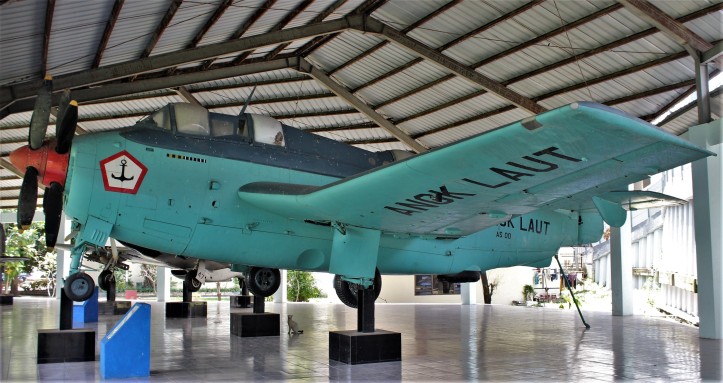
The Gannet with folded wings and exposed engines. Image sourced from Wikimedia Commons under free use license. Credit to Peter Ellis ▼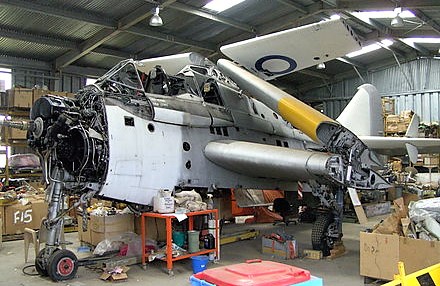
I was initially flummoxed by the plaque that says AT-16 Harvard with Pratt & Whitney Aircraft Corporation as the manufacturer. There is no such corporation. Now known simply as Pratt & Whitney with a number of business divisions, it is a subsidiary of United Technologies Corporation. It came into being in 1925 as the Pratt & Whitney Aircraft Company and is a manufacturer of aircraft engines, never aircraft itself. It supplied the P&W Wasp engine that powered the plane. As for the aircraft, it’s a North American T-6 Texan trainer, more popularly known by its British designation as just the Harvard. AT-6 is a variant, with the “AT” denoting Advanced Trainer. Besides being a popular performer at airshows, the Texan had appeared in many movies, usually as stand-ins for various aircraft types. It famously doubled for the Mitsubishi Zero in Tora! Tora! Tora! and The Final Countdown, among others. ▼
The Gelatik-C is a STOL utility aircraft licensed built in Indonesia by Nurtanio Aircraft industry, now known as Indonesia Aerospace, in Bandung. Designed and manufactured in Poland as the PZL-104 Wilga, the single engined four seater was in production from 1962 to 2006. It saw service mainly in civil aviation; for observation, agriculture, touring, bush flying, air ambulance and sporting activities such as parachuting and glider towing. ▼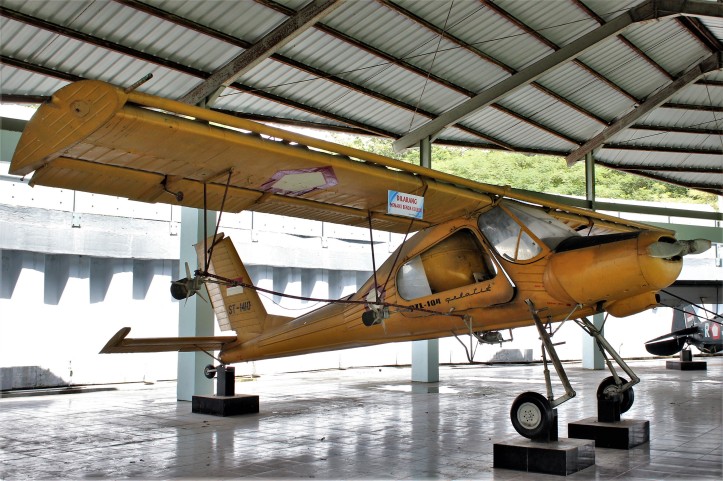
The Piper L-4J Grasshopper light observation and liaison aircraft is a follow-on to the Piper company’s successful J-3 Cub. This two-seater is also popular with flying training schools. ▼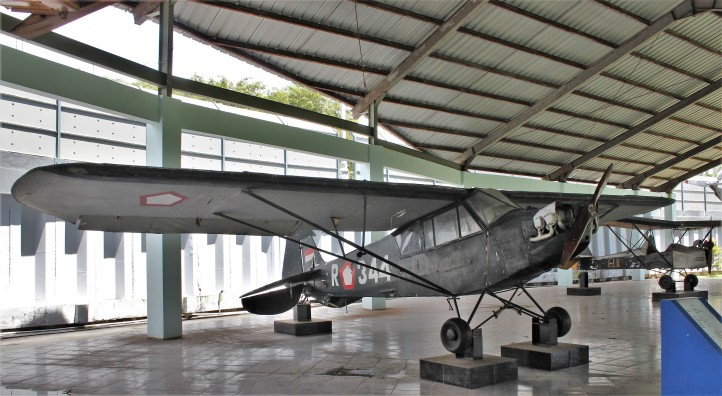
I’m not sure whether I’ll get this right but what I surmise is this Made in Indonesia WEL I RI X experimental singleton lightplane is supposedly powered by a 15 horsepower 2 cylinder 1928 Harley Davidson motorcycle engine. Seems two were built, the other with a Volkswagon engine. Replica? Maybe a translation issue. Oh, well. ▼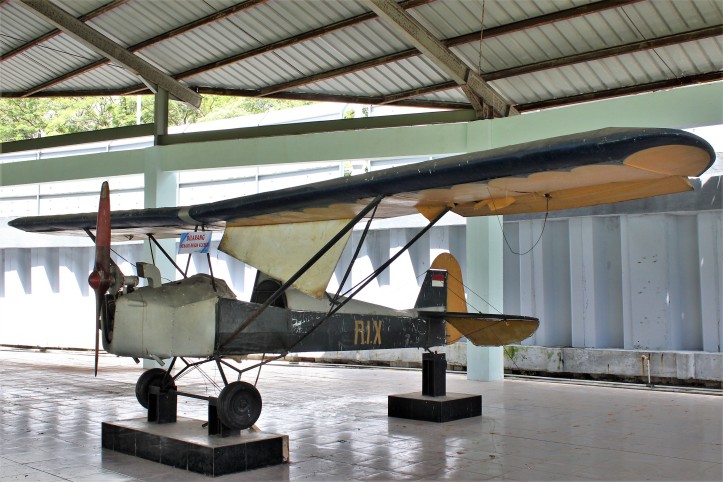
LIPNUR NU-25 Kunang (Firefly) single seat light aircraft. So this is a replica of the only example ever built and flown. Lipnur is a predecessor of Indonesia Aerospace and predates Nurtanio. There’s probably some confusion by whoever inscribed the information on the plaque. This plane is likely the NU-35, the second model with a more powerful 35 hp engine and was equipped with a canopy. Or there was just one aircraft all along, with the engine replaced, canopy added later on and model number changed? Well, I don’t intend to lose much sleep over it. ▼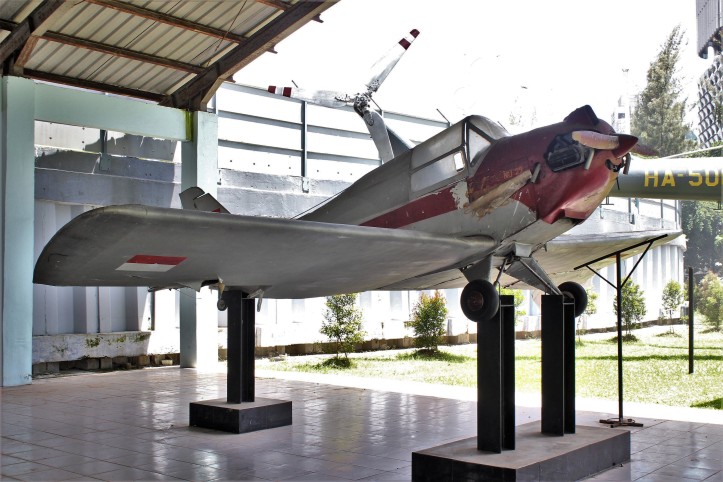
Since I am at it, let me slip in some pics of other Indonesian military related objects that don’t pique my attention. As the Indonesian Navy’s Jaguar class Motor Torpedo Boat lay just beside the Skyhawk, I simply activated my lazy finger to snap a shot of it. ▼
Also nearby; a 14 tons light tank M3 Stuart. ▼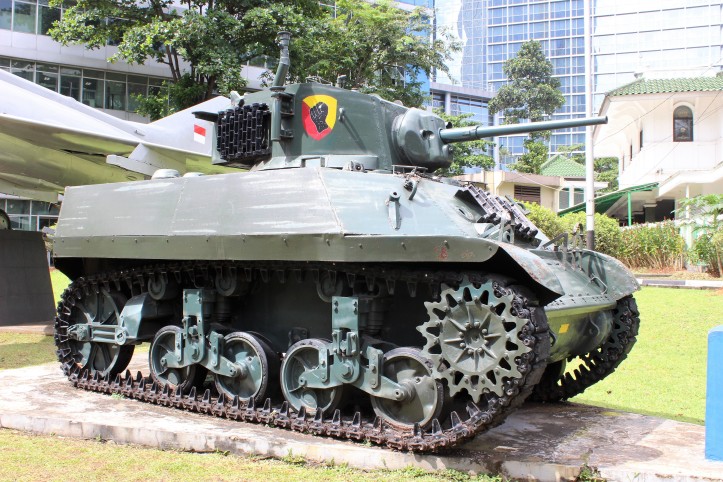
For the inflated 10,000 Rupiah entrance fee, I had decided to avail myself of the cooling air-conditioning for a while as a respite from the hot sun outside. Here’s one of the numerous glass-framed dioramas inside the building. It depicts Sukarno’s Proclamation of Independence on 17 August 1945. Pic taken at an angle to minimize reflections. ▼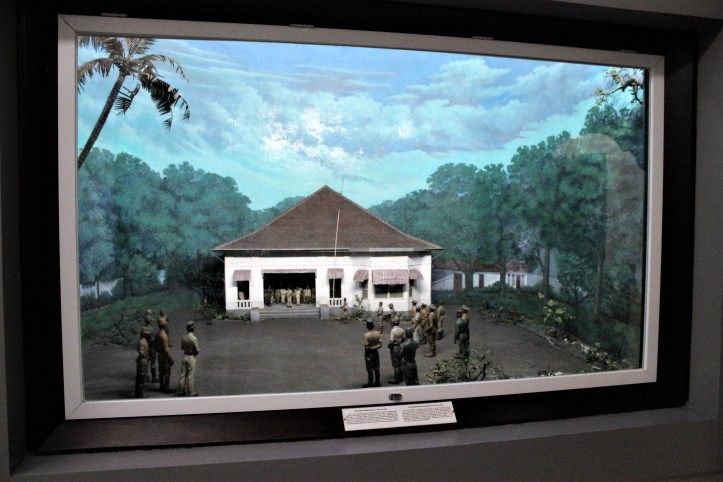
What’s this? A wood & wicker chair jury-rigged with fabric, bamboo poles and ropes to “shoulder-shuttle” “Great Commander” General Raden Soedirman, first commander-in-chief of the Indonesian Armed Force around in some measure of comfort during his inspection rounds? Would modern day Generals agree to be carried in such fashion? Health issues as the General suffered from tuberculosis in his later years? I don’t know! (Perhaps someone versed in the Indonesian language can discern something from the information board beside the display?) Besides, different eras beget dissimilar norms and practices. This highly respected National Hero sadly succumbed to his illness at the young age of 34. ▼ 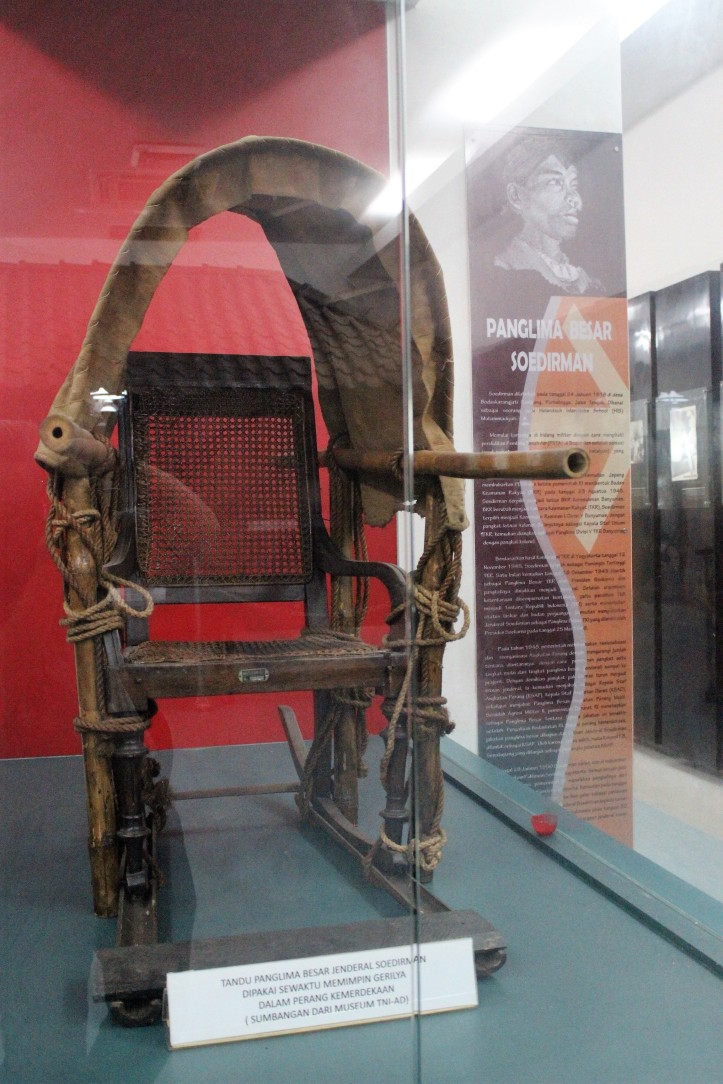
Bust of General Suharto. ▼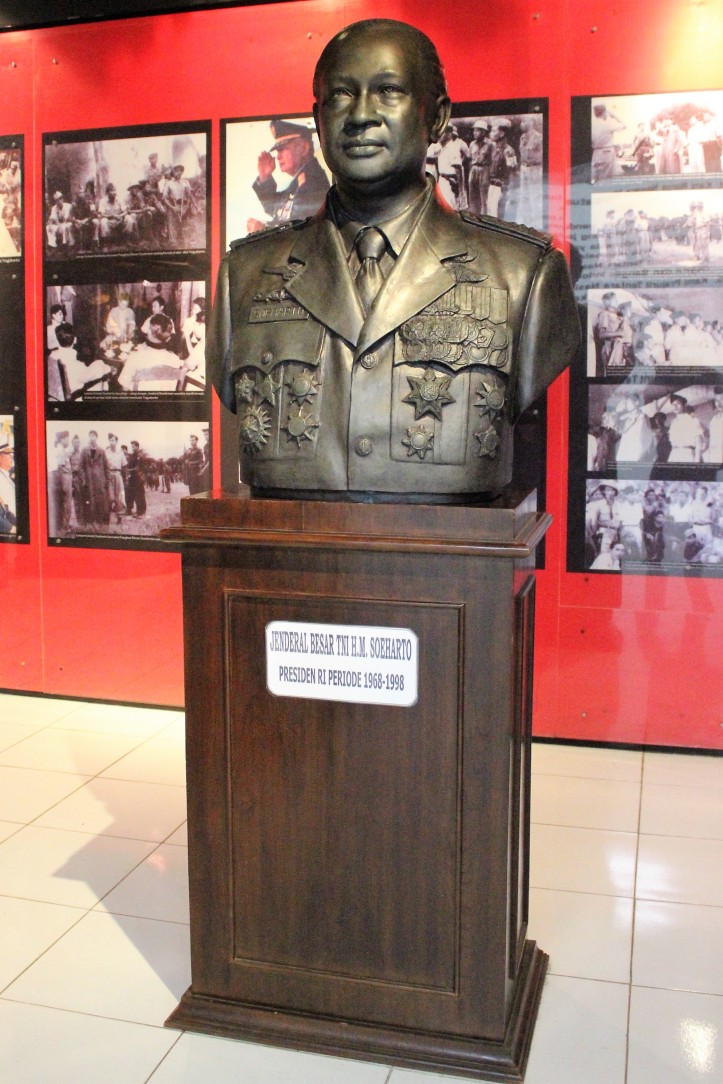
A couple of rusting torpedoes. ▼
to be continued… … Next up: mainly of Indo food.
@Flobs We married in ‘99. Went to Disneyland Paris (drove) earlier in the year and I had a plan. We’d agreed a corkage charge with the wedding venue, just needed the plonk. So, went to one of the monster Carafoure (spelling?) on the way home and actually bought a bottle of everything under about £8 and opened them all on the carpark. Somewhere I have a photograph of my UNO with about 40 open bottles on it. Tried them all, chose our 3 favs and bought many cases of each. Still have a white and a sparking left. Both vinegar now. Will open one on our 25th just for the fun of the event. Will dig out the photo, classic.
Part Two
Jakarta Armed Forces Museum
After a two and a half hour morning, it’s time for an early light lunch of chicken soto noodles and a bottle of coke, at the museum’s air-conditioned cafe, all for RP18,000. ▼
And a big seafood dinner by the sea at Seafood City in Pluit, with some friends in the evening. From top, counterclockwise: pepper Sri-Lankan crab, barbequed fish, oatmeal deep-fried prawns, chili crab, stir-fried sambal kangkong vegetable and deep fried squid rings on a weather-beaten table. ▼
After all that crab, hand washing is in order at the nearby sink with embedded little live fishes swimming around. ▼
My everytime-must-eat roadside snack: deep fried tofu cubes @ Rp4,500 (<SG$0.50) for 6 pieces. The other hawker doesn’t look too happy at being shot but a smile from me settles it. ▼

Other streetside stalls, and rows of motorbikes, common sights in Indonesia. ▼

Whenever I go to Jakarta, which at once or twice a year currently and a far cry from the monthly trips of the 90s & 00s, I put up at a friend’s condo at Seasons City. Situated midway between the city centre and the northern coast, the Busway stop for the Corridor 9 route a few steps away made it very convenient to move around. With their own dedicated lanes, the TransJakarta BRT system is faster than driving in the perennially gridlocked traffic. ▼


Daytime and late evening views from the 23rd floor unit where I stayed. ▼

Inside the mall itself is a cavernous kiddies amusement park of which this ferris wheel nestle in a corner, surrounded by “world-famous attractions” like the miniature Statute of Liberty and Leaning Tower of Pisa. ▼
Our Little Red Dot bade a tearful goodbye to the much-loved A&W fast food chain and its famed root beer in 2003 when its last outlet packed up after a 35-year presence. They found the going tough when the big boys (KFC & McDonald’s) muscled in. Their business is still striving in Indonesia though. Here’s one of their branches in Seasons City. ▼

the end… … … and coming up: return to Manila a year later; in 2018



